



We are building CultureStake, the world’s first collective cultural decision making app (using Quadratic Voting on the blockchain) because we want to enable all communities to choose the creative experiences they want to have in their own areas. The original idea was driven by an awareness that top down arts programming is increasingly problematic. We wanted to find a way to give more people more of a say in what art and culture gets produced in their neighbourhoods – and more opportunity to be the co-creators. In a nutshell, our mission is to put the public at the heart of public arts.
Communities
We want communities to explore and learn together what we all want to experience in our localities. For example how might a theatre audience cast a play differently or a park community curate a public art exhibition?
Cultural Organisations
We want deeper, richer and more open consultation with the communities cultural organisations work for. For example, how might a city council find out which new artwork should occupy a recently vacated public plinth. Or how might an arts organisation discover which artist on their shortlist should be next summer’s blockbuster?
For Everyone
We want a data commons that widens the conversation about how art is valued by different communities around the world. For example, how might our ideas about culture change if we can see what’s important to other people?
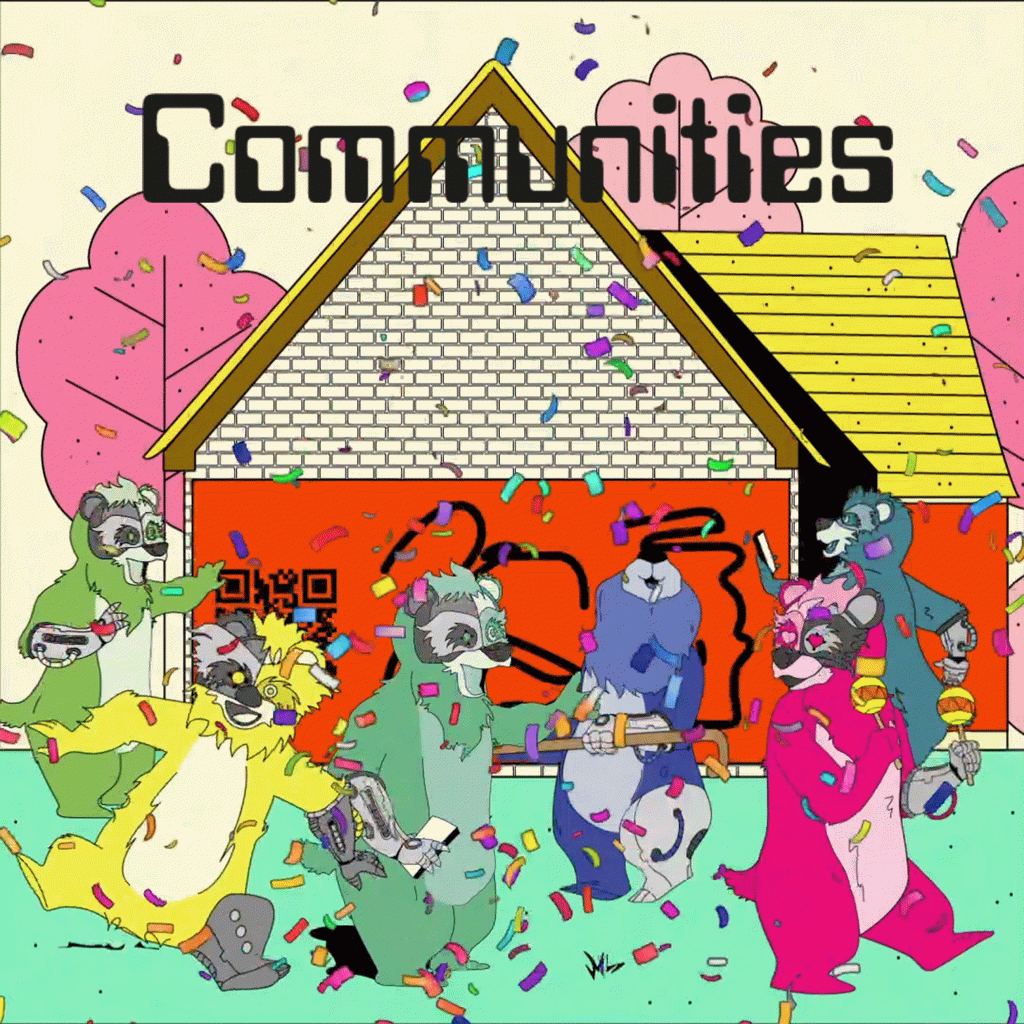
We are using Quadratic Voting because it takes us all from confusing numbers to nuanced feelings.
In QV voters receive a number of ‘vibe credits’ which they can allocate to different creative proposals to express their support. The quadratic function means that showing a strong preference comes at a credit cost. Or rather:
This means that QV is quite unlike any other voting process. Indeed, unlike a one person one vote system, in QV votes express not just what we care about but how much we care! This matters because one person one vote systems usually don’t present the reason why someone voted the way they did or how strongly they felt about it. Politics have taught us not to trust the way votes are interpreted. Voters’ intentions are often misrepresented and communities are polarised about the limited information. Whereas QV allows us to express the intensity of our convictions, giving each of us:
Plus we’ve designed CultureStake so vote organisers can weight the votes of those closest to the issues that matter. For example, in our use of CultureStake for the People’s Park Plinth, any votes cast inside Finsbury Park mean more overall. So those most affected get more of a say.
And we run all CultureStake votes on the blockchain because the blockchain is like a big indelible ledger. This means that a vote cannot be rigged and is always stored extra safely so what we can promise voters is that they can trust our system.
There are many ways to run a CultureStake vote. A theatre could develop an unfinished performance and ask communities to choose the next steps. An arts organisation might offer up a range of different events and invite communities to choose what they want to encounter. Either way, the voting system doesn’t rely on asking everyone to just pick their favourite, but rather explore their thoughts and feelings in relation to a set of questions. So the result is always knowing more about what communities think and feel. Plus, we never show what ranked 1st, 2nd, or 3rd, but rather what was selected and what thoughts and opinions drove people’s selections.
At Furtherfield we are using CultureStake to power our People’s Park Plinth initiative in Finsbury Park. The concept behind the People’s Park Plinth is that our Finsbury Park buildings and even the park itself will act as a plinth for public digital artworks chosen by our communities using our CultureStake app.
The Gallery building will therefore provide an interface where people can scan hoardings to access works which offer a range of XR-enabled experiences in the park. Annually there will be a set of ‘proposal’ artworks, which will give people a first glimpse at what can be created more fully later in the year. Everyone will have time to explore these proposals and then use CutlureStake to choose what they want.
In our pilot year we tripled local engagement and received amazing local feedback like this:
“I live nearby and I’ve been talking about this with my friends for months, it’s such a great idea, to give people a say!”
“[…]decentralisation allows people to have slower but more grassroots-based management of any decision making.”
“I think it’s good that we have a say as well. And I really love voting.”
“Usually I guess I choose art by going to a place and supporting it like that but I’ve never been involved so much in really deciding on what I will see next. And yeah it makes me actually feel good too.”
“[…] quite a lot of times actually […] art is reserved only for the higher echelons of society and I feel like this is really nice that anyone can come in and you vote for who you like or what art you like.”
“I do feel represented…”
We are now in the next phase of development and are actively looking for partners from different types of venues and communities to partner with us so we can explore their unique needs and ensure we have a robust system.
If you are a small, medium, large, networked, physical, touring, online or any other type of cultural entity that wants to deepen your community connections we would love to hear from you. We want to know how you would use CultureStake in your own context and what you would like to achieve. To find out more contact Charlotte and she’ll arrange a meet up.
Decentralised Autonomous Organisations (DAOs) offer unique tools for translocal peers to encode rules, relations and values into their joint ventures using blockchain technologies.
In recent years DAOs have been heralded as a powerful stimulus for reshaping how value systems for interdependence and cooperation manifest themselves in arts organising. Radical Friends. Decentralised Autonomous Organisations and the Arts consolidates five years of research into a toolkit for fierce thinking, as well as for new forms of radical care and connectivity that move beyond the established systems of centralised control in the art industry and wider financial networks.
At a time when so many are focused on NFTs, Radical Friends refocuses attention on DAOs as potentially the most radical blockchain-based technology for the arts in the long-term. Contributors engage both past and emergent methodologies for building resilient and mutable systems for mutual aid. Collectively, the book aims to evoke and conjure new imaginative communities, and to share the practices and blueprints that can help produce them.
Radical Friends includes contributions of essays, interviews, exercises, and prototypes from leading thinkers, artists and technologists across this emerging field. This book, follows Furtherfield and Torque Editions ground-breaking book Artists Re:Thinking the Blockchain.
Editors
Ruth Catlow & Penny Rafferty
Contributors
Ramon Amaro, Calum Bowden, Jaya Klara Brekke, Mitchell F. Chan, Cade Diehm, eeefff, Carina Erdmann, Primavera De Filippi, Charlotte Frost, Max Hampshire, Lucile Olympe Haute, Sara Heitlinger, Lara Houston, Cadence Kinsey, Nick Koppenhagen, Kei Kreutler, Laura Lotti, Jonas Lund, Massimiliano Mollona, MetaObjects, Rhea Myers, Omsk Social Club, Bhavisha Panchia, Legacy Russell, Tina Rivers Ryan, Nathan Schneider, Sam Skinner, Sam Spike, Hito Steyerl, Alex S. Taylor, Cassie Thornton, Suzanne Treister, Stacco Troncoso, Ann Marie Utratel, Samson Young
Publishers
Torque Editions
Design
Mark Simmonds
Cover and Inside Illustrations
Marijn Degenaar
“Radical Friends is an urgent book for the 21st Century and beyond. It shows us, in the spirit of the legendary poet and artist Etel Adnan, that the technology of the future needs to be about “togetherness, not separation. Love, not suspicion. A common future, not isolation.”
Hans Ulrich Obrist“How things are run is often more important than what is done. It may not be easy to establish alternative formats and infrastructures, but it’s certainly necessary… This collection shows that it is possible too.”
Sadie Plant“This book is about friendship, despair and hope — a beautiful, must-read for all people who are asking unanswerable questions about life, love and the end of the world.”
Franco “Bifo” Beradi“Web 3 diagonalises the principles of Web 1 and Web 2. Binaries are dead. Everything is both good and evil, emancipatory and oppressive, singular and infinitely replicable. Radical Friends navigates this confusing new terrain in a nuanced and accessible way that is liable to make you feel excited about the future of art, politics, and maybe even the world again.”
Amy Ireland“An instant seminal compendium for people who want to gain a deeper understanding of the radical potential of crypto tech for aesthetic institutions.”
Harm van den Dorpel
Join the discussion on Discord and share your questions with the speakers.
The Radical Friends Symposium discusses the value of and presents pathways to peer-produced decentralised digital infrastructures for art, culture and society – in particular through Decentralised Autonomous Organisations (DAOs) for the cultural sector. The symposium takes as its inspiration the defining principles of friendship – sustained intimacy, fellowship and camaraderie – which, when applied to complex difficulties (particularly those that might otherwise be invisible to us), offers excellent design patterns for social infrastructure. To end gatekeeping and elitism in the artworld we therefore bring this spirit of deep and radical friendship as a way to build resilient and mutable systems for scale-free interdependence and mutual aid.
DAOs provide new digital governance infrastructures that allow people to pool resources, exchange economic value, and form joint-ventures, that defy national borders. DAOs enable people to agree on how risks and rewards should be distributed and to reap the benefits (or otherwise) of a shared activity now and in the future.
At a time when the mainstream artworld is focused on the personal wealth that can be amassed through NFTs, artworld DAOs offer the potential to diversify collaboration and to lower the cost of translocal self-organising, leading to new visions, vehicles and configurations for communally grounded projects. The open source artworld DAOs we do (and don’t) build now will have direct consequences for who owns the future and decides what this means for others.
So gather up your radical friends and grab your tickets for an expansive 8-hour program that includes: lectures; panel discussions; concerts; as well as hybrid talk and body-work formats. Throughout the event, participants are invited to analyse, discuss, and map the obstacles, opportunities, and implications of progressive, decentralised organisations and automation in the artworld. Plus, watch out for 4 prototype DAOs that will be unveiled during proceedings and take part in collectively awarding a 10,000 EURO development grant funded by the Goethe-Institut to 1 of them.
The Radical Friends Symposium is curated by Ruth Catlow (Furtherfield) and Penny Rafferty in dialogue with Sarah Johanna Theurer and Julia Pfeiffer (Haus Der Kunst, Munich). Participants include James Whipple (aka / M.E.S.H.), OMSK Social Club, Jaya Klara Brekke, Harm Van Den Dorpel, Cem Dagdelen, Aude Launay, Sarah Friend, Laura Lotti and Calum Bowden (Black Swan), Bhavisha Panchia and Carly Whitaker (Covalence Studios), Nicolay Spesivtsev and Dzina Zhuk (eeefff) and Massimiliano Mollona alongside Samson Young (Ensembl).
Radical Friends presents results from the DAOWO (Decentralised Autonomous Organisations with Others) project, co-founded by the Goethe-Institut London and Furtherfield with the support of Serpentine Galleries. The award-winning DAOWO is a transnational collaborative network that has been bringing together leading international institutions and communities from the arts and technology for three years to question the advantages and disadvantages of blockchain technologies for art, culture and society from a local perspective. The summit is part of the Goethe-Institut project “Lockdown Lessons”. It searches for answers on what can be learned from the Covid-19 crisis on a global scale concerning social, technological, postcolonial and civil society concerns.
Discover a new set of experimental projects to reinvent the future of arts with blockchain.
The Goethe-Institut London, Furtherfield and the Serpentine Galleries present The DAOWO Sessions, a new series of online events running from 28th January to 4th March 2021. The series explores the possibilities for the future of the artworld with blockchain by investigating what can be learned from DAOs (Decentralised Autonomous Organisations) working with Others (-WO). Each session is an eye-opening presentation and conversation around active experimentation that aims to hack, deconstruct and reinvent the arts in the emerging crypto space in response to people and their local contexts. This is a unique opportunity for cultural practitioners, representatives of arts, technology organisations, communities and anyone interested in the potential of blockchain to come together and question the future of art and society.
Curated by Ruth Catlow (artistic director Furtherfield), Penny Rafferty (writer and researcher) and Ben Vickers (CTO Serpentine Galleries) with the Goethe-Institut London, each event introduces one of five new progressive blockchain art prototypes created by DAO teams in Berlin, Hong Kong, Johannesburg and Minsk. Through live video conference, the teams will introduce their prototypes and address key questions about the potential of blockchain systems to decentralise power structures and to rewire the arts. The final session brings together the DAOWO curators in conversation with art critic Francesca Gavin.
The DAOWO Sessions are part of the award-winning blockchain programme for reinventing the arts, the DAOWO initiative, a partnership between the Goethe-Institut London, Furtherfield/DECAL and Serpentine Galleries.
All events take place at 9.00am GMT and are free to access with booking required.
(Video Broadcast in English, BSL interpretation)
For full event information and tickets please visit: goethe.de/daowo
Events and Dates:
28 Jan 2021 | BLACK SWAN DAO (Berlin)
The first event connects with Berlin to introduce BLACK SWAN DAO (Trust), an experimental initiative which responds to the increasing precarisation of cultural labour by providing cultural practitioners with tools to collaboratively organise and share resources.
4 Feb 2021 | COVALENCE STUDIO (Johannesburg)
This event connects with Johannesburg’s DAO (Covalence Studio) to introduce a network of resources, skills and support for artists and creative practitioners with the goal to rethink equitable artistic practices that can thrive under restricted movements and collapsing economic infrastructures.
11 Feb 2021 | DAO AS CHIMERA (Minsk)
Speculating on future histories of blockchains, Minsk-based initiative DAO AS CHIMERA is a unique network and a live action role play. The project aims to provide a view on the cultural, tech and start-up sphere in Belarus and to unpack emancipatory potentialities of collectivities freed from the constraints of project-orientation.
25 Feb 2021 | ENSEMBL (Hong Kong)
An Ethereum-based platform for decentralised organising of artistic production. The project explores how can DAOs learn from improvised music about value and temporally dynamic collaborations? What’s the “Score”?
4 Mar 2021 | The Machine to Eat the Artworld (online)
A conversation with the curators of the Artworld DAO think tank and the DAOWO programme, Ruth Catlow and Penny Rafferty interviewed by curator and writer Francesca Gavin. Catlow brings 25 years of experience as a curator, artist, and researcher exploring the intersection of arts and technology, emerging practices in art, decentralised technologies and the blockchain, alongside Berlin-based writer and visual theorist.
For full event information and tickets please visit: goethe.de/daowo
Please DONATE to CultureStake by participating in the Gitcoin CLR matching experiment for funding public goods.
Your donation goes a LONG way!
Using quadratic voting on the blockchain, CultureStake’s playful front-end interface allows everyone to vote on the types of cultural activity they would like to see in their locality.
CultureStake democratises arts commissioning by providing communities and artists with a way to make cultural decisions together. It does this by giving communities a bigger say in the activities provided in their area, and by connecting artists and cultural organisations to better information about what is meaningful in different localities.
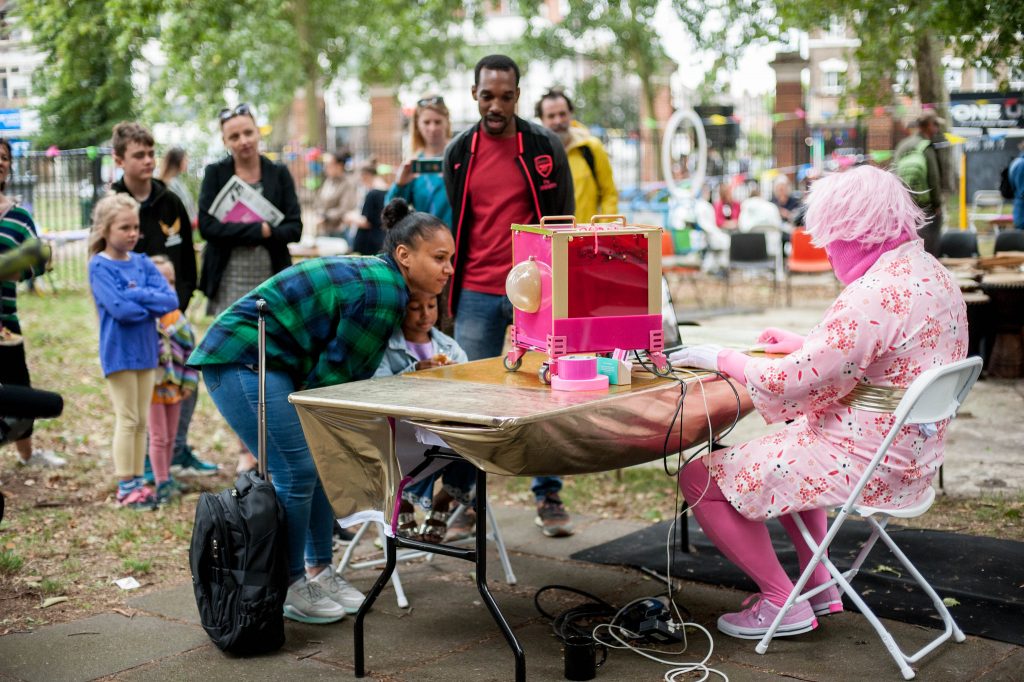
Using the CultureStake app, people are invited to consider the social and cultural relevance of particular artworks to their localities. And they are given a way to rank how strongly they feel about artworks and the issues they raise. Votes are tracked and made visible, giving evidence of the types of projects communities would most value.
Currently, major artists and cultural sponsors have the upper hand and this can result in one-size-fits-all ‘blockbuster’ programming. CultureStake is a practical response to a growing demand for greater transparency about how, and in whose interest, decisions about the public good are made. It opens the field for experimentation, for robust and sustainable alternatives to centralised and private decision-making practices.
The ultimate vision for CultureStake is that governance and funding of culture are put into the hands of audiences, artists and venues, acting together in and across localities and time.
In this way, we hope to increase a shared sense of agency, imagination, and alliances.
The CultureStake pilot is commissioned by the Leeds International Festival 2020 as part of Furtherfield’s Future Fairness. This is a family-friendly fair of art and technology activities to examine the future of the world we live in, and to invite participants to choose what they want to see in Leeds in the future.
Using the CultureStake voting app they will decide together which project they would like to see commissioned on a larger scale in Leeds.
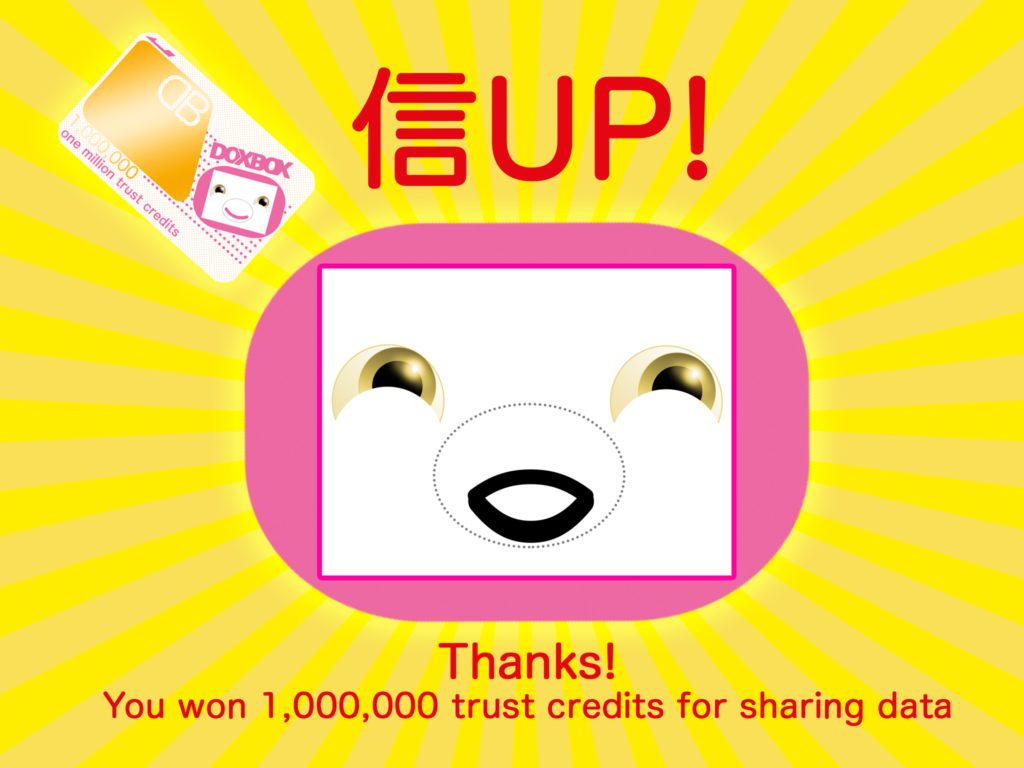
Quadratic voting (QV) was developed as an improvement on one-person-one-vote collective decision-making processes. It attempts to address the associated “tyranny of the majority” problems and data loss about voter intentions (so well understood by Post Brexit citizens of the UK).
The significance of election and referenda results are dangerously open to interpretation and manipulation by authorities. By providing more information QV has the potential to allow communities of people to better understand what vote results say about their values and intentions.
All participants receive the same limited number of voting credits that they can distribute to express nuanced preferences. For this reason, voters only use their voting credits on things that matter to them. The quadratic system also enables participants to express the intensity of their preferences for all options, but it costs them proportionately (quadratically) more credits to express strong feelings. (See table)

The CultureStake system will store voting data about each artwork on the Ethereum blockchain (a cryptographically secured distributed database) to guarantee ongoing access to tamper-proof public data.
CultureStake tests the ability of QV on the blockchain to produce trusted voting data – secure, transparent, and permanent – about culture experienced in places.
> Voting creates communally-owned information about what matters to people on the culture that happens in places.
> Voting contributes to shared knowledge about collective preferences, attitudes, and values.
CultureStake Software is published under a GNU Affero General Public License v3.0 AGPL-3.0
Main Repository URL: https://github.com/lazaruslabs/culturestake
Smart Contracts Repository URL: https://github.com/lazaruslabs/culturestake-contracts
Subgraph Repository URL: https://github.com/lazaruslabs/culturestake-subgraph
Infrastructure Provisioning URL: https://github.com/lazaruslabs/culturestake-provisioning
CultureStake is a DECAL/Furtherfield project.
Concept by Ruth Catlow, Charlotte Frost & Marc Garrett. Contributions by Sam Hart, Irene Lopez de Vallejo, Gretta Louw, Rhea Myers, Stacco Troncoso, and Ann Marie Utratel.
Technical development by Sarah Friend & Andreas Dzialocha.
Visual identity by Studio Hyte
Interview by Ruth Catlow
Transcribed by Anna Monkman
Ingrid LaFleur is on a mission to ensure “equal distribution of the future”. The curator of Manifest Destiny in Detroit, she also recently stood for mayor with an Afrofuturist manifesto.
Detroit has long played a critical role in the history of ‘domestic and global labor struggles.’
And now its quest for social justice has an avant-entrepreneurial dynamic, working across art, politics and technology. Activists respond to the city’s (often highly racialised) political failures to provide basic utilities with impressive social innovation. The recent boot-strapping community mesh networks for instance, was a response to the fact that 40 percent of Detroit residents have no access to the Internet at all. The alliances and networks formed in this project are now providing the social grounding for peer-to-peer technical education and experimentation with emerging decentralisation technologies. DACTROIT (an EOS project) is now exploring how payment for this infrastructure might be made through a community token.
I first interviewed LaFleur in July shortly before Detroit Art Week and the opening of Manifest Destiny at Library Street Collective Gallery.
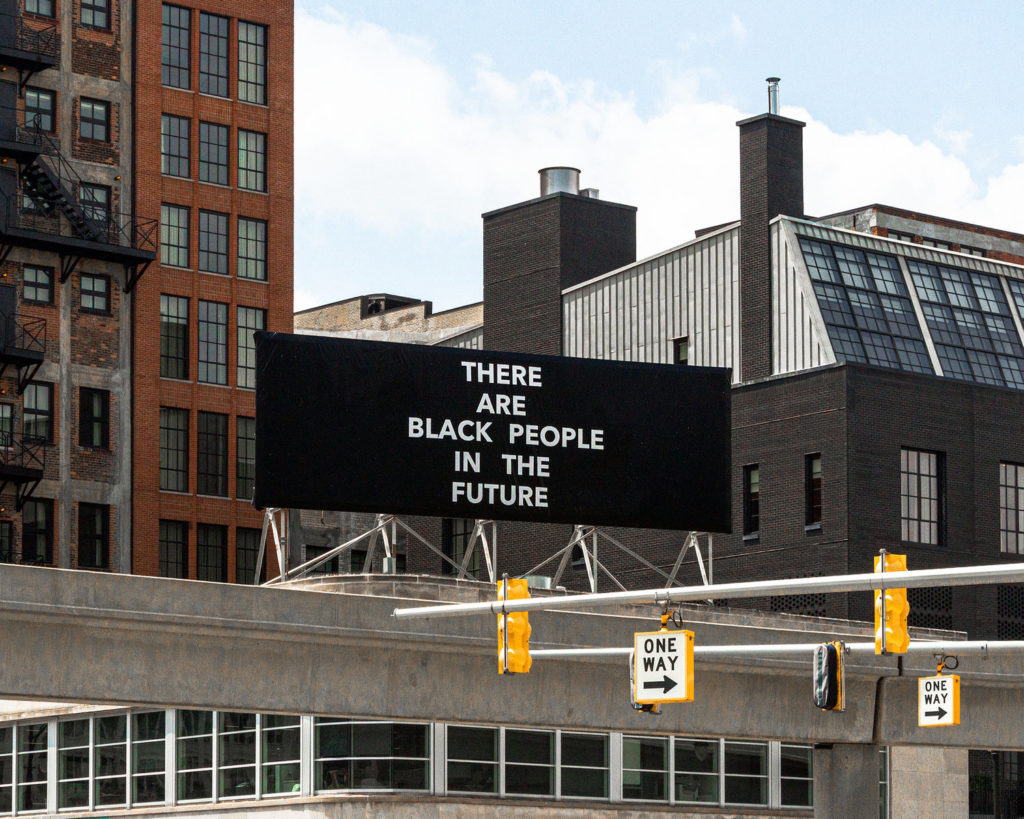
Ruth Catlow: I have wanted to talk with you for a while about your current curatorial work. But first I think it’s worth noting that we share a number of unusual preoccupations. We are both inspired by the social justice sci-fi of Octavia E Butler; we root our work in locality; and have experimented with blockchain technologies as a site for artistic experimentation and social change. I have not however, stood for mayor. You have, and we will come to that later.
Please can you start by telling us about your exhibition Manifest Destiny.
Ingrid LaFleur: I only curate once every two or three years, almost like a museum curator. Manifest Destiny is a culmination of things that I have been thinking about for a while. Working across art and blockchain technology I’ve been very action-oriented thinking about what we need to be implementing, learning, adapting, innovating, in order to basically get free – that’s the whole point of my work.
I’m constantly trying to figure out how Black bodies can be free, which means I really need everyone to be free. And so I’m constantly unpacking, dissecting Afrofuturism as a framework or launchpad. I’m working to see what I’m missing, where are the gaps and how can I fill them in so that we can then make pathways forward and develop the futures that we really want to see. The exhibition title comes from this work.
I wanted to look at this in an abstract way. For instance, the painting series by Satch Hoyt, The Course of Stars of the Sirius System, are illustrating the star Sirius constellation, ground us in an ancient history which I think is very important as we plan and create these processes for manifestation. Satch Hoyt’s painting, Afro-Sonic Map (Black Mapping), is looking at how sound has been cultivated and informed by the different places through which it has travelled. And I’m pulling this interpretation out, because I believe that as we are imagining our destinies we have to be grounded in ancestral wisdom and Afro-Sonic Map (Black Mapping) reminds us of that ancestor from which the sounds are coming… But how they’ve also been wonderfully altered and transformed as a result of coming in contact with different realities – meaning that different times and history have informed the music, have informed how we are communicating sonically.
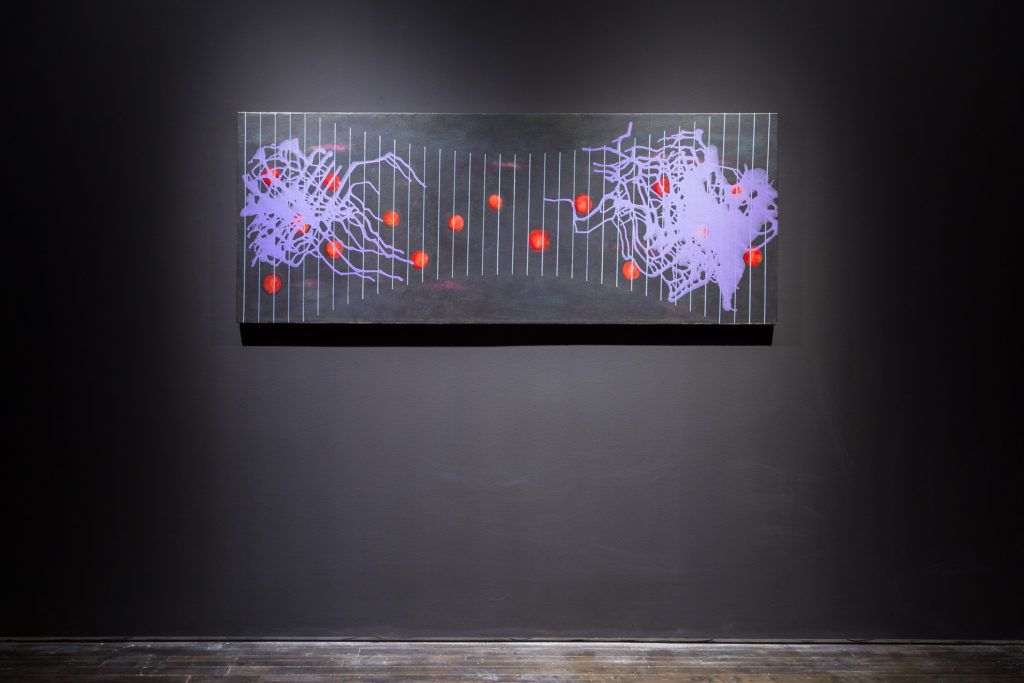
So this is a type of time travel, but it is not just time, it is realities, places and environments and all of these things that inform the work and how there is still always this thread that can always lead back to the original.
And in speaking of the original, the exhibition begins with an Afrofuturist boutique called DINKINESH. I created it because I really wanted to be able to provide items that were affordable and Afrofuturistic. One of the issues that I am having especially when it comes to Afrofuturist imagery is that it is very digital. I am here to bring it out into a physical space and make it both portable and affordable so then people can have it in their homes, place of work, wherever in the physical realm. The whole purpose of Afrofuturism is to shift consciousness and so I want it to be as available as possible. DINKINESH means “you are marvelous” and it is the name that was given to the oldest human remains found thus far, and they were found in Ethiopia. So this store is greeting you, it’s welcoming you into this space, but it’s also a gentle reminder that we all come from this one woman who is in, what we call now, Africa. And we are united by her. So DINKINESH initially will have this Afrofuturistic focus but over time it will grow to include Chicanofuturism and Indofuturism and all the futurisms of Black bodied and Brown bodied people. I am working on the boutique with Utē Petit who is based in New Orleans but from Detroit. He is designing the space and he is using imagery of flora from the Ethiopian region where Dinkinesh was found. The flora has been woven into the wallpaper for the space, so that is really exciting. I am very excited about DINKINESH.
RC: So people will be able to buy Afrofuturist art in the boutique.
ILF: Yes, like digital prints
RC: And will they be buying work that relates to work across the whole show?
ILF: Not really. Some of the artists will have products in the store like zines, hand-printed bags, but they were curated separately from the exhibition.
RC: This is work produced by just one artist or a group of people?
ILF: It’s literally like a retail store so it is work by a lot of different people. It’s like a museum store so it’s a lot of different people from all over. I am basically trying to gather it all together into one space. We don’t currently have one physical store to go and buy Afrofuturist anything.
RC: Wow! How have you sourced all of this? Is it all Afrofuturist art?
IF: Yeah, it’s a combination of people that I have been following online, or different groups that I have heard about, some of my friends might have items that I like, I know some of the artists personally, so it’s a variety of things. It is great, it is exciting, and slightly overwhelming- because it will keep going. To live on, beyond this exhibition.
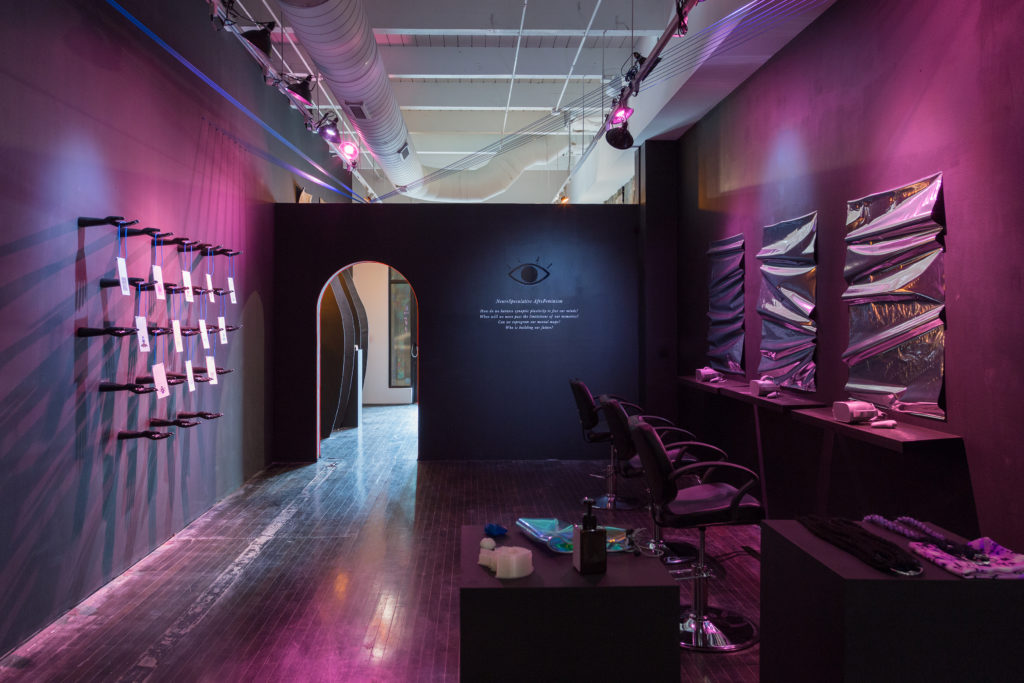
RC: How will it live on afterwards?
ILF: We’re going to be popping up in different places, I can’t announce it yet. I imagine that each place will offer different kinds of experiences. There will be some augmented reality involved in this iteration. I want to grow that, and expand into virtual reality experiences.
RC: I can see why that would be a bit daunting, because if it’s a boutique and people will be buying things it means you will need to keep it stocked.
ILF: It’s a real store!
RC: And are you selling things on the blockchain?
ILF: That might become complicated. But eventually I do want to accept crypto once I find a point of sale system I feel comfortable with. But first, right now, I just need to understand what it means to have a retail space.
RC: To come back to Manifest Destiny, Can you tell us a little bit about the title of the exhibition? What’s the context and significance of Manifest Destiny as a phrase or as a name?
ILF: I am looking at what does it take to manifest one’s destiny. So as I mentioned before, the guidance of ancestral wisdom is really important, otherwise the possibilities of the past become inaccessible in the present. I’ve also learned, as we move into working with new technologies like blockchain, and the philosophies that are behind it, and becoming more familiar with the tech industry in general, how important it is that the planning phase should be a heart-led process. We can see how a person’s perspective is really going to affect the tech and how it interacts with the world and so I’ve become very sensitive to how we’re planning and approaching a thing in order to manifest it.
And then finally there are the tools to make the physical thing and that’s when I get really excited. Implementation.
RC: OK So can you talk me through the exhibition?
ILF: Yes, so it starts off with DINKINESH. Then it goes into Hyphen Labs’s NeuroSpeculative AfroFeminism project which recreates a Black hair salon where you are getting your brain optimised. This is like that beginning process. And I think of the optimisation process as a way of decolonising because you don’t want to plan something that is a result of a colonised, limiting, narrow kind of perspective that is really based on someone else’s agenda. So you want to clear that and clean that up. Then Satch Hoyt’s beautiful paintings, Afro-Sonic Map (Black Mapping) and The Course of the Stars of the Sirius System. These give a reminder of the foundation of histories and ancient ancestral lineage. Then Alisha B. Wormsley created this really wonderful installation that is connecting the two gallery spaces. We also have her billboard that is placed outside of the gallery space above a bar right by public transportation, that says ‘There Are Black People In The Future’. I’m really excited about that because downtown Detroit has become 90% white even though the city is 85% Black so it’s like a little colony. The billboard is disrupting that space.

In the second gallery we have Maikoiyo Alley-Barnes has created a black and white film called Sacred, which is accompanied by a gorgeous sound that creates an ethereal multi-reality. Sacred is hard to talk about without giving away the mystery that’s embedded in it, but the thing that is sacred, you come to understand is sacred to us all. He has also created two sculptures that expresses the continuum that is necessary for the evolution of the future. And then there is Jasmine Murrell who created a collage tapestry, one of them titled Walking Time Travelers: Future will remind you of what is most important, what was lost, what was stolen, and what can never be replaced. Jasmine also created a deconstructed sculptures of hands that are coming through from a different reality.
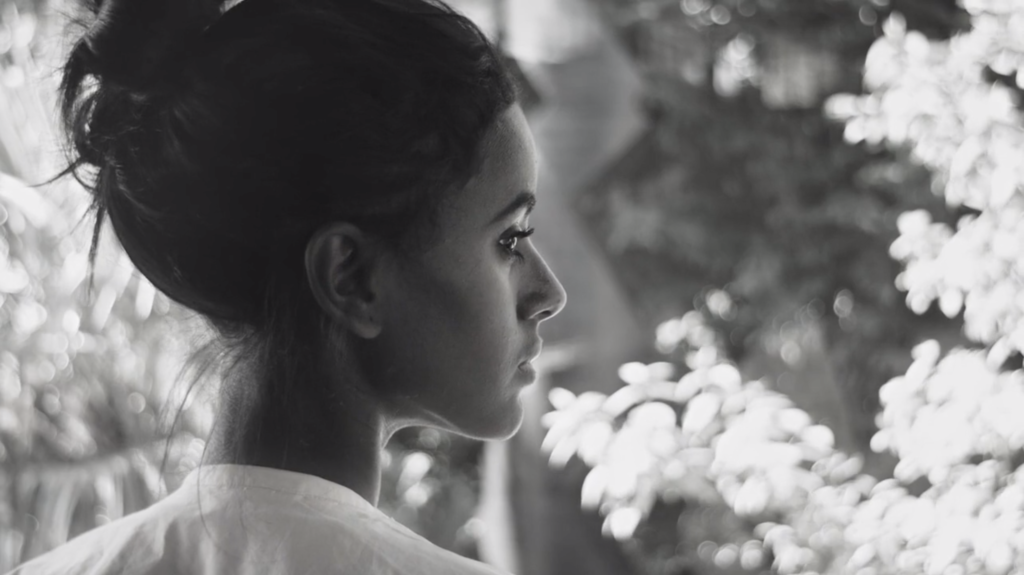
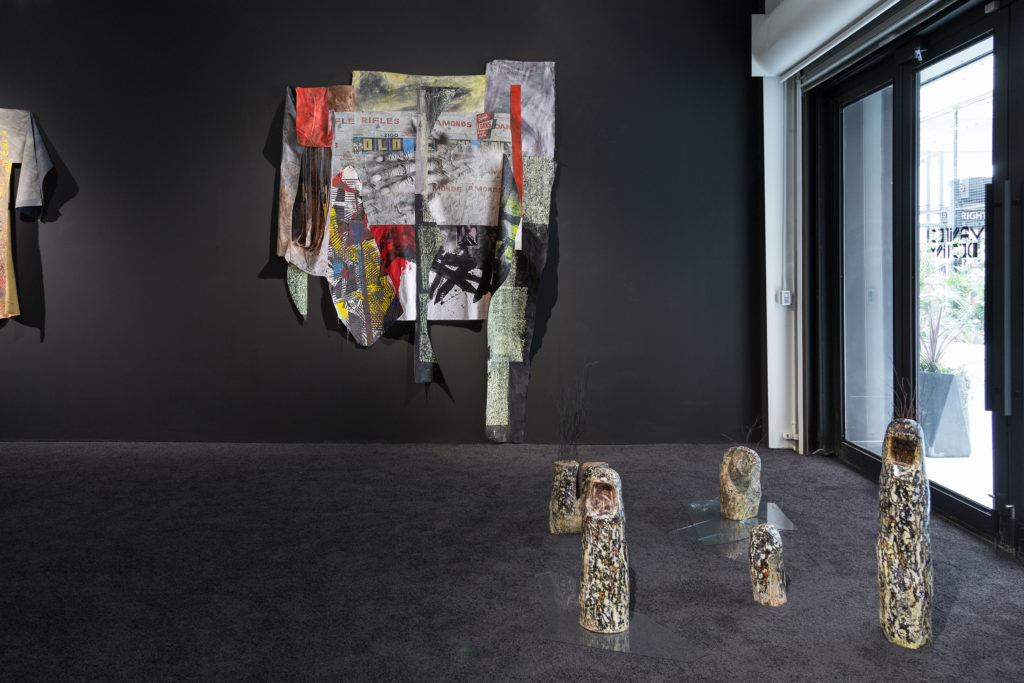
That second gallery space opens up to an alleyway that has been fully renovated where there are clubs and restaurants and bars and all types of artwork, there will be five very large panels that will have augmented reality artwork. This work is coming from the Digitalia exhibition that was shown in San Francisco at the Museum of the African Diaspora, MoAD. I was such a fan of the exhibit that I invited Lady PheOnix who is the curator of Digitalia to travel a portion of the exhibition to Detroit. I was able to choose some images from that exhibition that is on display in the alleyway called The Belt. It will be up for a year. I’m very excited about this because not everybody is going to walk into the gallery space so this is a way of making the afrofuture a little more public, also because augmented reality is participatory it’s a fun activity that everyone can enjoy. For many this will be their first introduction to AR.
The last component of Manifest Destiny is the skills training through a series of workshops. The workshop programme includes a talk by Rasheedah Phillips who is known for her theoretical work on quantum futurism. The Black School reimagines the art school into a Black art school taught participants about ancient architectural techniques and fractals and then as a group built a pyramid. Creative technologist Onyx Ashanti held a 3-D printing workshop. And I gave a workshop on decentralizing power and new economies. The programme ends with DC comics writer Tony Patrick who led us into a worldbuild session over three days. We developed a vision for Detroit in 2040 that will become a comic and eventually a virtual reality experience.
RC: It sounds just amazing! Like there are a lot of different ways in for different kinds of people. How much do you think or care about who this is for and how they find out about it, and also what their experience of it is.
ILF: This show is literally for Detroiters. I am constantly thinking about the exhibitions, the materials, the exposure, making sure that Detroiters have exposure to what is happening in the entire world and I really don’t care if you have never been to a museum or if you go all the time. Most of my work has been directed towards people who might be in-between. They like art and are curious but maybe they are not going to gallery exhibitions all the time or following museum shows. I am very much aware that the gallery space is on the alleyway, The Belt, which is party central for downtown, day and night in the summer. What I love is part of the exhibition in the gallery is visible in The Belt because one of the walls is all window. Downtown attracts all kinds of people, definitely people who have probably not experienced as much artwork by Black artists in their life and who might be a little afraid of Black bodies and hopefully they can develop a new relationship based on this show.
I’m very clear with artists about where they are showing, the politics of what’s going on and who’s going to come through those doors, because some artists might be sensitive to this. Some artists might want to engage in a very particular way as a result. One artist wanted to do something a little more artistic that would work in MOMA, and I was there with him, I got it, but I was like, I just want you to understand that the people who are going to come through these doors have been day drinking. They are going to be in shorts and flip flops, like ‘oh this looks cool’ and ‘oh this is great’ and within minutes they are gone. To help ease people into the space I asked for black carpeting on the floor because I want people to pause when they enter, I want the hushness when you come in so you are a little more reflective. This did happen but also what I did not expect is how people then felt comfortable to sit and chat on the carpeted floor. That warmed my heart. I love when a traditionally austre space becomes an inviting one.
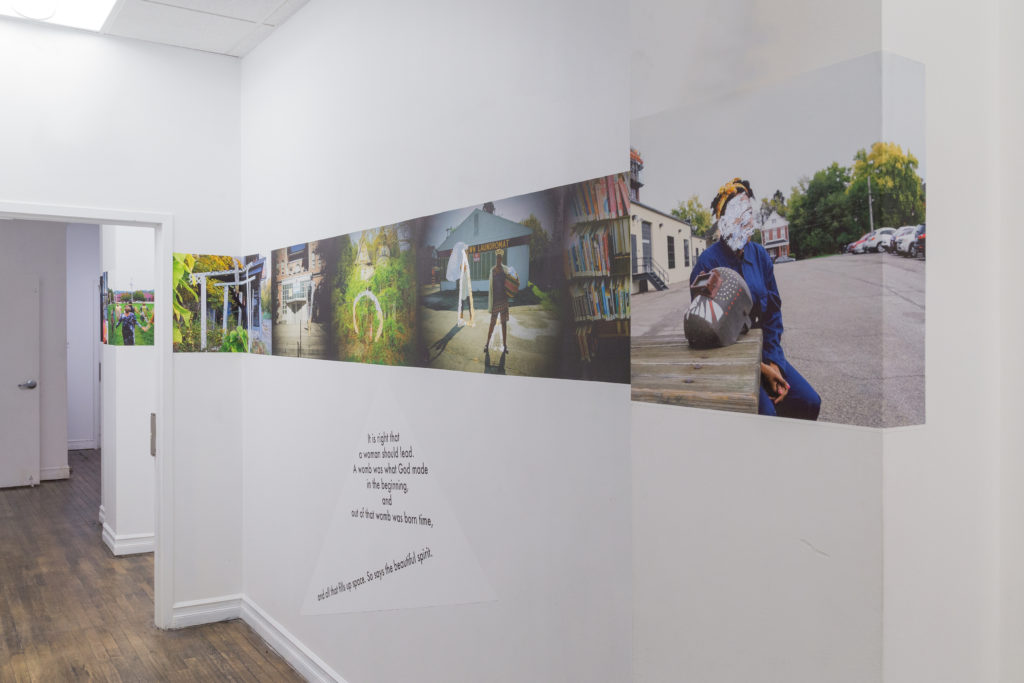
RC: So we run a gallery in the heart of a public park in North London, so we also get the day drinkers, and we also welcome the day drinkers! So it’s interesting to hear you talk about this.
RC: Given that Furtherfield has a readership from all over the world, I imagine that many people will not really have a sense of Detroit. So it would be great to hear you talk about why it’s important to you that this is happening in Detroit. And why Detroit?
ILF: Detroit is going through a major transformation, and some of us are in the midst of it, some of us are making it happen, and then some of us are running behind watching it happen and trying to figure out where we fit in. There is really no reason to leave anyone behind. It’s a critical moment because we are getting an influx of white people moving into a majority Black city. White people in the United States of America are not used to being minorities. Being a minority in their minds mean they have less power. It seems like they are saying to themselves, ‘I’m not used to being the only white person in a room so I’m going to stick with all the gentrified places where I remain majority in the room and I feel safer, more comfortable’. But what that means is that they are still not confronting their fear of Black people so it’s like they’ve decided to live in a tiny hut in a big forest and won’t explore the forest even though it offers new insights and experiences. And it’s ok if that’s what they really want, but then don’t stare or become hostile because Black people have entered a space.
My presence as a Black person can be very disruptive in these spaces, it’s like people forget that they are in a majority Black city. Nobody really cares when there are white people walking into a majority Black bar. The reason we don’t care is because we are in our safe space so a white person coming in is like [shrugs]. But when a Black person enters a majority white space a mixed bag perspectives awaits–a sprinkling of Trump supporters or a sprinkling of racists. A Black person has to figure it out in real-time constantly, whereas a white person coming into a Black space we are just like, ‘do you want a drink?’ It’s not like ‘Where are you from?’, ‘Why are you here?’. We don’t have it in us to do all the microaggressions that white people do and I really think it’s the lack of understanding Black people and culture that has caused a lot of harm. Also, the constant reinforcing of whites to separate themselves from people just because of the color of their skin, it’s dehumanising, causing a level of fear and depression that then becomes violent.
This exhibition is my way of confronting the anti-Blackness and making people face their fears, see it and think about it. What does it mean? Why is there a sign that says ‘There Are Black People In The Future’? Why is it even necessary to say that? What does that make me feel? What does that make me see in the future? And then it makes you question, how was I imagining the future? Did I imagine Black people there? Was I just imagining me and my people? It’s very much confrontational but in a very loving way and that’s why I put DINKINESH, our mother at the beginning.
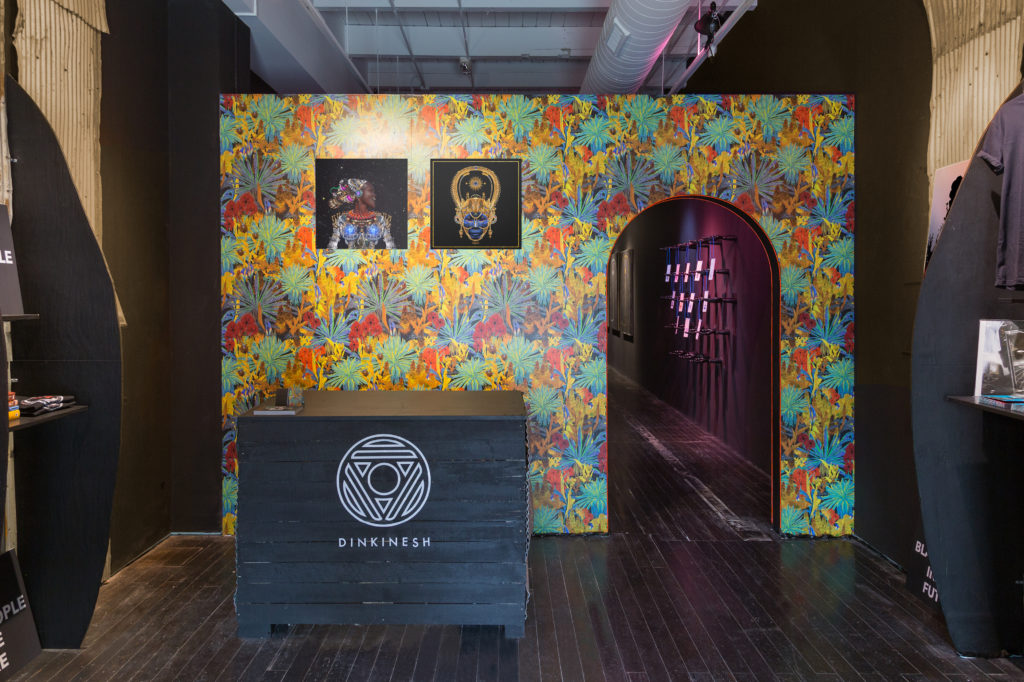
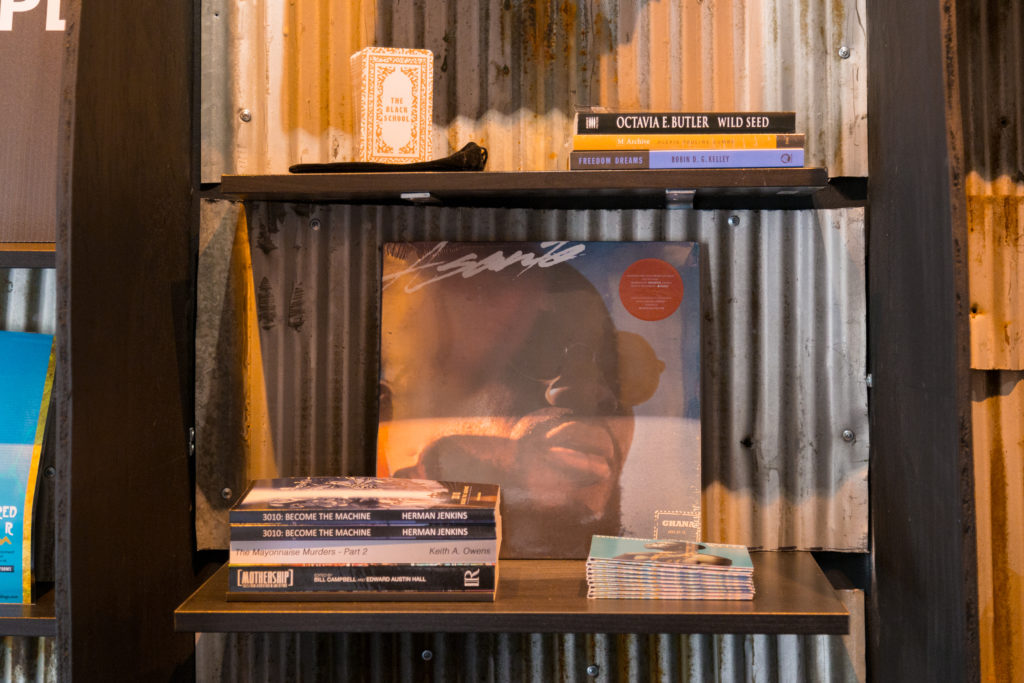
RC: You talk about confrontation but you are also confronting the fear. So you are recognising what’s at play not just at the surface, but on many levels here.
ILF: Exactly. You cannot heal that which you do not acknowledge exists, so I need people to confront the fact that the fear exists somewhere, subconsciously, in your DNA, your heart. Once the fear is acknowledged, the healing begins and then liberation is close. But the problem in the United States is that whites don’t have to confront their fears. But what is misunderstood is how by not confronting fear they are limiting their own life, and they are denying themselves access to humanity.
RC: The first time I met you was at The Gray Area festival when you were talking about running as mayor with an Afrofuturist manifesto. I love that I can now wrap up this interview with a question about your political career!
ILF: Yes! I was the first political candidate to use Afrofuturism as a framework in a mayoral campaign. It was very much of a process to understand what it means to be an Afrofuturist within a political sphere because it had never happened before.
RC: And we should also look for the connection between your work with Decentralised Detroit and your curation of Manifest Destiny?
ILF: As I stated before, I have been in a space of action and because I am an impatient person and I would love to see everyone liberated and happy in my utopia while I am alive, I began investigating ways to tackle the poverty issue in Detroit. It was after I proposed a universal basic income using a cryptocurrency Detroit would create that I began exploring how cryptocurrency and blockchain technology allows for the development of new economies and ways to make money but how it is a tool allowing for efficiency when creating and building with people. Anybody who has worked in groups understands we need as much organization as possible so as a result of working with blockchain technology I’ve come to learn about decentralised autonomous communities and that’s when I become really excited. This is my Afrofuturist self trying to figure out what are the obstacles that Black bodies face in imagining futures, new futures, decolonised futures, futures of their own making from the desire of their own heart, not because of someone else’s agenda or brainwashing.
There are a lot of obstacles but I’ve come naturally and organically to a point where I decided to focus on economics. And so economic justice has been my centre point for a couple of years now. By really attending to the racial wealth gap (it would take the average Black American family approximately 228 years to accrue the wealth of the average white American family), we will then be able to see people have more control over their lives and the neighborhoods they live in. Now we have a pathway for growing wealth, which was something that was denied to Black Americans for over 400 years and continues today.
For me everything is always related, all of it, the art, the blockchain, everything. I am trying to attend to the mind, body, and soul, all at the same time. It is hard for me to focus on just one pathway towards liberation. I like to understand and be involved in multiple pathways to freedom. That’s what keeps me exploring, curating, teaching, lecturing and creating workshops.
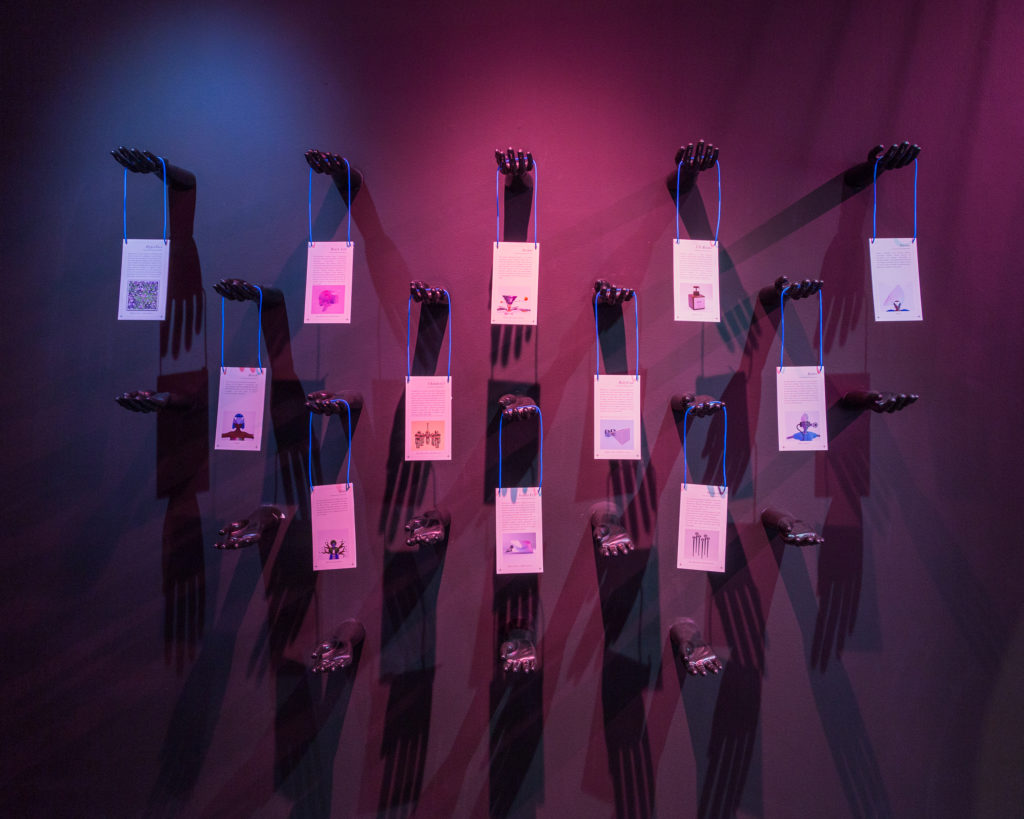
Manifest Destiny, is curated by Ingrid LaFleur. It is now on view at the Library Street Collective Gallery until 5 October 2019
Curator, pleasure activist and Afrofuturist. Her mission is to ensure equal distribution of the future, exploring the frontiers of social justice through new technologies, economies and modes of government. As a recent Detroit Mayoral candidate and founder and director of AFROTOPIA, LaFleur implements Afrofuturist strategies to empower Black bodies and oppressed communities through frameworks such as blockchain and universal basic income. Ingrid LaFleur is currently the Director of Social Impact for Detroit Blockchain Center and curator of Manifest Destiny currently taking place at Library Street Collective in Detroit.
Join us in London at the DAOWO ‘Blockchain & Art Knowledge Sharing Summit’
DAOWO (Distributed Autonomous Organisations With Others) Summit UK facilitates cross-sector engagement with leading researchers and key artworld actors to discuss the current state of play and opportunities available for working with blockchain technologies in the arts. Whilst bitcoin continues to be the overarching manifestation of blockchain technology in the public eye, artists and designers have been using the technology to explore new representations of social and cultural economies, and to redesign the art world as we see it today.
Discussion will focus on potential impacts, technical affordances and opportunities for developing new blockchain technologies for fairer, more dynamic and connected cultural ecologies and economies.
Programme
9.00 Registration
9.30 Welcome and Scene Setting
State of the Arts: Blockchain’s Impact in 2019 and Beyond | A comprehensive overview of developments from critical artistic practices and emergent blockchain business models in the arts. DAOWO Arts and Blockchain pdf download (Catlow & Vickers 2019).
Presentation and hosted discussion with Ruth Catlow and Ben Vickers
10.30 Coffee
10.45 Protecting the Rights of Indigenous Australian Artists. What part can Blockchain technologies play?
The Copyright Agency, Australia in conversation with Mark Waugh, DACS UK
11.30 Towards a Decentralised Arts Economy
The launch of Zien, the new dApp for artists will be followed by a presentation and panel discussion with Peter Holsgrove, and artists of A*NA around the implications of tokenising artistic practices.
12.15 Digital Catapult panel
12.45 Wrap up, takeaways and final discussion
Ruth Catlow, Ben Vickers & Mark Waugh
Contributors include:
Ruth Catlow Co-founder of Furtherfield & DECAL Decentralised Arts Lab
Peter Holsgrove, Founder of A*NA
Ben Vickers, CTO Serpentine Galleries, Co-founder unMonastery
Mark Waugh, Business Development Director DACS
Through two UK summits, the DAOWO programme is forging a transnational network of arts and blockchain cooperation between cross-sector stakeholders, ensuring new ecologies for the arts can emerge and thrive.
DAOWO Summit UK is a DECAL Decentralised Arts Lab initiative – co-produced by Furtherfield and Serpentine Galleries in collaboration with the Goethe-Institut London. This event is realised in partnership DACS, UK.
Furtherfield has worked with decentralised arts and technology practices since 1996 inspired by free and open source cultures, and before the great centralisation of the web.
Visit DECAL website
10 years ago, blockchain technologies blew apart the idea of money and value as resources to be determined from the centre. This came with a promise, yet to be realised, to empower self-organised collectives of people through more distributed forms of governance and infrastructure. Now the distributed web movement is focusing on peer-to-peer connectivity and coordination with the aim of freeing us from the great commercial behemoths of the web.
There is an awkward relationship between the felt value of the arts to the majority and the financial value of arts to a minority. The arts garner great wealth, while it is harder than ever to sustain arts practice in even the world’s richest cities.
In 2015 we launched the Art Data Money programme of labs, exhibitions and debates to explore how blockchain technologies and new uses of data might enable a new commons for the arts in the age of networks. This was followed by a range of critical art and blockchain research programming:
Building on this and our award winning DAOWO lab and summit series, we have developed DECAL – our Decentralised Arts Lab and research hub.
Working with leading visionary artists and thinkers, DECAL opens up new channels between artworld stakeholders, blockchain and web3.0 businesses. Through the lab we will mobilise research and development by leading artists, using blockchain and web 3.0 technologies to experiment in transnational cooperative infrastructures, decentralised artforms and practices, and improved systems literacy for arts and technology spaces. Our goal is to develop fairer, more dynamic and connected cultural ecologies and economies.
For more see our Art and Blockchain resource page.
Join us in Edinburgh at the first DAOWO ‘Blockchain & Art Knowledge Sharing Summit’ of 2019
DAOWO (Distributed Autonomous Organisations With Others) Summit UK facilitates cross-sector engagement with leading researchers and key artworld actors to discuss the current state of play and opportunities available for working with blockchain technologies in the arts. Whilst bitcoin continues to be the overarching manifestation of blockchain technology in the public eye, artists and designers have been using the technology to explore new representations of social and cultural economies, and to redesign the art world as we see it today.
This summit will focus on potential impacts, technical affordances and opportunities for developing new blockchain technologies for fairer, more dynamic and connected cultural ecologies and economies.
Programme
Although the term ‘blockchain’ has trickled downstream into the public domain, the principles behind the technology remain mysterious to many. Embodied within physical assemblages or social interventions that mine, hash and seal the evidence of human practices, creatives have provided important ‘coordinates’ in the form of artworks that help us to unpick the implications of the technology and the extent to which it re-configures power structures.
Hosted by Prof Chris Speed and Mark Daniels with panellists:
Pip Thornton – The Value of Words in an Age of Linguistic Capitalism
Bettina Nissen & Ailie Rutherford – Designing feminist cryptocurrency for Govanhill
Evan Morgan – GeoPact
Jonathan Rankin – OxChain, Pizza Block
Larissa Pschetz – Karma Kettles
Contributors include:
Ruth Catlow, Furtherfield and DECAL
Mark Daniels, New Media Scotland
Clive Gillman, Creative Scotland
Marianne Magnin, Arteïa
Prof Chris Speed, Design Informatics, University of Edinburgh
Ben Vickers, Serpentine Galleries
Through two UK summits, the DAOWO programme is forging a transnational network of arts and blockchain cooperation between cross-sector stakeholders, ensuring new ecologies for the arts can emerge and thrive.
DAOWO Summit UK is a DECAL initiative – co-produced by Furtherfield and Serpentine Galleries in collaboration with the Goethe-Institut London. This event is realised in partnership with the Department of Design Informatics at the University of Edinburgh and New Media Scotland.
OxChain is a major EPSRC research project which explores how Blockchain technologies can be used to reshape value in the context of international development and the work of Oxfam, involving the Universities of Edinburgh, Northumbria and Lancaster.
When I first heard about MoneyLab, it was back in 2013 or the beginning of 2014, when I was doing my masters in London. A friend of mine handed a flyer to me and I was intrigued by the strange typography and the combination of bright colours. However, I didn’t quite believe that any kind of initiative could really start an alt-economy movement. Not that I didn’t believe in local currency or creative commons, but those gentle approaches generally seemed to lack traction, just like liberals do with voters. I naturally thought MoneyLab was one of those initiatives.
However, as Bitcoin was becoming a hype, the name popped up again; MoneyLab itself was also becoming a hype. While bitterly regretting not being able to be associated as the first wave of participants, I started to think that maybe MoneyLab might be the framework that can really push out alternative economic attempts as mainstream culture. My stance towards economic shifts was somewhat similar to that of William Gibson’s; he said in an interview with the British newspaper The Guardian, ‘What would my superpower be? Redistribution of wealth’. How did that change after reading the MoneyLab Reader 2?
Before going into the details of what blockchain technology can really do, it is crucial to understand a new “unit of value” created in modern society (Pine and Gilmore 1999). Since the most prominent piece of technology of our era is undoubtedly smartphones (with Apple being the first 1 trillion dollar publicly listed company in the US), a lot of transactions are inevitably conducted through apps and web services. The proliferation of the so-called “payments space” signifies the era of UX design, which is the third paradigm of HCI (Human-Computer Interaction), “tak[ing] into account…affect, embodiment, situated meaning, values and social issues” (Tkacz and Velasco 2018). In other words, experience has become the deciding factor of customers’ choices. With vast amounts of data generated at the back of sleek interfaces, one can precisely oversee the users’ behaviour, which then is fed back into the system.
All the payments spaces are essentially digital. This means transactions leave digital traces whether you like it or not. The idea of a cashless society exactly stems from this interest, the authorities can have better understandings of how people make money; in other words, where black money flows. Brett Scott has been pointing out the danger of a cashless society for quite some time now, I saw another variation in this book.
According to Jaya Klara Brekke, blockchain technology can make money programmable, “allow[ing] for very fine-grained (re)programming of the medium of money, from what constitutes, and how to measure, value-generating activity to the setting of parameters on the means and conditions of exchange – what is spendable, where and by whom” (Brekke 2018). The overall impression I got from the MoneyLab Reader 2 about what blockchain technology can really do is basically this. Making a currency programmable using smart contracts.
More than a couple of authors discuss how “contingency” should take place in designed currencies. Contingency is different from randomness; in fact, it could mean exactly the opposite. For example, when coins are distributed in a perfectly random manner, you have absolutely no control in the handling process. If contingency is embedded in a system, it means there are exploitable gaps, which seem to almost randomly benefit people. On the other hand, some individuals would find ways to make use of these gaps, which are considered to be legitimate. Brekke discusses how the way in which contingency is programmed into a currency will be a key for the future of finance, both in terms of experience and redistribution of wealth. Therefore, currency designers will be the next UX designers.
A number of ideas applying blockchain technology to both physical and cultural objects are mentioned in this book, from a self-maintaining forest to blockchain-based marriage. “Terra0” is the concept of an autonomous forest which can “self-harvest its own value” (Lotti 2018). Utopian views of a human-less world are prevalent, but in reality, a healthy forest requires an adequate amount of human intervention. In addition, the value of a forest cannot be determined by itself; trade routes, demand and supply, they are all drawn by human movements. For example in Japan, domestic wood resources are generally not profitable because of the expensive labour costs. Illegally cut trees without certification from Southeast Asia dominate the market, putting domestic ones in a bad position. When a forest itself is not profitable, how can it accumulate capital autonomously? Besides, the oracle problem has not been discussed at all. Unless everything is digital in the first place, there always needs to be somebody to put data onto the blockchain. In other words, the transcendence of the boundaries between the physical and the digital is not possible without human intervention. Blockchain marriage would face a similar problem; who might be the witness if circumventing the government official? Max Dovey investigates the notion of “crypto-sovereignty” while introducing an example of a real blockchain marriage where they “turn[ed] ‘proof of work’… into ‘proof of love’”(Dovey 2018). Just as the sacramental bond between spouses can be broken before Death Do Them Part, so can any cryptographic marriage unravel despite having been recorded in an immutable ledger. Whatever repercussions may exist for divorce, there are no holy or technological mechanisms to prevent it.
Platform co-ops is one of the largest topics in the book besides Universal Basic Income (UBI). A platform co-op is often a cooperatively owned version of a major platform that is supposed to be able to pay better fees to the workers. Also, a platform co-op is often associated with “lower failure rate”; 80% of them survive the first five years when only 41% of other business models do (Scholz 2018). While embracing the positive aspects of platform co-ops, I have this question stuck in my head: can you not make a platform co-op based on a new idea rather than copying existing ones?
Most platform co-ops seem that they are looking at already successful and established concepts such as rental marketplaces for rooms and ride hailing services. As a result, platform co-ops are considered more to be a social movement than an innovation. Why not just run a business right at the centre of Capitalism without being motivated by profit? Many platform co-ops challenge the main stream services such as Airbnb or Uber, however those services operate based on scale; if they have the largest user base, it will be very difficult to take them on, unless they die themselves like Myspace… Moreover, more hardware side of development can be happening around co-ops, but I don’t hear anything except for Fairphone. When can I stop using my ThinkPad with Linux on it?
After reading the MoneyLab Reader 2: Overcoming the Hype, now I’m thinking of how I should design my own currency. Of course whether cryptocurrencies are actually currencies is up to debate; depending on who you ask, Ethereum is a security (SEC), a commodity (CFTC), taxable property (IRS) or a currency (traders).
MoneyLab 2 authors overall suggest that we should not limit our imagination to fit in the existing finance systems, but think beyond. You don’t necessarily need to cling to cryptocurrencies but they may help you shape your ideal financial system.
At Furtherfield we have worked with decentralised network practices in arts and technology since we published our first webpages in 1996 – before the great centralisation – when the web thought it was already distributed and P2P. We took the spirit of punk and DIY in a more collaborative direction inspired by Free and Open Source Software methods and cultures, to build new platforms and art contexts with a playful Do It With Others (DIWO) ethos. We still connect with artists, techies, activists and thinkers from our base in Finsbury Park in North London, and internationally online. In 2015 Furtherfield launched the Art Data Money programme that sought to develop a commons for the arts in the network age.
DECAL – Decentralised Arts Lab is the outcome.
DECAL exists to mobilise crowdsourced research and development by leading artists, using blockchain and web 3.0 technologies for fairer, more dynamic and connected cultural ecologies and economies now.

Furtherfield Spring Editorial 2018 – Blockchain Imaginaries
2018
Introduction to Furtherfield Spring season of art and blockchain essays, interviews, events, exploration and critique.
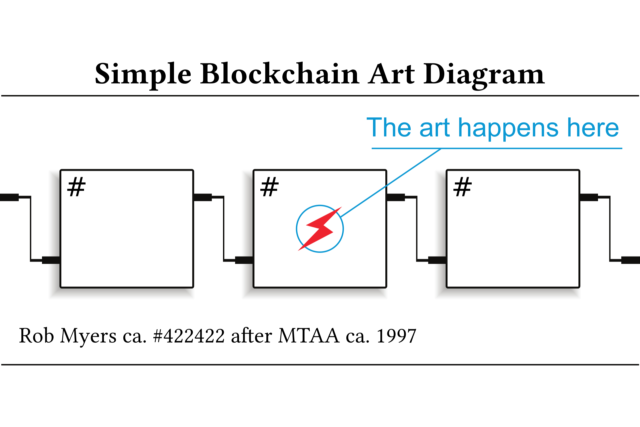
Collected writings by Rhea Myers
2014 – Present
On blockchain geometries, accelerationist art, crypto and DAWCs, art for algorithms, and (Conceptual) Art, cryptocurrency and beyond.
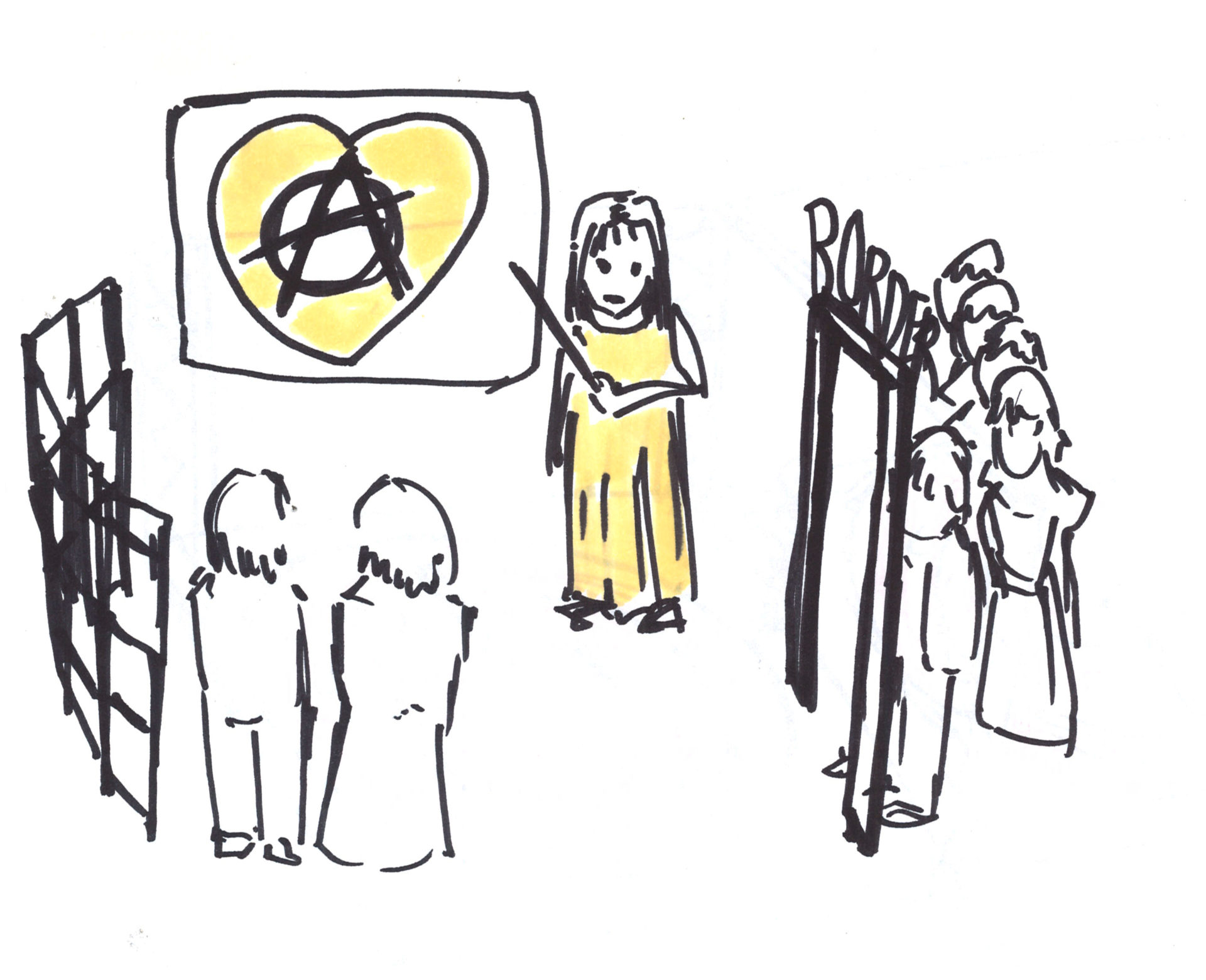
DAOWO – The blockchain laboratory and debate series for reinventing the arts
Oct 2017 – Present
A temporary laboratory for the creation of a living blockchain art laboratory devised by Ruth Catlow and Ben Vickers in collaboration with Goethe Institut, London.
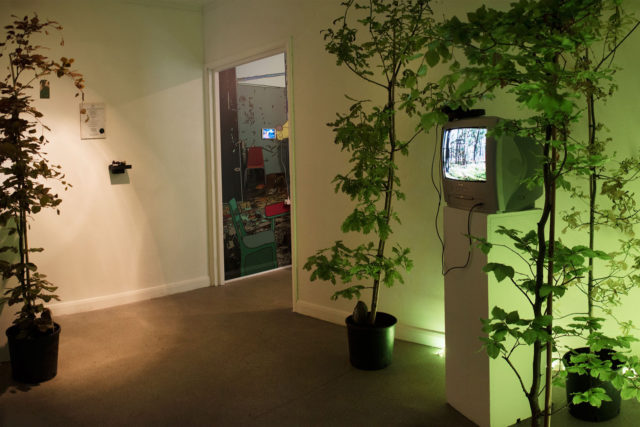
New World Order
2017 – 18
Artists envision a world made by machines, markets and natural processes, without states or other human institutions in an international touring exhibition curated by Furtherfield.
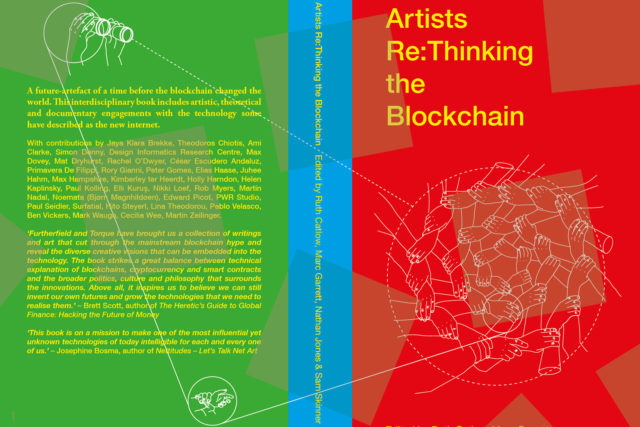
Artists Re:thinking the Blockchain
2017
The first book of its kind, bringing together artistic, speculative, conceptual and technical engagements with blockchains.
Edited by Ruth Catlow, Marc Garrett, Nathan Jones, and Sam Skinner
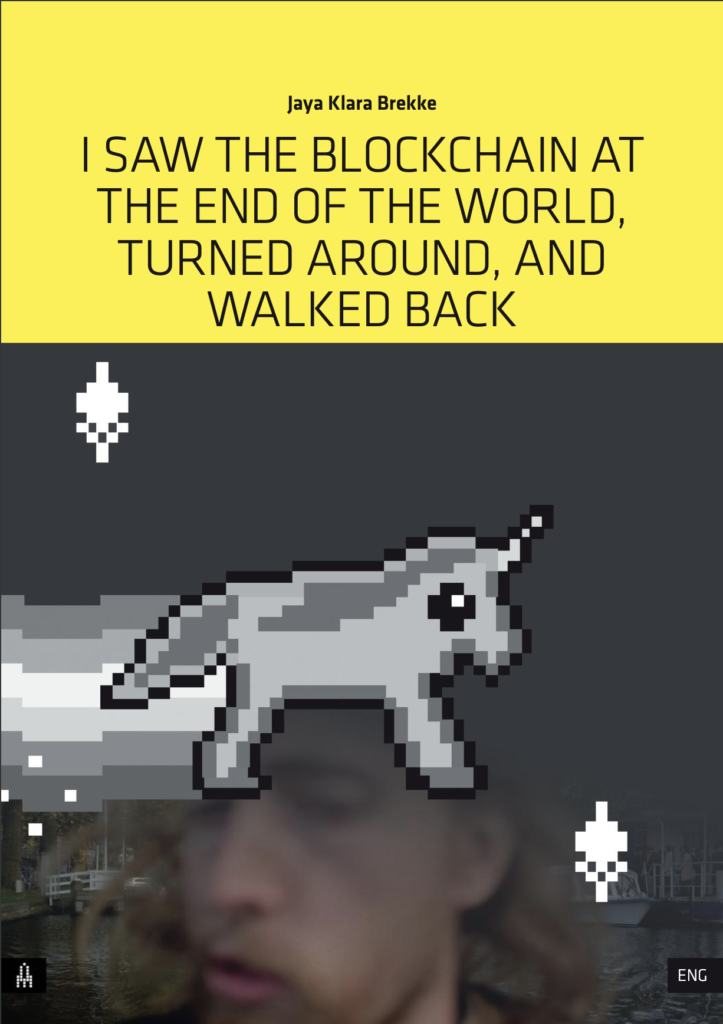
Jaya Klara Brekke: I saw the Blockchain at the End of The World, turned around, and walked back
2018
Written on the occasion of the New World Order group exhibition for PostScriptUM #31 Series published by Aksioma, edited by Janez Janša
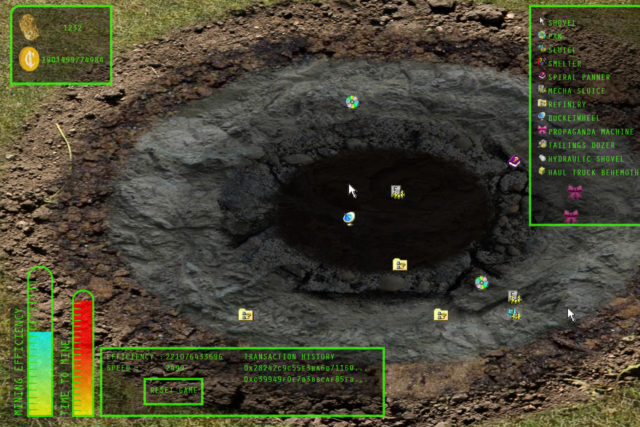
Blockchain Art Commission*
2017
Clickmine by Sarah Friend is a hyperinflationary ERC-20 token that is minted by a clicking game.
A Furtherfield and NEoN Digital Arts Festival Co-commission
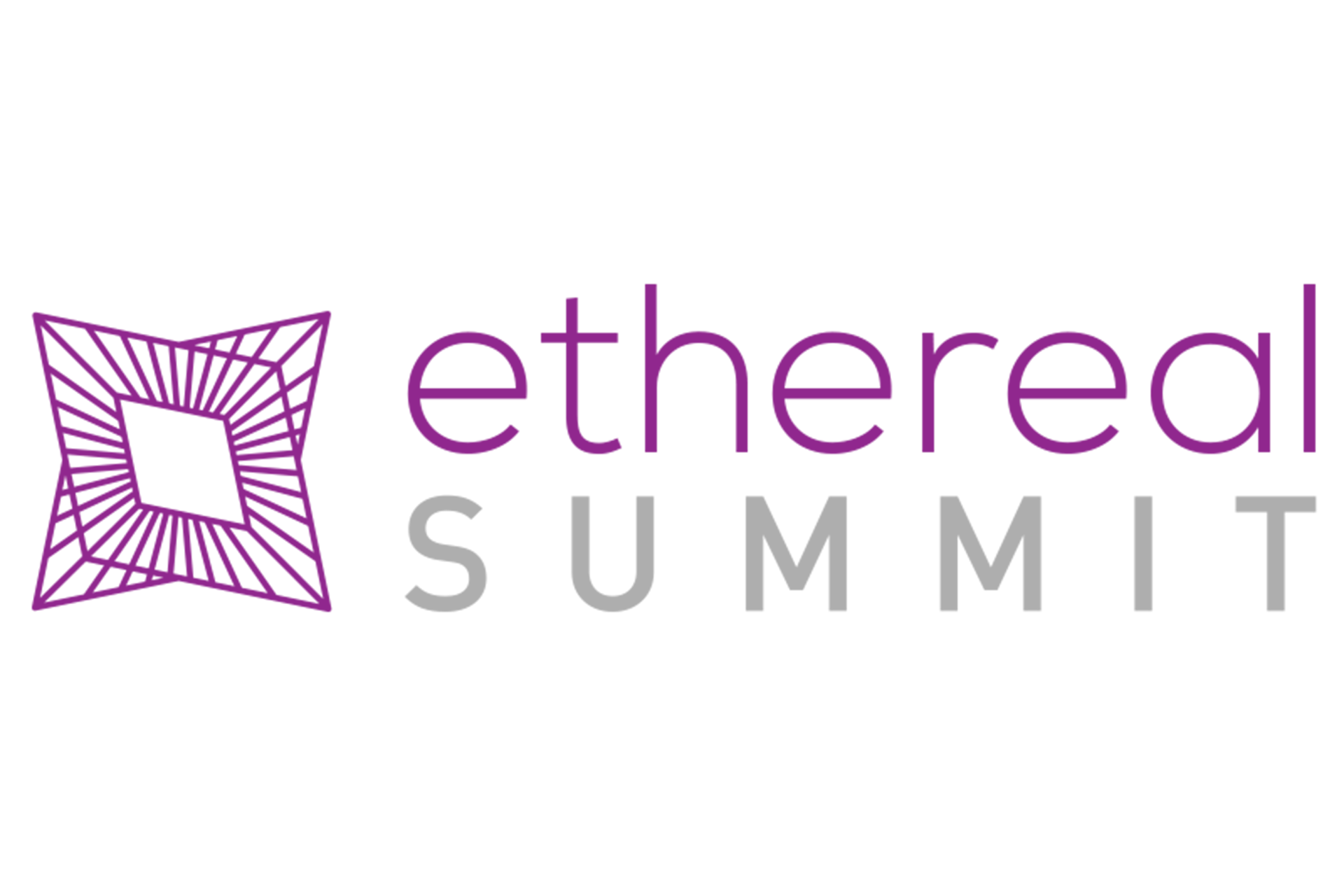
Ethereal Summit NY
2018
Commission and exhibition of contemporary artists working with public blockchains as a medium for conceptual and social experimentation. Jurors and curators, Ruth Catlow, Giani Fabricio, Sam Hart, Will King, Saraswathi Subbaraman
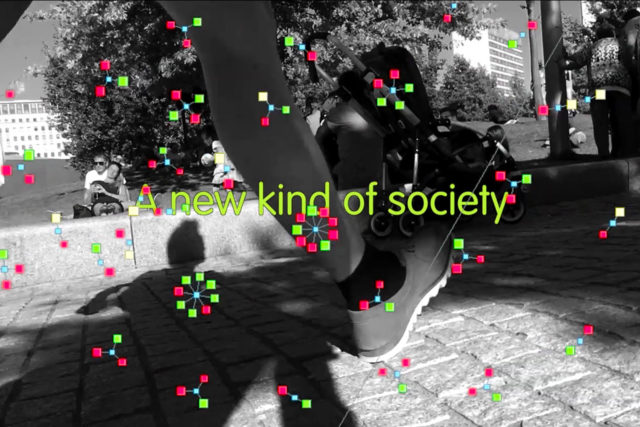
The Blockchain: Change Everything Forever
2016
A short film to stimulate cross sector debate around how emerging blockchain technologies change the social contract, directed by Pete Gomes
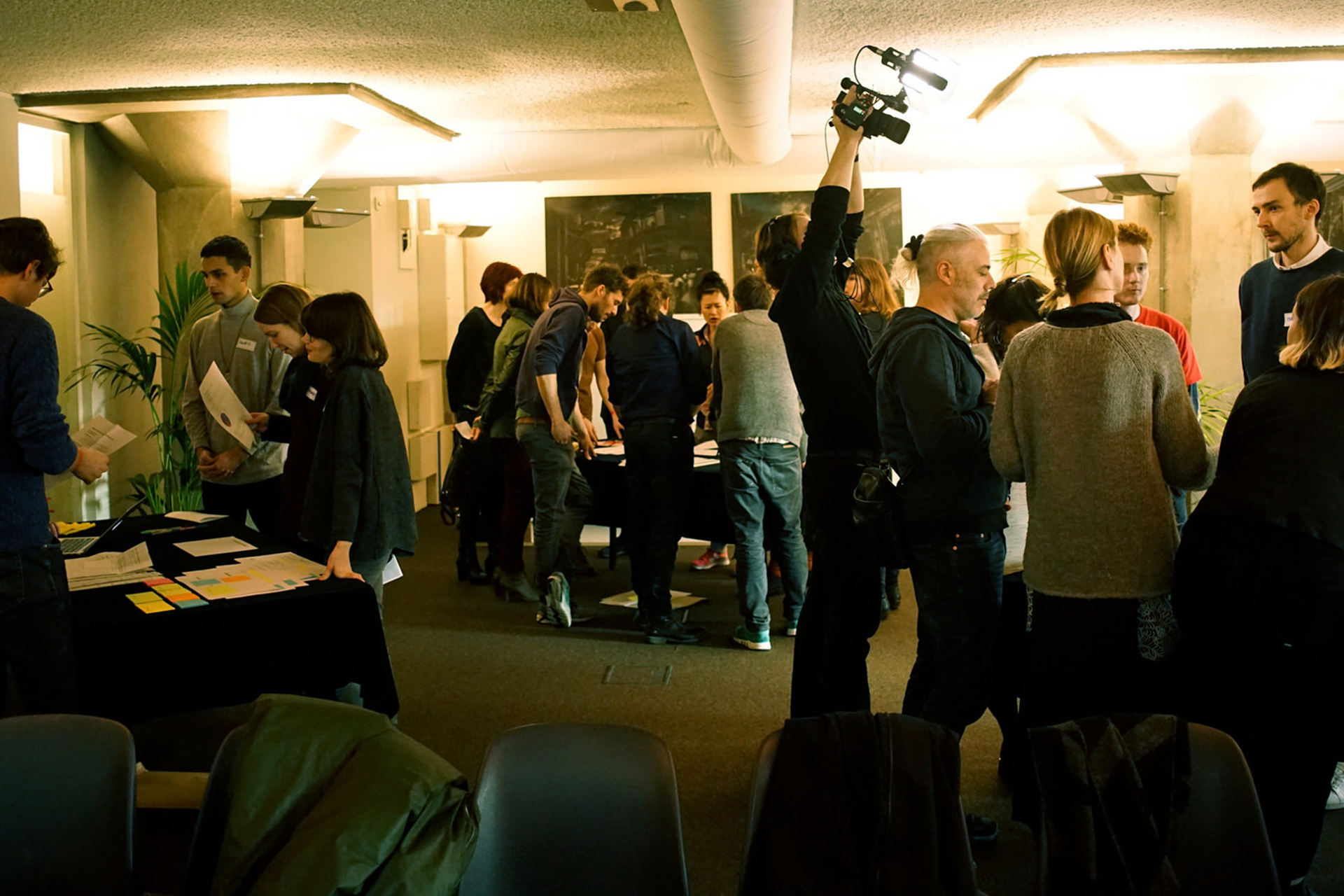
Role Play Your Way to Budgetary Blockchain Bliss
2016
Ruth Catlow and Ben Vickers brought the LARPing tradition to INC’s MoneyLab. Inviting participants to take on generic roles from the business cycle of start up tech companies trying to make the next big thing with the latest technological innovation.
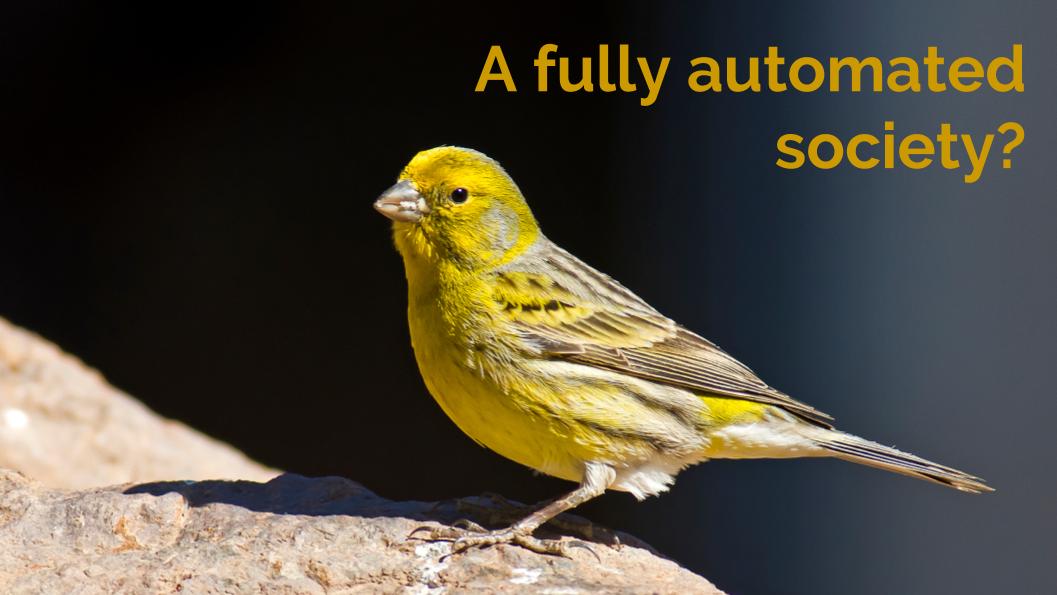
Blockchain’s Potential in the Arts
2016
A gathering of organisations, academics and policy makers in arts and culture to explore blockchain’s potential. Convened by Ben Vickers and Ruth Catlow and hosted by the Austrian Cultural Forum, London.
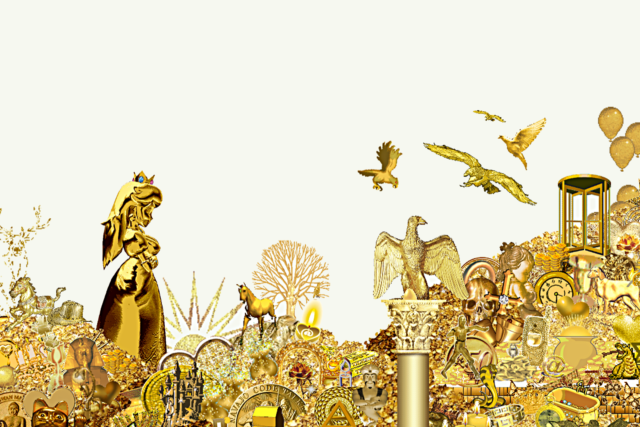
The Human Face of Cryptoeconomies
2015
An exhibition curated by Futherfield to explore how might we produce, exchange and value things differently for a transformed artistic, economic and social future?
http://rhizome.org/editorial/2018/jun/14/island-mentality/
https://edition.cnn.com/style/article/cryptokitty-blockchain/index.html
http://hyperallergic.com/440936/what-blockchain-means-for-contemporary-art/
https://www.artbasel.com/news/artists-as-cryptofinanciers–welcome-to-the-blockchain
Exhibition, Furtherfield Gallery, London Oct 2015 – Nov 2015
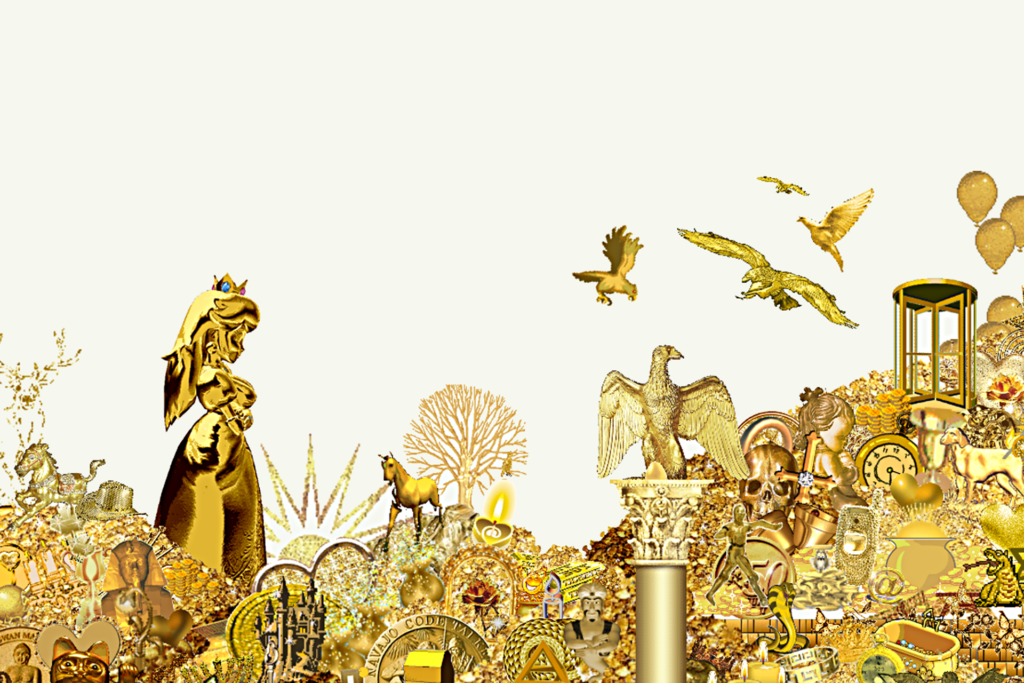
Émilie Brout and Maxime Marion exhibit ornamental Gold and Glitter created with ‘found’ internet GIFs and Nakamoto (The Proof) – a video documenting the artists’ attempt to produce a fake passport of the mysterious creator of Bitcoin, Satoshi Nakamoto. FaceCoin by Rhea Myers is an artwork that is also a machine for mining faces as proof of aesthetic work. His Shareable Readymades are iconic 3D printable artworks for an era of digital copying and sharing. The Museum of Contemporary Commodities by Paula Crutchlow and Dr Ian Cook treats everyday purchases as if they were our future heritage and Jennifer Lyn Morone™ Inc reclaims ownership of personal data by turning her entire being into a corporation. The Alternet by Sarah T Gold conceives of a way for us to determine with whom, and on what terms, we share our data and Shu Lea Cheang anticipates a future world where garlic is the new social currency.
Press:
JJ Charlesworth for Art Review Jan-Feb 2016
Short film, 2016
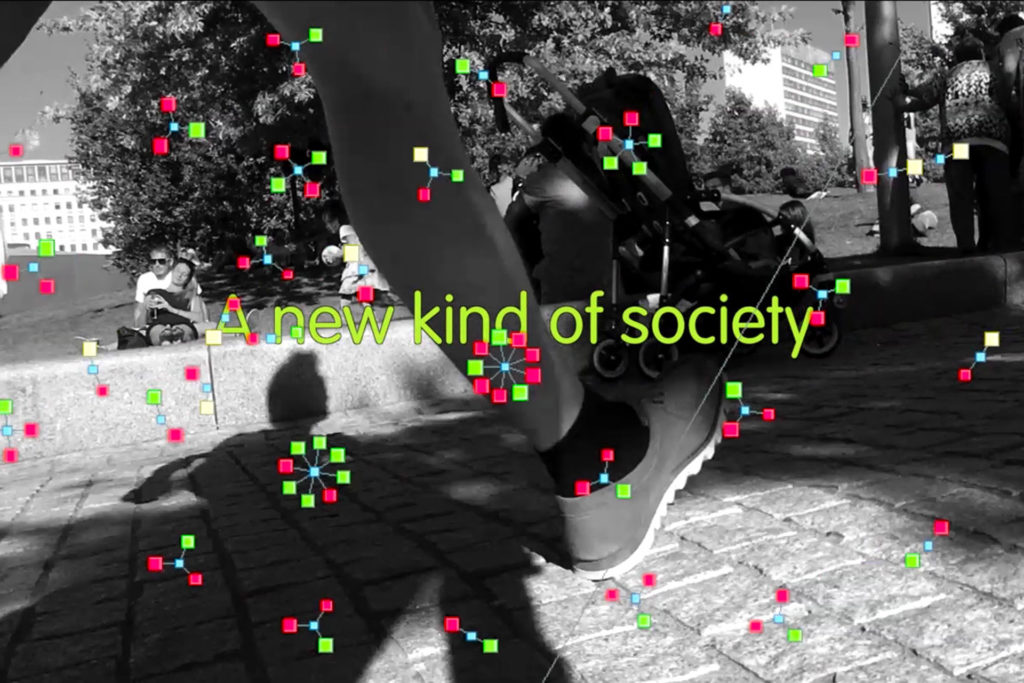
The underpinning technology of digital currencies and smart contracts, the blockchain is reshaping concepts of value, trust, law and governance. This film sets out to diversify the people involved in its future by bringing together leading thinkers, computer scientists, entrepreneurs, artists and activists who discuss:
A Furtherfield film with Digital Catapult London. Directed by Pete Gomes, concept and research by Ruth Catlow. Featuring interviews with: Dr Anat Elhalal; Ben Vickers; Dr Catherine Mulligan; Elias Haase; Irra Ariella Khi; Jaime Sevilla; Jaya Klara Brekke; Kei Kreutler; Pavlo Tanasyuk; Rhea Myers; Sam Davies; and Vinay Gupta
Live Action Role Play, 2016
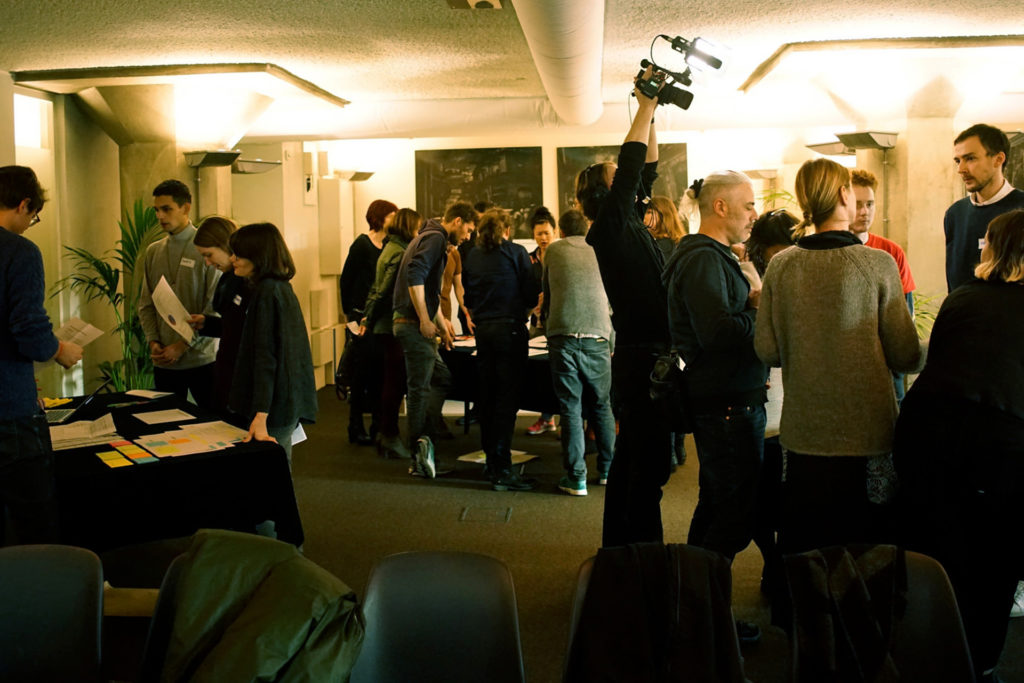
This 2-day start up tech hackathon compressed into 2 hours was aimed at creating Blockchain based businesses ideas that improve the life and future of cats. The workshop critically emulated the extravagant discourse and excitement surrounding the super-automation and hyperconnectivity that comes with blockchain and similar technologies, and the capacity of the technology stakeholders to both increase and diminish global inequity. Devised by Ben Vickers, Ruth Catlow for Institute of Network Cultures’ MoneyLab.
Report:
http://networkcultures.org/moneylab/2016/12/06/role-play-your-way-to-budgetary-blockchain-bliss/
International Touring Exhibition, 2017 – 2018
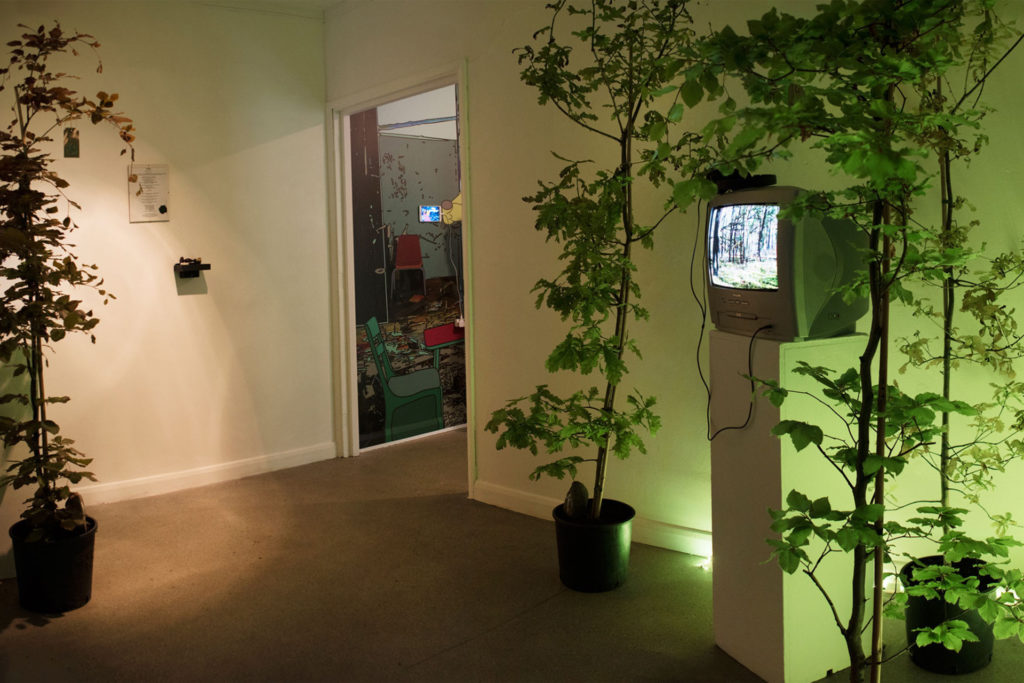
Jaya Klara Brekke, Max Dovey, Pete Gomes, HandFastr, Rhea Myers, Primavera De Filippi of O’Khaos, Terra0, Lina Theodorou and xfx (aka Ami Clarke). Curated by Furtherfield
A self-owning forest with ideas of expansion, a self-replicating android flower, a cryptocurrency rig to mine human breath, a five minute marriage contract, a Hippocratic Oath for software developers; in an exhibition about living with blockchain technologies.
Artists investigate and test the possible consequences of blockchain technologies, and their capacity to embody divergent political ideas. They explore dramatic new conceptions of global governance and economy, that could permanently enrich or demote the role of humans. They portray a world in which responsibility for many aspects of life are transferred, permanently (for better or worse) from natural and social systems into a secure, networked, digital ledger of transactions, and computer-executed contracts.
Produced as part of the State Machines programme*
Press: https://edition.cnn.com/style/article/cryptokitty-blockchain/index.html
Book published by Torque Editions, 2017
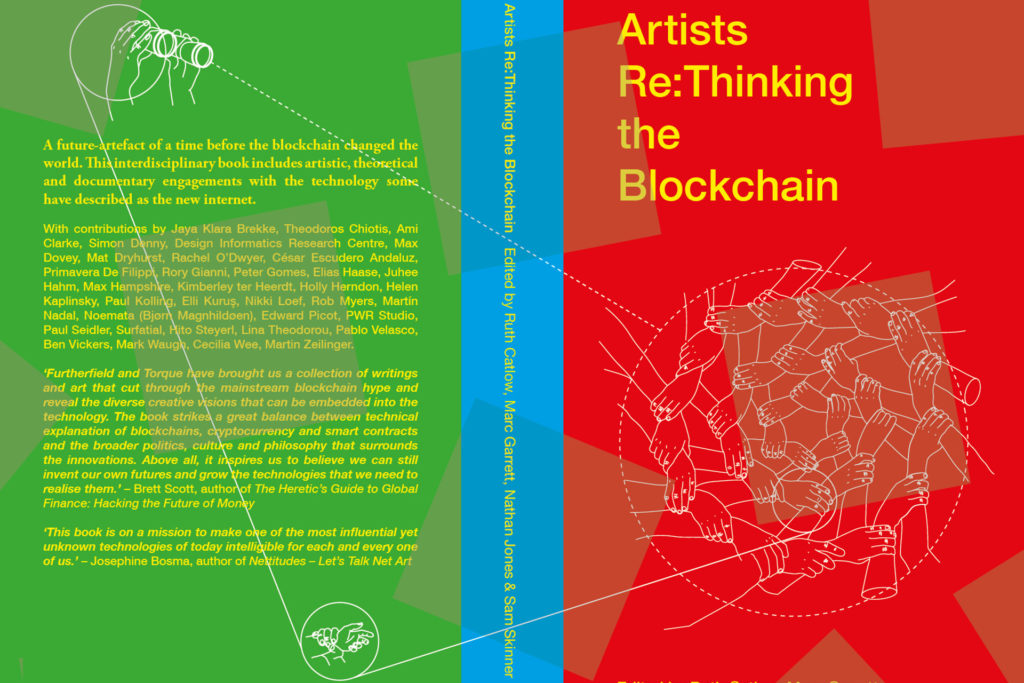
Artists Re:Thinking the Blockchain is the first book of its kind, intersecting artistic, speculative, conceptual and technical engagements with the the technology heralded as “the new internet”. The book features a range of newly commissioned essays, fictions, illustration and art documentation exploring what the blockchain should and could mean for our collective futures.
Artists Re:Thinking The Blockchain
Imagined as a future-artefact of a time before the blockchain changed the world, and a protocol by which a community of thinkers can transform what that future might be, Artists Re:Thinking The Blockchain acts as a gathering and focusing of contemporary ideas surrounding this still largely mythical technology. The full colour printed first edition includes DOCUMENTATION of artistic projects engaged in the blockchain, including key works Plantoid, Terra0 and Bittercoin, THEORISATION of key areas in the global blockchain conversation by writers such as Hito Steyerl, Rachel O’Dwyer, Rhea Myers, Ben Vickers and Holly Herndon, and NEW POETRY, ILLUSTRATION and SPECULATIVE FICTION by Theodorios Chiotis, Cecilia Wee, Juhee Hahm and many more. It is edited by Ruth Catlow, Marc Garrett, Nathan Jones and Sam Skinner.
Along with a print edition, Artists Re:Thinking the Blockchain includes a web-based project in partnership with Design Informatics at University of Edinburgh: Finbook is an interface where readers and bots can trade on the value of chapters included in the book. As such it imagines a new regime for cultural value under blockchain conditions.
This book and surrounding events is produced in collaboration between Torque and Furtherfield, connecting Furtherfield’s Art Data Money project with Torque’s experimental publishing programme. It is supported by an Arts Council England Grants for the Arts, Foundation for Art and Creative Technology and through the State Machines project by the Creative Europe Programme of the European Union.
Buy Artists Re:thinking the Blockchain
Format: Paperback
ISBN number: 978-0-9932487-5-7
Torque and Furtherfield, London, 2017
Distributor: Liverpool University Press
Press:
http://we-make-money-not-art.com/artists-rethinking-the-blockchain/
https://hyperallergic.com/440936/what-blockchain-means-for-contemporary-art/
http://networkcultures.org/moneylab/2018/01/26/artists-rethinking-the-blockchain/
The blockchain laboratory and debate series for reinventing the arts, 2017 – Present

This series brings together artists, musicians, technologists, engineers, and theorists to join forces in the interrogation and production of new blockchain technologies. The focus is to understand how blockchains might be used to enable a critical, sustainable and empowered culture, that transcends the emerging hazards and limitations of pure market speculation of cryptoeconomics.
Devised by Ruth Catlow and Ben Vickers in collaboration with Goethe Institut, London.
Contributors include Ramon Amaro, Jaya Klara Brekke, Ed Fornieles, Jess Houlgrave, Janez Jansa, Helen Kaplinsky, Thor Karlsson, Kei Kreutler, Sarah Meiklejohn, Julian Oliver, Emily Rosamond, Hito Steyerl, Mark Waugh, Laura Willis.
Visit the DAOWO website to view video and pdf resources
Produced as part of the State Machines programme*
Press:
http://rhizome.org/editorial/2018/jan/03/reinventing-the-art-lab-on-the-blockchain/
http://rhizome.org/editorial/2018/jun/14/island-mentality/
*State Machines: Art, Work and Identity in an Age of Planetary-Scale Computation
Focusing on how such technologies impact identity and citizenship, digital labour and finance, the project joins five experienced partners Aksioma (SI), Drugo More (HR), Furtherfield (UK), Institute of Network Cultures (NL) and NeMe (CY) together with a range of artists, curators, theorists and audiences. State Machines insists on the need for new forms of expression and new artistic practices to address the most urgent questions of our time, and seeks to educate and empower the digital subjects of today to become active, engaged, and effective digital citizens of tomorrow.
This project has been funded with the support from the European Commission. This communication reflects the views only of the author, and the Commission cannot be held responsible for any use which may be made of the information contained therein.
Artists Organise (on the blockchain) was the fourth event in the DAOWO blockchain laboratory and debate series for reinventing the arts, in collaboration with Goethe Institut London.
In this special event, hosted by Drugo more in Rijeka we learned from the Croatian cultural context before envisioning, devising and testing alternative forms of blockchain-based cultural production systems, for application at Furtherfield in London.
We talked with Davor Miskovic about Clubture, the non-profit initiative that has distributed national cultural funding between a network of peers in Croatia since 2002 according to decentralised, participatory principles.
Workshop participants then took Julian Oliver’s Harvest, in which “wind energy is used to mine cryptocurrency to fund climate research”, as their focus for new proposals for blockchain-based projects to connect park-based arts venues with their local communities. Then they took turns to perform the role of a select committee of skeptical park stakeholders who wanted to know how park users would benefit from the scheme in a time of cuts to public funding and climate change.
Read the semi-fictional Minutes of the Bunsfury Park Stakeholders Group Select Committee
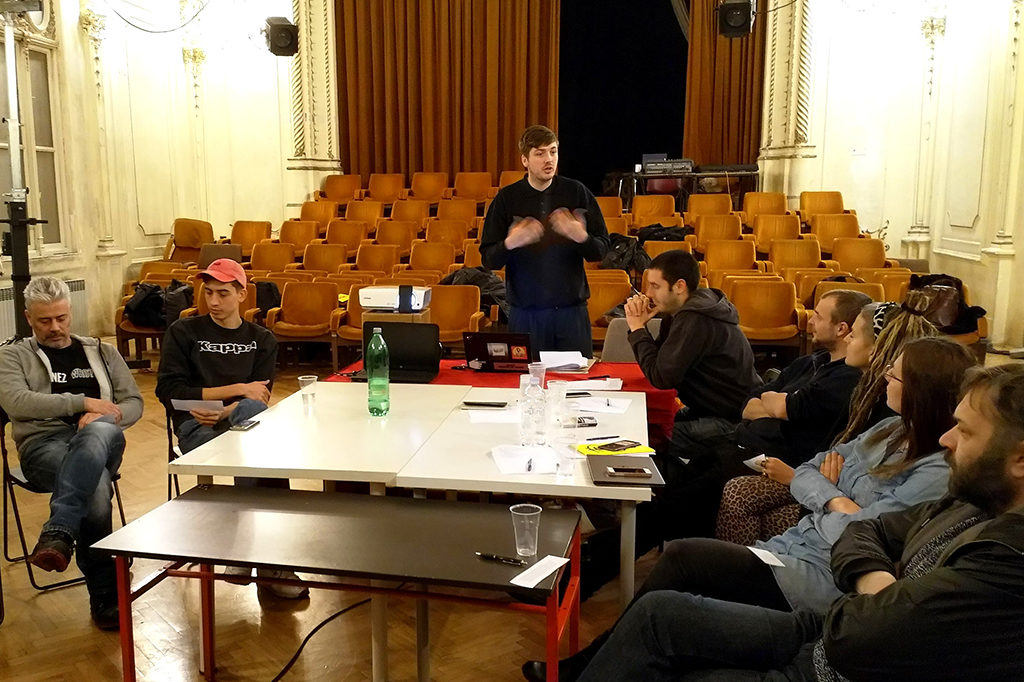
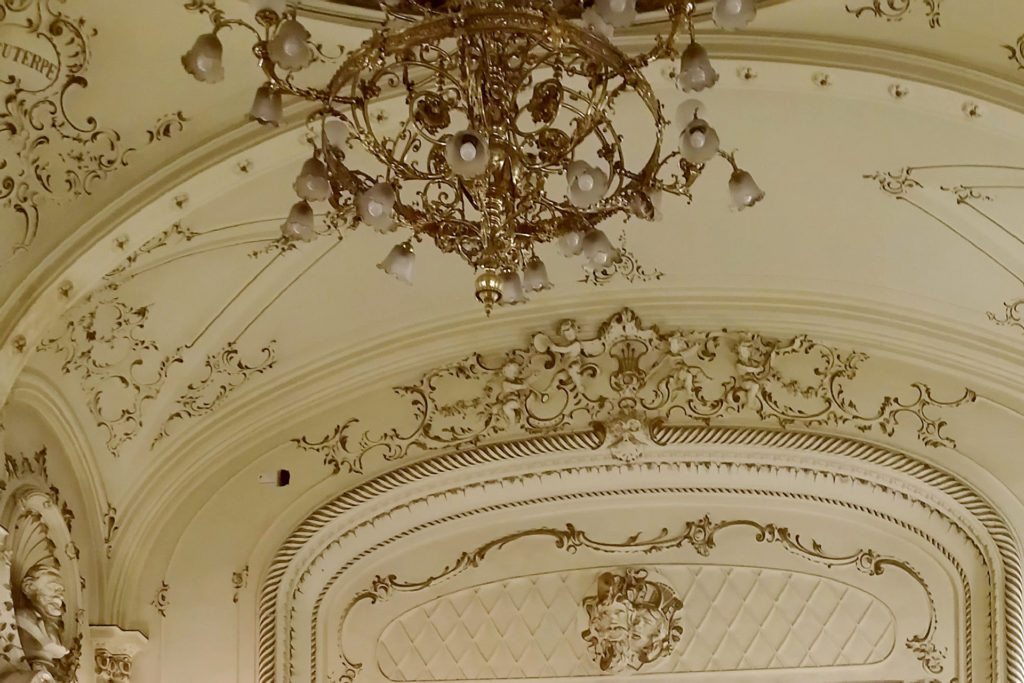
This special event, devised by Ruth Catlow and Max Dovey, and hosted by Drugo more formed part of a wider programme events in Rijeka to accompany the opening at Filodrammatica Gallery of the touring exhibition New World Order.
Thanks to all participants!
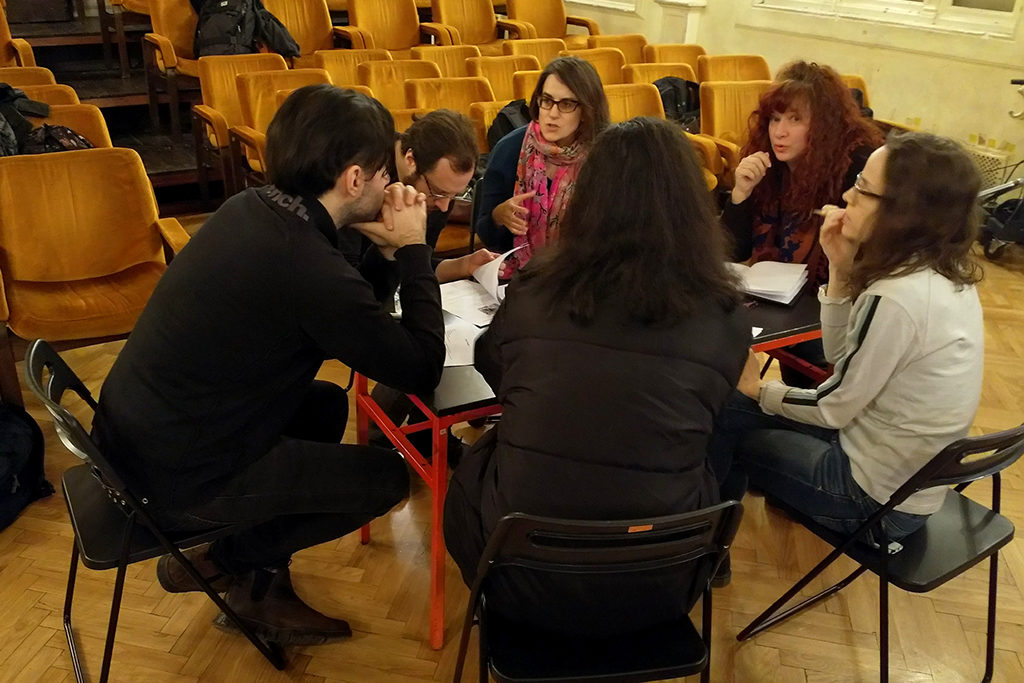
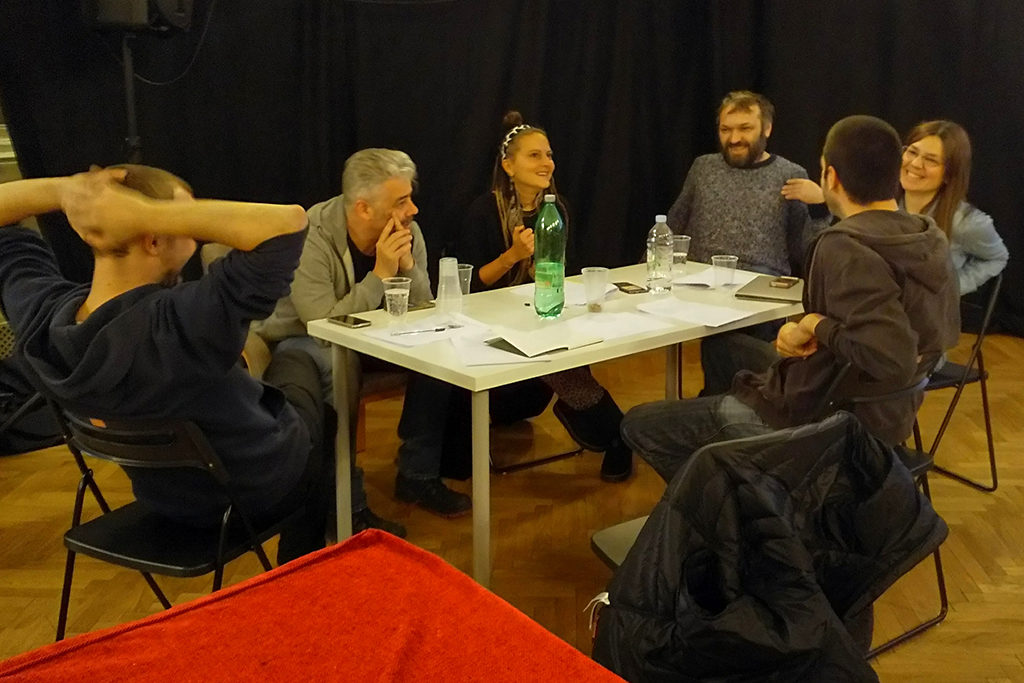
13.30 – 17.30 – Kei Kreutler, Sarah Meiklejohn, Laura Wallis, Jaya Klara Brekke
Doing Good (on the blockchain) is the third event in the DAOWO blockchain laboratory and debate series for reinventing the arts.
In previous workshops we have probed ideas focusing on developments for blockchain application in the arts and the role of identity within the blockchain ecosystem.
Citizen groups that engage in activism and ‘doing good’ are generally structured around informal economies which rely on a certain degree of flexibility, improvisation and indeterminacy of activity. The introduction of technical systems can have a flattening effect that removes all contingency from a system. It sets distinct rules under which an activity or exchange can take place. These rules however can be somewhat opaque, shaped by the affordances of technologies rather than the needs of its users. This event aims to examine what is at stake in the formalisation of ‘doing good’ under blockchain systems for decentralised trust. We will look at how informal systems (e.g. for organising migration from war zones to stable territories) are forced into a formalised rule based structure, while formal systems for public good (eg distribution of social welfare) may exacerbate issues of both exclusion and monitoring. We consider design for contingency, and identify what must be left out.
The Right Systems For The Job?
Sarah Meiklejohn will set the scene sharing her research into developments in systems of decentralised trust, openness and visibility in finance, supply chains, and managing personal data.
This will be followed by 3 provocations that will inform discussion and debate:
Increased Engagement & Resisting De-facto Centralisation
Jaya Klara Brekke on the affordances of Faircoin blockchain technology, exploring its use as a redistribution of what is possible, and for who – extending and reconfiguring spaces and modes of politics.
Incentives for Participation
Laura Willis, on the work of Citizen Me – a platform that promotes the understanding of the value of personal data through notions of citizenship.
Behaviour under Transparency
Kei Kreutler (Gnosis) on blockchain’s potential ability to encode and incentivize social behavior, both on- and off-chain, and designing for unforeseen consequences. How does the figure of the good—politically and aesthetically—influence the uptake of “new” technologies, and how do staked predictions influence the present?
This workshop is devised by Ruth Catlow (Furtherfield) and Ben Vickers (Serpentine) in collaboration with Goethe-Institut London and in partnership with Dr Sarah Meiklejohn from UCL, as part of the research project Glass Houses – Transparency and Privacy in Information Economies.
Sarah Meiklejohn
Sarah Meiklejohn is a Reader in Cryptography and Security at University College London. She has broad research interests in computer security and cryptography, and has worked on topics such as anonymity and criminal abuses in cryptocurrencies, privacy-enhancing technologies, and bringing transparency to shared systems.
Jaya Klara Brekke
Jaya Klara Brekke writes, does research and speaks on the political economy of blockchain and consensus protocols, focusing on questions of politics, redistribution and power in distributed systems. She is the author of the B9Lab ethical training module for blockchain developers, and the Satoshi Oath, a hippocratic oath for blockchain development. She is based between London, occasionally Vienna (as a collaborator of RIAT – Institute for Future Cryptoeconomics) and Durham University, UK where she is writing a PhD with the preliminary title Distributing Chains, three strategies for thinking blockchain politically (distributingchains.info).
Laura Willis
Laura Willis works as Design Lead in user experience at CitizenMe. Alongside this work Laura is also very passionate about illustration and won an award for Macmillan children’s books before she graduated from University of the Arts, London.
Kei Kreutler
Kei Kreutler is a researcher, designer, and developer interested in how cultural narratives of technologies shape their use. She contributes to a range of projects—from the networked residence initiative unMonastery to the augmented reality game for urban research PATTERNIST—related to organizational design and practice. She is Creative Director at Gnosis, a forecasting platform on the Ethereum blockchain, and lives in Berlin.
The DAOWO programme is devised by Ruth Catlow (Furtherfield) and Ben Vickers (Serpentine Galleries & unMonastery) in collaboration with the Goethe-Institut London, and the State Machines programme.
This project has been funded with the support from the European Commission. This communication reflects the views only of the author, and the Commission cannot be held responsible for any use which may be made of the information contained therein.
We are delighted to share with you our Spring season of art and blockchain essays, interviews and events, offering a wide spread of exploration and critique.
The blockchain is an evocative concept, but progress in ideas of cryptographic decentralisation didn’t stop in 2008. It’s helpful for artists to get a sense of the plasticity of new technical media. So first we are pleased to share with you Blockchain Geometries a guide by Rhea Myers to the proliferation of blockchain forms, ideas and their practical and imaginative implications.
In Moods of Identification Emily Rosamond writes her response to our second DAOWO workshop, Identity Trouble (on the blockchain). She reflects on both ongoing attempts to reliably verify identity, and continuing counter-efforts to evade such verifications.
Mat Dryhurst and Holly Herndon speak here with Marc Garrett in an interview republished from our book with Torque Editions Artists Re:Thinking the Blockchain (2017). Mat and Holly convey a sense of excitement about developments and opportunities for new forms of decentralised collaboration in music.
Finally you can book your place on future events at the DAOWO blockchain laboratory and debate series for reinventing the arts.1 Download the DAOWO Resource #1 for key learnings, summaries of presentations, quotes, photographs, visualisations, stories and links to videos, audio recordings and much more from our first two events about developments in the arts and the trouble with Identity.
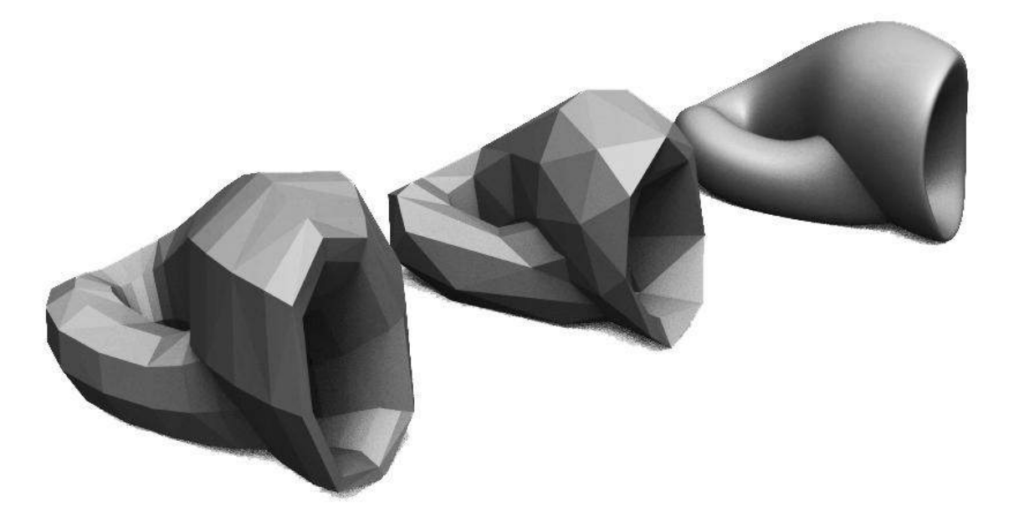
The blockchain is 10 years old and is surrounded with a hype hardly seen since the arrival of the Web. We’d like to see more variety in the imaginaries that underpin blockchains and the backgrounds of the people involved because technologies develop to reflect the values, outlooks and interests of those that build them.
Artists have worked with digital communication infrastructures for as long as they have been in existence, consciously crafting particular social relations with their platforms or artwares. They are also now widely at work in the creation of blockchain-native critical artworks like Clickmine by Sarah Friend2 and Breath (BRH) by Max Dovey, Julian Oliver’s cryptocurrency climate-change artwork, Harvest (see featured image) and 2CE6… by Lars Holdhus3, to name but a few.
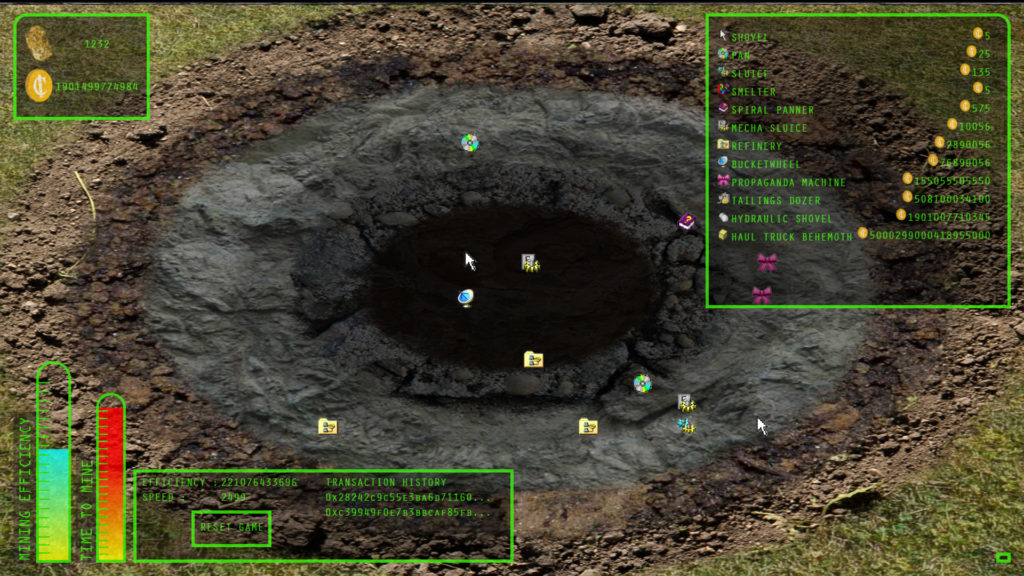
By making connections that need not be either utilitarian nor profitable, artists explore potential for diverse human interest and experience. Also, unlike on blockchains, where time moves inexorably forward (and only forward) – fixing the record of every transaction made by its users, into its time slot, in a steady pulse, one block at a time – human imaginative curiosity can scoot, meander and cycle through time, inventing and testing, intuiting and conjuring, possible scenarios and complex future worlds. They allow us to inhabit, in our imaginations, new paradigms without unleashing actual untested havoc upon our bodies and societies.
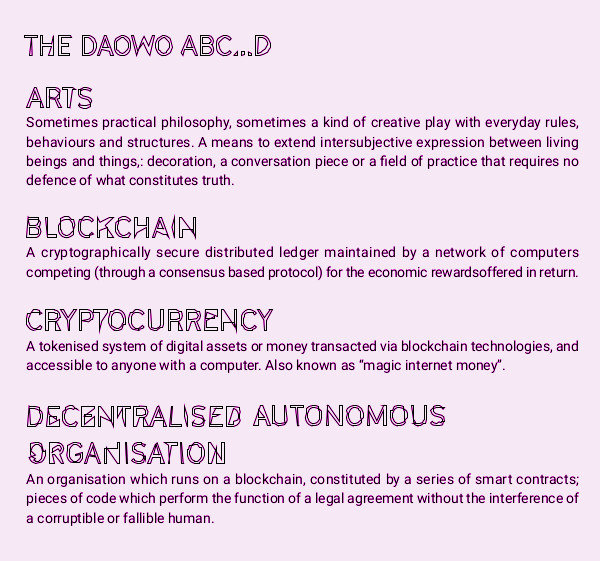
Back in 2008 the global banking system was bailed out by governments with tax payers’ money. Meanwhile a 15 year explosion of web-inspired, decentralised, mutualist-anarchist DIWO (Do It With Others)-style cultural actions and practices ebbed (though its roots remain and go deep). The global network of human attention and resources were, by this time, well and truly re-centralised. The “big five” now owned, and often determined, our communication and expression. Post-Internet artists rejected platform-building as a social artform and instead, took as their materials, lives mediated through social media and corporate owned platforms. Some dived into the marketing vortex, to revel and participate in the heightened commodification of art.
With the introduction of the blockchain protocol on the Internet we see a reversed direction of travel in the artworld, with major developments coming more quickly from the businesses of art, which reassert art’s primary status as an asset class, than from those artists experimenting with new forms of experience and expression enabled by its affordances. Now intermediaries of art world business are moving into blockchains (also sometimes called the “Internet of money”) with a focus on provenance, authentication, digital arts made scarce again with IP tracking, fractional ownership, securitisation and auction4. It is blockchains for art, any art, as long as that art can be owned and commodified. This may be seen as a good thing, generating and distributing increased revenues to ‘starving artists’. Also perhaps inevitable, as that which cannot be owned is hard to represent on a blockchain ledger.
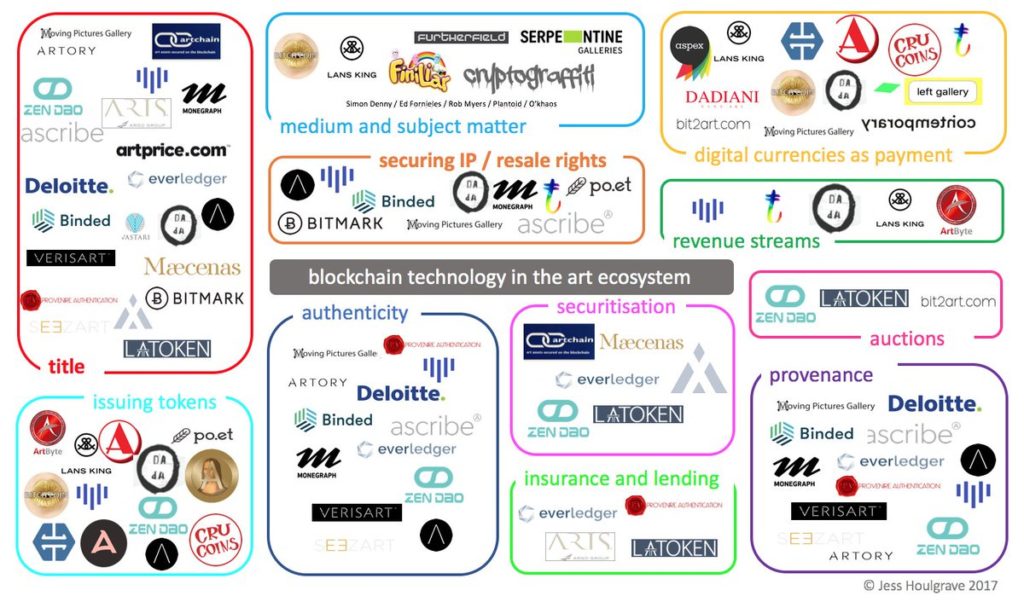
In his new book Reinventing democracy for the digital condition, (2018) Felix Stalder notes that people are increasingly actively (voluntarily and/or compulsorily) participating in the negotiation of social meaning through the “referentiality, communality, and algorithmicity, […] characteristic cultural forms of the digital condition”. In 2015 the Ethereum blockchain launched with a new layer that could run “smart contracts”, pieces of code which act as autonomous agents, performing the function of a legal agreement without the interference of a corruptible or fallible human5. These can be combined to perform as blockchain-based companies called Distributed Autonomous Organizations (DAOs) and there are a plethora of blockchain implementations and political agendas now developing. How these unfurl will affect our ability to relate to each other, to deliberate, decide and cooperate with each other as individuals, organisations and societies.
So for us the promise lies in platform-building: by-and-for communities of experimental artists (in the expanded sense of the word), participants and audiences who want to create not just saleable or tradeable art objects6 but artworks that critique the relationship between art and money, and expand the contexts in which art is made and valued.
‘AltCoins, cryptotokens, smart contracts and DAOs [Digital Autonomous Organisations] are tools that artists can use to explore new ways of social organisation and artistic production. The ideology and technology of the blockchain and the materials of art history (especially the history of conceptual art) can provide useful resources for mutual experiment and critique’ – Rhea Myers7
While FairCoin (being rolled out by FairCoop with the Catalan Integral Cooperative) puts new forms of decentralised social organisation into practice on the ground, blockchain based art projects such as Terra0 and Plantoid by O’khaos offer examples of governance systems and invite us to critically “imagine a world in which responsibility for many aspects of life (reproduction, decision-making, organisation, nurture, stewardship) are mechanised and automated.”8 Both artworks demonstrate functioning systems and help us to think through how we might determine and distribute artistic (and other) resources, their value, and the rules for their co-governance for the kinds of freedoms, commonalities and affiliations that are important for the arts.
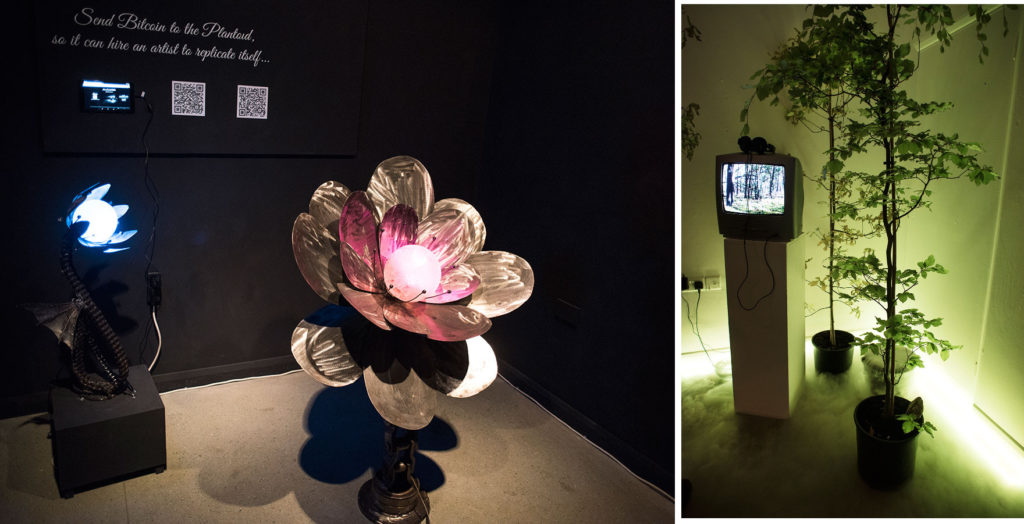
It may take a while. What to value and how to value it is a particularly tangled question. The technical infrastructure of the blockchain is at the stage of development that the Web was at in the early 90s (blockchain technologies are less forgiving, require deeper programming knowledge and are therefore more expensive to build than web pages or platforms) which, along with the get-rich-quick vibe of non-community-platform projects, might be why there are still so few community platforms actually in operation. Resonate.is the cooperatively owned music streaming service is an inspiration in this regard. It is a platform for musicians – creators and listeners – that opens up the governance of its resources to everyone who has ever created or listened to its music. It demonstrates one way in which a DIWO ethos might work.
Helen Kaplinsky is exploring how to bootstrap to the blockchain, Maurice Carlin’s Temporary Custodians project which realises an alternative system of peer2peer art ownership and stewardship at Islington Mill9.
Three preoccupations dominate 2018 New Year blogs and commentary that mark the blockchain’s 10th anniversary: blockchains as cash cults; doubts about the actual utility of blockchains and; the environmental impact of Bitcoin (still, erroneously interchangeable with the blockchain in the minds of lots of people). We add to these our concern about the intensification of control enabled by these infrastructures, AND the simultaneous conviction (shaped by deep collaborations and hard criticisms over the last years) that blockchains have the potential to enable and stimulate new forms of social organisation, resource distribution and collaboration in the arts.
The first two preoccupations match exactly the commentary surrounding the early days of the Web and we know how that turned out. The remaining concerns are grist to the mill of our ongoing programme of publications, films, exhibitions and events. The technologies are only now stabilising to allow more grass-roots infrastructural developments.
We invite you to bring your own lens of constructive critique, gather a crowd to debate and explore how we might pull blockchains into art, on the arts’ own terms, and to gain an understanding of why it is worthwhile.
If you’re interested in Furtherfields critical art and blockchain programmes with various individuals, groups and partners since 2015. You could check out how it all started, watch our short film, read this book, visit this exhibition, or archives and documents of previous exhibitions10, 11, read reviews and debate, and join us at our ongoing DAOWO blockchain lab series, devised with Ben Vickers (Serpentine Galleries) in collaboration with the Goethe-Institut London, and the State Machines programme12
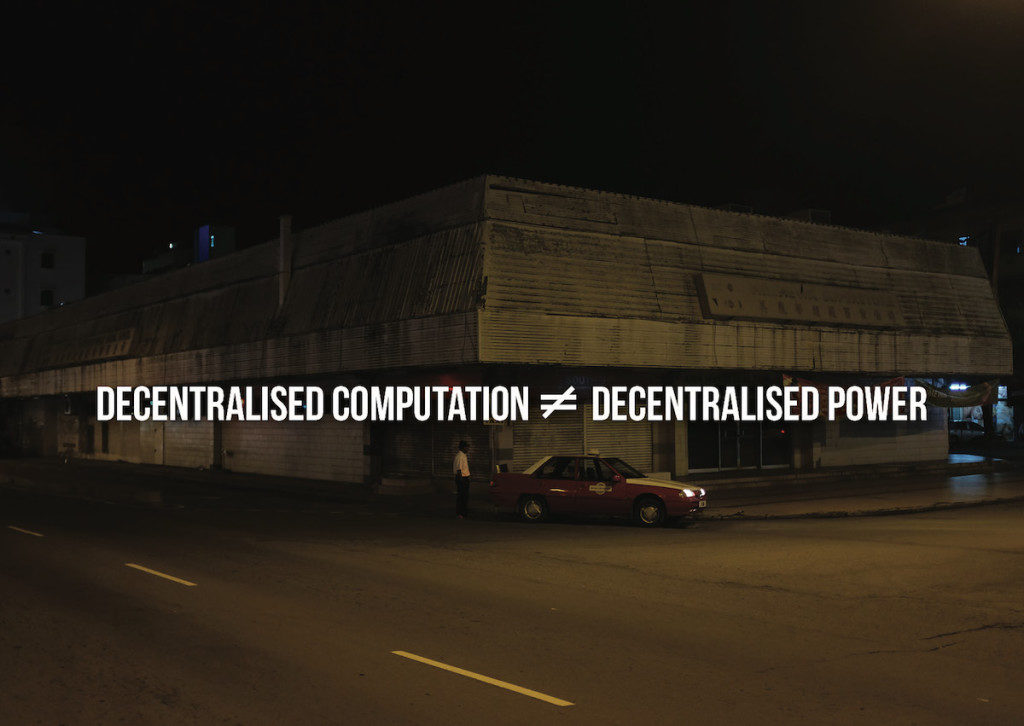
Data structures hold information in a way that makes it easier to be manipulated by software, given particular constraints on computing resources such as the time or space taken up. A linked list takes very little space in a computer’s memory on top of the space taken up by the data it contains and is very quick to add new data to but it is very slow to search from the beginning to the end of the list.
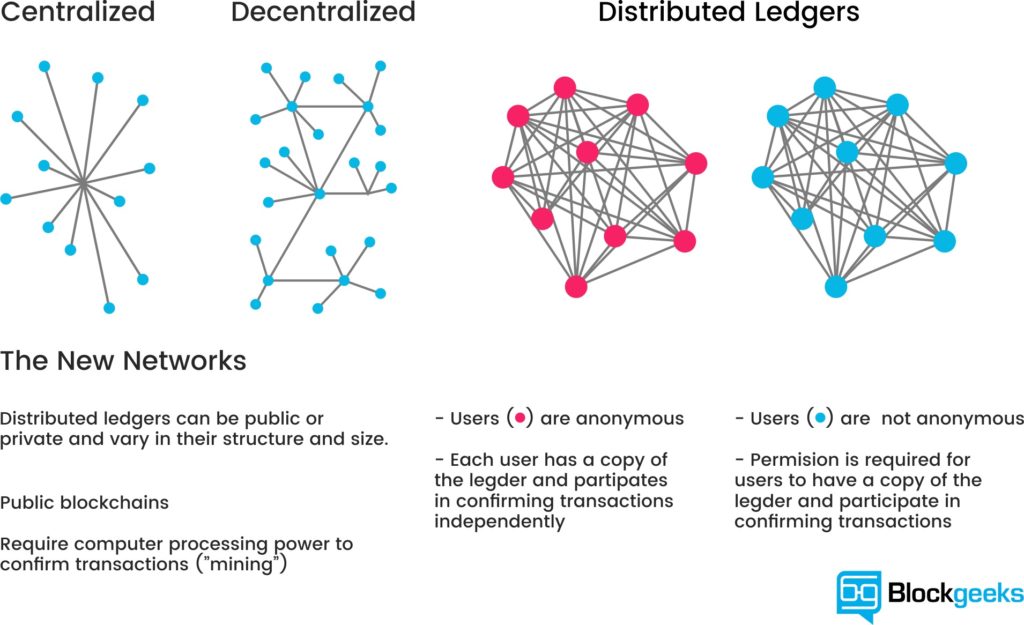
In contrast, a “hash table” data structure makes looking up information much faster by calculating a unique identifier “hash” for each item that can be used as an index entry for the data rather than having to search all the way through a long list of links. Think of a hash as a very large, very unique number that can be reliably calculated for any piece of data – any file containing the text “Hello world!” will have the same cryptographic hash as any other. The cost of this fast access is that the table must be allocated and configured in full before data can start to be stored in it.
A “binary tree” balances speed and storage space by storing data in a structure that looks like a tree with two branches at the end of each branch, creating a simple hierarchy that takes very little initial extra storage space but that given its structure is relatively fast to search compared to a linked list.
Each block in a blockchain is linked to the previous one by identifying it using its (cryptographic) hash value. And the transactions in the block are stored in a (cryptographic hash) tree. This means that a blockchain is a more complex structure than the simple image at the top of this page. But so what? Why should we care about the shape of the blockchain when its social, environmental and political impact seem to be in such urgent need of critique?
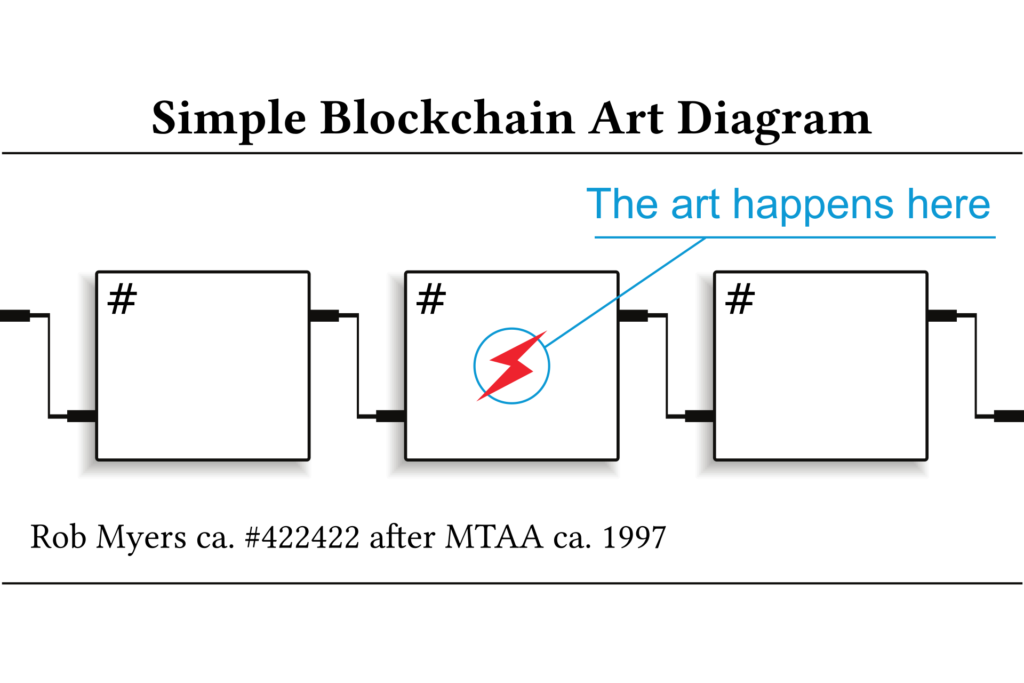
The geometric, techonomic and social form of a blockchain are all related, and understanding one helps us to reason better about the others. As the quick tour through software data structure design above indicates, the constraints on technological form are not abstract, they are tied to real needs and agendas. Bitcoin is no exception to this – the lists and trees that make up its blockchain as they are built and broadcast on a peer-to-peer network by computers competing to claim economic incentives for doing so were chosen very explicitly to exclude the intervention of the state and other “trusted third parties” (such as banks) in authentic economic relationships between peers.
Bitcoin’s algorithms prioritise the security of the blockchain above all else, maximising security like a mythical Artificial Intelligence “paperclipper” maximises the production of a particular material good regardless of the other consequences . This explains Bitcoin’s energy consumption, which whilst lower than the US military or the other equivalent systems that guarantee the security of the dollar is probably still much higher than Satoshi Nakamoto originally envisioned.
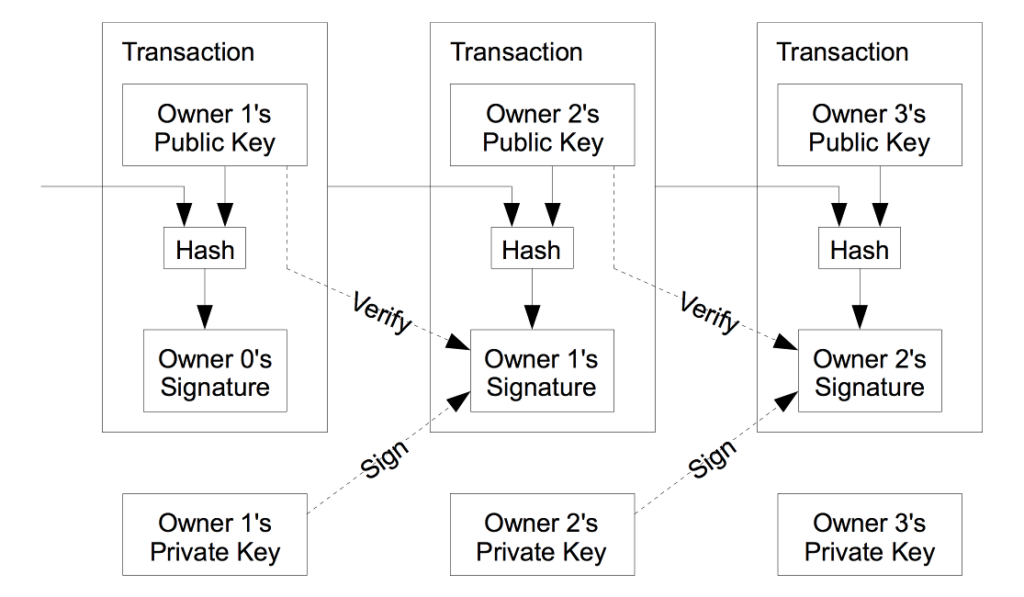
There are other algorithms, though, which have been created since 2008 to address perceived flaws in Bitcoin’s design or to address different ideological agendas. These create different forms, and contrast instructively with that of Bitcoin’s blockchain. Please note that these are experimental and often controversial technologies. Nothing that follows is investment advice.
Bitcoin creates blocks on average every ten minutes. Faster currencies quickly emerged, LiteCoin and Dogecoin are leading examples, with 2.5 minute and one minute block times respectively. Blocks may contain more or fewer transactions, and be more or less frequent even within the same blockchain as the algorithms tweak its parameters to ensure its security. Blockchains have rhythm, they stall or race, each block is larger or smaller and closer or further from the last one. Transactions fan into and out from addresses in each block, with varying values of currency or amounts of data each time. We are now very far from the block-and-arrow diagrams of linked lists indeed.
The Ethereum system, which extends Bitcoin’s financial ledger into a more general system for “smart contracts”, has the smallest block time of any leading cryptocurrency – fifteen seconds. Like the others mentioned it still uses a variant of the energy-hungry “Proof of Work” security system from Bitcoin. In Proof of Work, anyone who wants to add a block of transactions to the list must consume computing resources to solve a puzzle (essentially guessing a large number ending with multiple zeroes). As these resources cost money, anyone willing to expend them must stand to gain more from adding the next block than they lose to their electricity bill. This Game Theory gambit secures a Proof of Work blockchain. The mindlessly focussed, paperclipper nature of blockchain security algorithms means that as more people use more computers to compete to be the next person to add a block to the chain and claim the economic reward for doing so, the difficulty and therefore the amount of electricity required to solve that puzzle has increased massively, growing the energy footprint of cryptocurrency.
Ethereum is planning to switch to a “Proof of Stake” system, like that used in currencies like NXT and Decred (about which more below). Rather than burning electricity like Proof of Work, Proof of Stake uses a blockchain’s own existing currency “staked” by users to demonstrate their standing within the system and to thereby get a chance to be chosen by the network to add the next block. Proof of Stake and its related “Proof of Authority” system move from the “miners” of Proof of Work who operate on the blockchain from outside to a system of capitalist investors or even an aristocratic class of gatekeepers who operate within the logic of the blockchain itself. This folds the blockchain’s outside in on itself.
Bitcoin’s blocks have been fixed at one megabyte in size since a temporary security fix by Satoshi Nakamoto introduced the limit. As Bitcoin usage has grown, blocks have become increasingly full (allegedly often as a result of economic “spam” attacks intended to manipulate prices – competing for space in blocks drives up transaction fees which can in turn discourage users and ultimately drive down the price of Bitcoin). How should this problem be addressed – how should Bitcoin scale? Should the number of transactions stored in the blockchain grow, increasing the block size limit and making it harder for individuals to store the blockchain on consumer hardware in a decentralised manner? Or should transactions be somehow moved “off-chain” into “second-tier” systems that build on top of the blockchain, adding complexity and introducing potential new choke-points for existing capital to exploit? Big blocks or small blocks (like the big or little ends of eggs, or integers…)? This is a real debate in the Bitcoin world, and illustrates how the consequences of a simple change in technical form like, for example, increasing block sizes from one to two megabytes, can have profound effects on the social and economic form of a cryptocurrency. “Big blockers” propose solutions like the breakaway “Segwit2X” or “Bitcoin Cash” systems, scaling “on-chain” with ever greater amounts of data in the same structures. “Small blockers” propose solutions that move data out of the blockchain, into “Segregated Witnesses” that store cryptographic signatures outside of the blockchain, or the cybernetic rhizomes of “Lightning Networks”.
A Lightning Network adds a second peer-to-peer network of nodes that pass transactions between themselves. These are all valid Bitcoin transaction data structures, but unlike the main Bitcoin peer-to-peer network they are not immediately broadcast to the main Bitcoin network to be bundled up into blocks. Rather they can be replaced at any moment by new transactions, sending different amounts of cryptocurrency along a “channel” between one or (most often) more participants arranged in a random network like the one used by the Tor privacy network.
It’s an elegant but sometimes complex solution, and one that triggers moral panic within some elements of the Bitcoin community equivalent to that triggered by Bitcoin within some elements outside of it. Lightning Nodes with more Bitcoin can extract more fees from Lightning Network transactions, to be sure, and this is a form of centralisation. Decentralisation’s value to cryptocurrency is as a concrete guarantor of security, and Bitcoin’s value is its security. But individuals can still run Lightning Network nodes and send transactions between each other, and pools of capital already have centralising effects in exchanges and mining cartels.
Techniques similar to those used to move transactions off-chain by Lightning Networks can be used to move value between different blockchains without exchanges centralising the process. “Atomic Swaps”, the “Plasma” system and the realisation of the previously mythical “Doge-Ethereum bridge” using the TrueBit system are all different ways of building wormholes between the separate universes of individual blockchains.
Another approach to scaling is borrowed from conventional database design: breaking the blockchain into smaller and smaller pieces or “shards“, forming another tree structure, allows each group of users of the blockchain to only have to keep track of the part that contains the transactions they are interested in. The Ethereum blockchain will move to sharding in future, after its switch to Proof of Stake. Sharding destroys the metronomic, panopticonic unity of the blockchain to create islands of transactions whose truth is local to them, a non-monotonic logic that makes moving value and information between shards difficult but still not impossible.
CryptoKitties can go on their own shard, the Gnosis prediction market on another one, and if one needs to bet on something kitty-related this will require communicating cross-shard. From islands in the net to islands in the blockchain. Techonomically, the data structures and economic incentives of such a system are more complex than a unified blockchain, but making access to the network cheaper by requiring each user to store less data to send their transactions restores the blockchain’s initial low barrier of entry.
Deciding how to scale is a matter of governance. The Decred cryptocurrency has put governance front and centre. As well as moving to a hybrid Proof of Work / Proof of Stake system it has implemented an “on-chain-governance” system. Decred contains the forum for its own critique and transformation, implemented as an extension of the staking and voting system used by its Proof of Stake system. On-chain governance is controversial but addresses calls to improve the governance of cryptocurrency projects without falling prey to the off-chain voluntarism that can result from a failure to understand how the technomic and social forms of cryptocurrencies relate in finely-tuned balance.
Some post-Bitcoin systems move further away from the form of a chain or do without them altogether. The Holochain system gives each user their own personal blockchain and stores a link to it in a global “Distributed Hash Table” of entries (like that used by the BitTorrent system), a forest of trees rather than a tree of shards. This possibly solves the bandwidth problem of simple blockchain technology but weakens some of their strengths in a trade off of convenience against long-term security and robustness. Iota (the most controversial technical design discussed here) doesn’t have a blockchain at all. It uses a “tangle” of transactions, within which each new transaction must do the Proof of Work of validating several previous transactions. This seems like an ideal restoration of the original vision of Bitcoin as a peer-to-peer currency, solving the problems centralisation and energy usage, but the current Iota network is in fact heavily centralised by its reliance on nodes controlled by the Iota foundation to secure it.
IPFS is not a cryptocurrency and does not use a blockchain but it complements the blockchain technologically and often socially. IPFS is related to blockchain technology in its use of cryptography and the logic of game theory but also as a popular way of storing information that is too large to fit on the blockchain. And in its use of a cryptocurrency token – “Filecoin” – to pay for storage on its main network. Filecoin was released in an “Initial Coin Offering” in 2017, and that is all we will say about ICOs here… IPFS uses a “Merkle DAG”, a network of links similar to the World Wide Web or a filesystem, but with each item (the pages or files) represented not by a human-given name but by the cryptographic hash of its content. “Merkle” refers not to the German Chancellor but to the computer scientist who described this use of cryptographic hashes in a tree data structure (like that used in Bitcoin). “DAG” is an acronym for “Directed Acyclic Graph” – a network with no loops in it because loops would confuse the algorithm. IPFS distributes content using a “market” algorithm, bartering for blocks of data on the network with Filecoin or with other blocks.
Each of these pocket universes of social and economic reality has its own structure and forms, its own space and geometry. Chains, and being on or off of them. Blocks of different sizes and fullness, with varying distances between them. Channels, rhizomes, shards, tangles, mines and thrones. Forests, tables, graphs, markets and identities. These formal differences distinguish different cryptocurrencies technologically and politically. Algorithmic differences are ideological differences, this is not an external critique it is internal to the logic of cryptocurrency – algorithms are changed to better instantiate what is just. These algorithmic differences produce formal differences. Their surplus value and unintended consequences continue this process of critique-in-code.
The question of the shape of the blockchain opens up onto a space of technomic, geometric and social forms. We can move through the hyperspace containing and relating these forms to the specific spaces of individual blockchains that are built around them, through the constraints and agendas that they reflect, out into wider society. The gaps and overlaps in this space indicate useful problems for the work of development or critique. Given this, geometries and forms are at least as useful a navigational marker as professed intentions or revealed preferences. But only if we can imagine and visualise them.
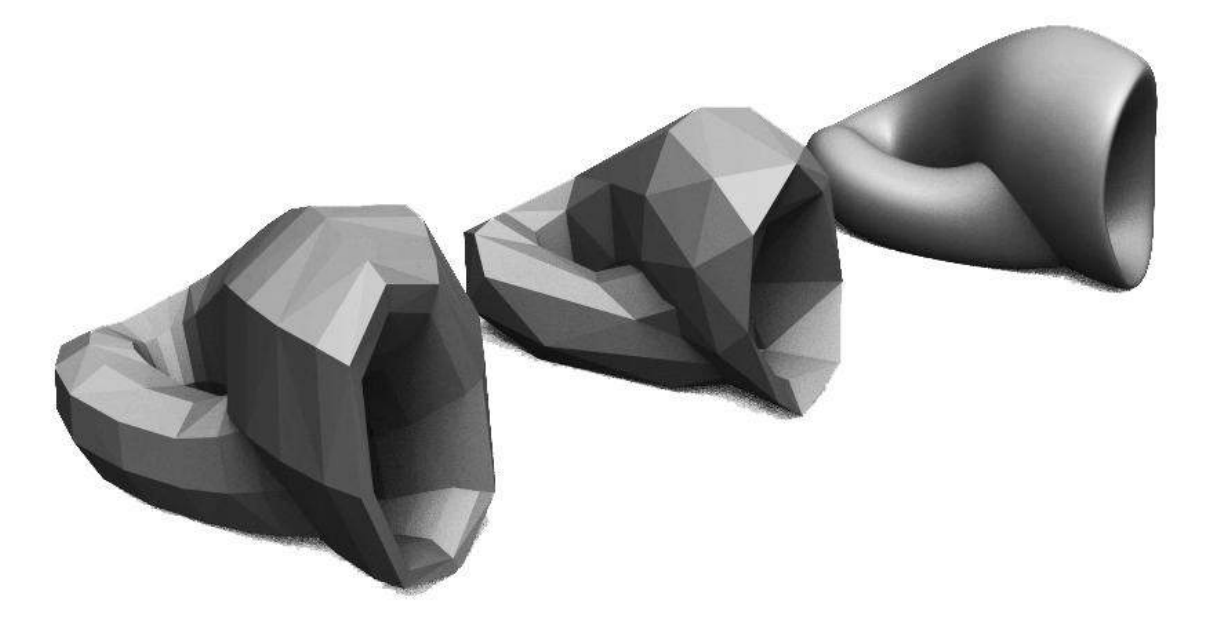
Art deals in form, from the spatial volumes of Renaissance perspective to the choreography and logistics of Relational and Contemporary art. Whether promoting, like Jessica Angel’s public art envisioning of the Doge-Ethereum bridge as a Klein Bottle, critiquing or simply rendering perceptible the very different kinds of form that make up the geometric, technomic and social forms of the blockchain and the relationships between them, art has the unique potential to uncover the true shape of the blockchain.
Image notes:
Simple Blockchain Art Diagram, by Rhea Myers. 2016
What the Silk Road bitcoin seizure transaction network looks like, Reddit
This essay is a response to Identity Trouble (on the blockchain), the second in the DAOWO lab series for blockchain and the arts. Rosamond reflects on both ongoing attempts to reliably verify identity, and continuing counter-efforts to evade such verifications.
Online transactions take place in a strange space: one that blurs the distinctions between the immediate and the remote, the intimate and the abstract. Credit card numbers, passing from fingers to keyboards to Amazon payment pages, manage complex relations between personal identity and financial capital that have been shifting for centuries. Flirtations on online dating platforms – loosely tied to embodied selves with a pic or two and a profile – constitute zones of indistinction between the intimate spheres of the super-personal, and hyper-distributed transnational circuits of surveillance-capital. Twitter-bot invectives mix with human tweets, swapping styles – while all the while bot-sniffing Twitter bots try to distinguish the “real” from the “fake” voices[1]. Questions of verification – Who is speaking? Who transacts? – proliferate in such spaces, take on a new shape and a shifted urgency.
How does personal identity interface with the complex and ever-changing technical infrastructures of verification? How is it possible to capture the texture of “identity trouble” in online contexts today? The second in the DAOWO event series, “Identity Trouble (on the blockchain),” addressed these questions, bringing together a range of artists, developers and theorists to address the problems and potentials of identification, using technical apparatuses ranging from blockchain, to online metrics, to ID cards and legal name changes. The day included reflections on both ongoing attempts to reliably verify identity, and continuing counter-efforts to evade such verifications.
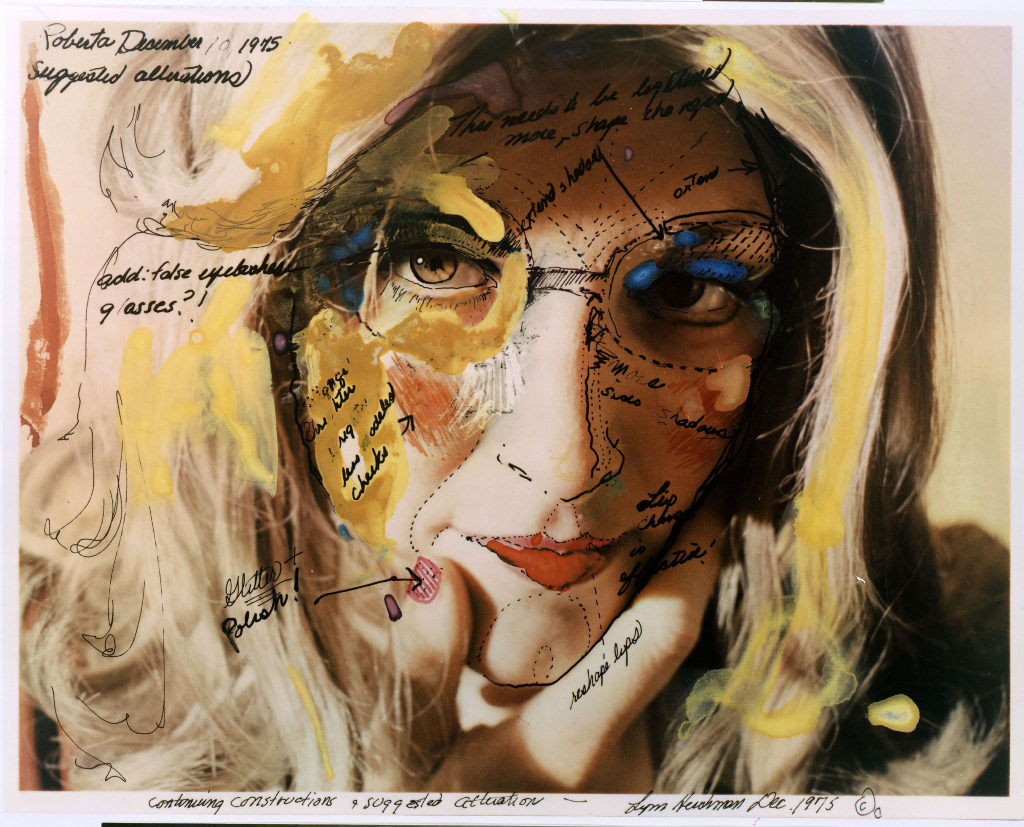
Before going into the day in any detail (and at the risk of going over some already well-trodden ground), I want to try to piece together something which might – however partially – address the deeper histories of the problems we discussed. Of course, identity was an elusive concept long before the internet; and the philosophical search to understand it has run parallel to a slow evolution in the technical and semiotic procedures involved in its verification. In fact, seen from one angle, the period from the late nineteenth century to present can be understood as one in which an increasing drive to identify subjects (using photo ID cards, fingerprints, signatures, credit scores, passwords, and, now, algorithmic/psychometric analysis based on remote analysis of IP address activity) has been coupled with a deep questioning of the very concept of identity itself.
On the one hand, as John Tagg describes, in the second half of the nineteenth century, the restructuring of the nation-state and its disciplinary institutions (“police, prisons, asylums, hospitals, departments of public health, schools and even the modern factory system itself”[2]), depended on creating new procedures for identifying people. This involved, among other things, yoking photography to the evidentiary needs of the state – for instance, through Alphonse Bertillon’s anthropometric identity card system, invented in 1879 and adopted by French police in the 1880s. The identity cards, filed by police, included suspects’ photographs and measurements, and helped them spot repeat offenders.
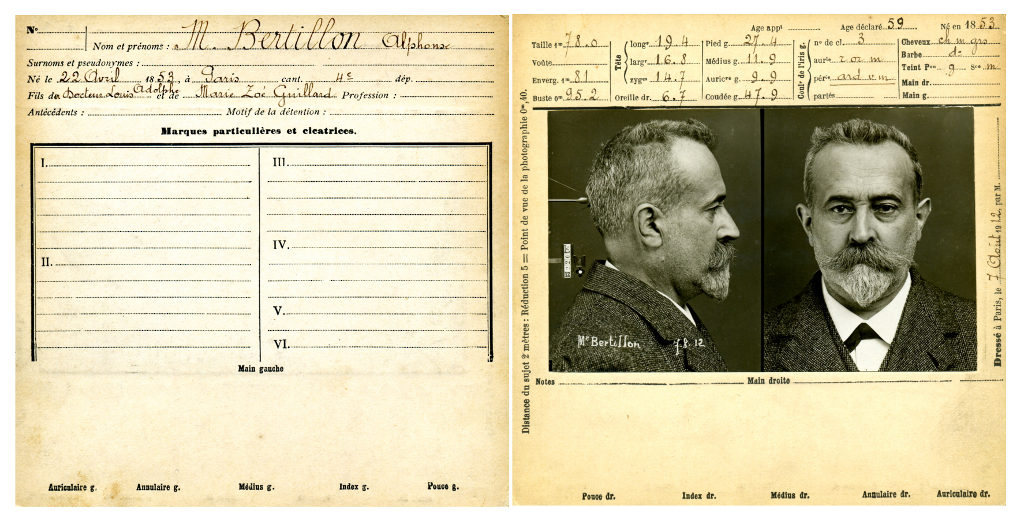
This impulse to identify, it seems, has only expanded in recent times, given the proliferation of biometric and psychometric techniques designed to pin down persons. On the biometric end of this spectrum, retinal scans, biometric residence permits and gait recognition technologies manage people’s varying levels of freedom of movement, based on relatively immutable bodily identifiers (the retina; the photographic likeness; the fingerprint; the minute particularities of the gait). On the psychometric end of the spectrum, private companies calculate highly speculative characteristics in their customers by analysing their habits – such as “pain points.” The American casino chain Harrah’s, for instance, pioneered in analysing data from loyalty cards in real time, to calculate the hypothetical amount of losses a particular gambler would need to incur in order to leave the casino. The pain point – a hypothetical amount of losses calculated by the company, which may be unknown to the customer herself – then provided the basis for Harrah’s’ real-time micro-management of customer emotion, enabling them to send “luck ambassadors” out onto the floor in real time to boost the spirits of those who had a bad day [3].
On the one hand, then, identification apparatuses have become ever more pervasively intertwined with the practices of daily life in industrialized societies since the latter half of the nineteenth century; this produced new forms of inclusion and exclusion of “exceptional” subjects within various institutional regimes. On the other hand, just as the technical and semiotic procedures associated with verifying identity were proliferating and becoming ever harder to evade, modern and postmodern thinkers were deeply questioning what, exactly, could possibly be identified by such procedures – and why identity had become such a prominent limiting condition in disciplinary societies. James Joyce’s character Stephen Dedalus marvels at the lack of cellular consistency in the body over a lifetime. While an identifying trait, such as a mole on the right breast, persists, the cells of which it is made regenerate repeatedly. (“Five months. Molecules all change. I am other I now.” [4]) How, then, can debts and deeds persist, if the identificatory traits to which they are indexed are intangibly inscribed in an ever-changing substrate of cellular material?
In the mid-twentieth century, Foucault and Barthes deeply questioned the limitations identity imposed on reading and interpretation. Why, for instance, need authorship play such a prominent role in limiting the possible interpretations of a text? “What difference does it make who is speaking?” [5]
In ’nineties identity discourse, theories of difference became particularly pronounced. Cultural theorists such as Stuart Hall radically questioned essentialist notions of cultural identity, while nonetheless acknowledging the political and discursive efficacy of how identities come to be narrated and understood. Hall and others advocated for a critical understanding of identity that emphasized “not ‘who we are’ or ‘where we came from’, so much as what we might become, how we have been represented and how that bears on how we might represent ourselves. Identities are… constituted within, not outside representation.” [6]
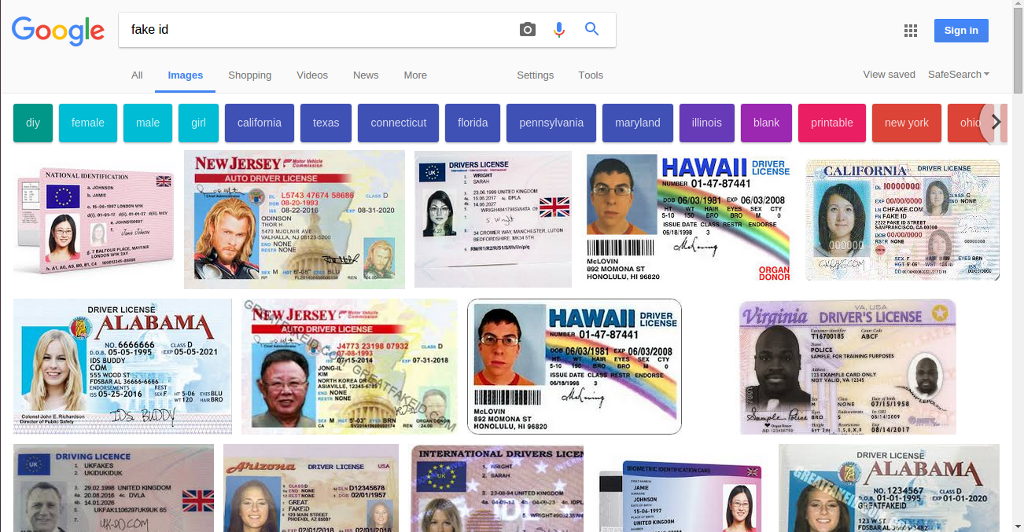
On the one hand – so I have said – myriad technical apparatuses have aimed to ever more reliably capture and verify identity. On the other hand, myriad critical texts have questioned identity’s essentialist underpinnings. But today, these lines have become blurred. The anti-identitarian mood permeates technical landscapes, too – not just theoretical ones. Fake IDs, identity theft, and other obfuscations have grown ever more complex alongside apparatuses for identification; indeed, such fakeries have both emerged in response to, and driven yet further developments in technologies for identity verification as is the case in a Fully-Verified system. The frontiers of identification are ever-changing; each attempt to improve technologies for verifying identity, it seems, eventually provokes the invention of new techniques for evading those verifications.
At the inherently uncertain point of contact between person and online platform, new forms of anti-identifications are practiced – invented or adapted from previous stories. In one bizarre example from 2008, a Craigslist advert posted in Monroe, Washington requested 15-20 men for a bit of well-paid maintenance work. The men were to turn up at 11:15 am in front of the Bank of America, wearing dark blue shirts, a yellow vest, safety goggles and surgical masks. As it turned out, there was no work to be had; instead, the men had been summoned to acts as decoys for a robbery – a squid-ink trail of similarity to help the thief escape. The idea, though inventive, wasn’t entirely original; it was described by police as a possible copycat of the plot in the film The Thomas Crown Affair (1999) [7.
Today, the anti-identitarian mood has spread far beyond small-scale manoeuvers like this. Multiple large-scale data breaches – such as the recent Equifax breach, which compromised the data of over 145 million customers [8] – have put a cloud over the veracity of millions of people’s online identities. The anti-identitarian mood becomes broad, pervasive, and generalized in data-rich, security-compromised environments. It becomes a kind of weather – a storm of mistrust that gathers and subsides on the level of infrastructures and populations.
Such are some of the complexities that the DAOWO speakers had to contend with. At the Goethe Institute, we thought through some of the ways in which identities are being newly constituted within representation – ways that might, indeed, answer to the technical and philosophical problems associated with identification. Backend developer Thor Karlsson led us through his company Authenteq’s quest to provide more reliable online identity verification. Citing the ease with which online credit card transactions can be hacked, and with which fake accounts proliferate, Karlsson described Authenteq’s improved ID verification process – a digital biometric passport, using blockchain as its technical basis. Users upload a selfie, which is then analysed to ensure that it is a live image – not a photograph of a photograph, for instance. They also upload their passport. Authenteq record their verification, and return proof of identity to users, on the BigChainDB blockchain.
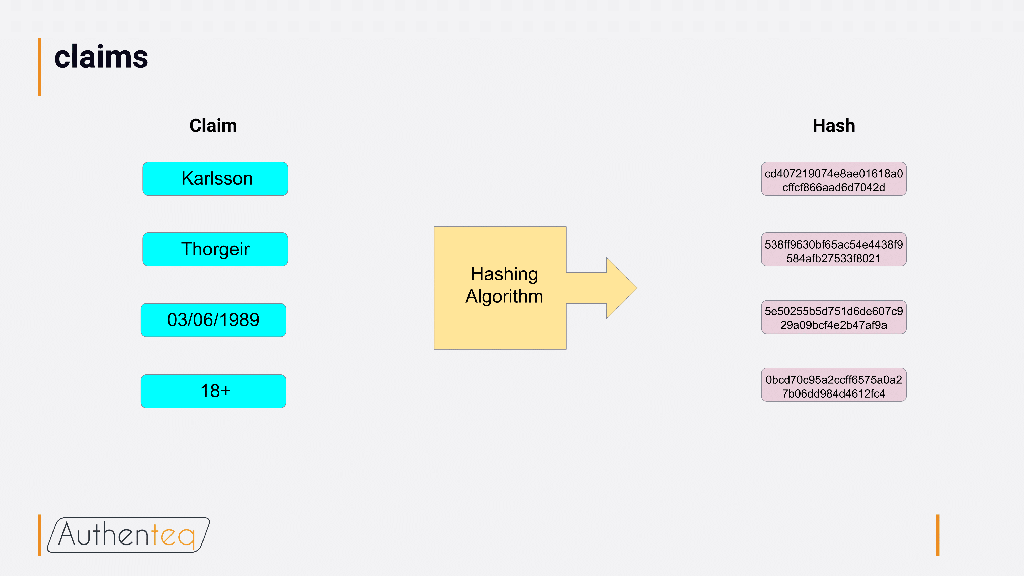
A hashing algorithm ensures that users can be reliably identified, without a company having to store any personal information about them. Authenteq aims to support both identity claim verifications and KYC (Know Your Customer) implementations, allowing sites to get the information they need about their users (for instance, that they are over 18 for adults-only sites) without collecting or storing any other information about them. Given how much the spate of recent large-scale data breaches has brought the storage of personal data into question, Authenteq’s use of blockchain to circumvent the need to store personal data promises a more secure route to verification without revealing too much of personal identity.
Nonetheless, while Karlsson and Authenteq were optimistic that they can make meaningful improvements in online identification processes, other provocations focused on the potential problems associated with such attempts at identification – on the protological level, on the level of valuation, and on the level of behaviour-as-protocol. Ramon Amaro delivered an insightful critique of blockchain and the problem of protological control. There is no such thing as raw data – inputs are always inflected by social processes. Further, the blockchain protocol relies heavily on consensus (with more focus on consensus than on what, exactly, is being agreed upon) – which reflects a need to protect assets (including identity) and oust enemies that is, ultimately, a capitalist one. Given this, how can identity manoeuver within the blockchain protocol, without always already being part of a system that is based on producing inclusions and exclusions – drawing lines between those who can and cannot participate?
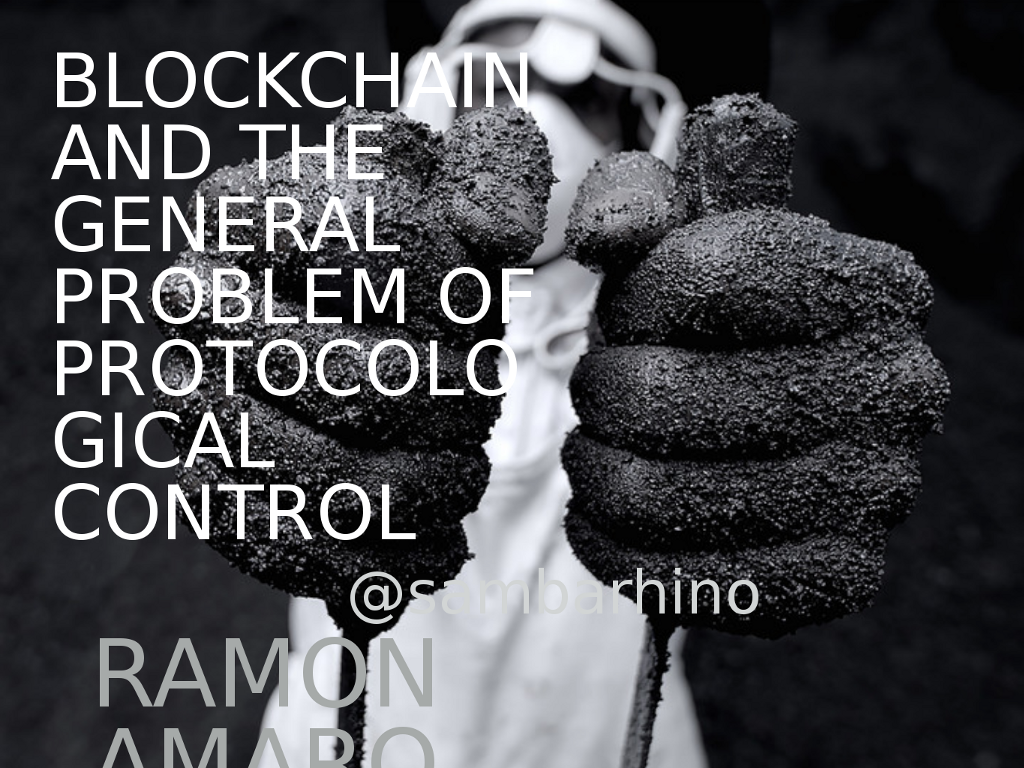
My own contribution focused on systemic uncertainty in the spheres of personal valuation, looking at online reputation. In a world in which online rankings and ratings pervade, it seems that there is a positivist drive to quantify online users’ reputations. Yet such apparent certainty can have unexpected effects, producing overall systemic volatility. At the forefront of what I call “reputation warfare,” strategists such as Steve Bannon invent new ways to see systemic reputational volatility as a source of value itself, producing options for the politicians they represent to capitalize on the reputational violence produced on sites like 4chan and 8chan.
While these contributions reflected on some of the critical problems associated with pinning down identity’s value, some of the artists’ contributions for the day focused on the ludic aspects of identity play. Ed Fornieles’ contribution focused on the importance of role play as a practice of assuming alternate identities. In his work, this involves thinking of identity as systemic, not individual – and considering how it might be hacked. In many of Fornieles’ works, this involves focusing attention on the relation between identity and the platforms on which they are played out. Behaviour becomes a kind of protocol; role play becomes a reflection on strands of behaviour as protocol.

We ended the day with a screening and discussion of My Name is Janez Janša (2012), a film by three artists who, in 2007, collectively changed their names to Janez Janša, to match that of the current president of Slovenia. The film, an extended meditation on the erosion of the proper name as an identifier, catalogued many instances of ambiguity in proper names – from the unintended (an area of Venice in which huge numbers of families share the same last name) to the intentional (Vaginal Davis on the power of changing names). It also charted reactions to the three artists’ act of changing their name to Janez Janša. What seemed to confound people was not so much that their names had been changed, but rather that the intention of the act remained unclear. In the midst of today’s moods of identification, there are high stakes – and many clear motives – for either obscuring or attempting to pinpoint identity. Given this, the lack of clear motive for identity play seems significant; by not signifying, it holds open a space to rethink the limits of today’s moods of identification.
The DAOWO programme is devised by Ruth Catlow and Ben Vickers in collaboration with the Goethe-Institut London, and the State Machines programme. Its title is inspired by a paper written by artist, hacker and writer Rhea Myers called DAOWO – Decentralised Autonomous Organisation With Others
This interview was originally printed in Artists Re:Thinking the Blockchain published in partnership with Torque Editions in 2017.
Marc Garrett: One of many interesting and experimental things about the album Platform, released with Holly Herndon in 2015, is the decision to break away from the perspective of singular genius, and involve a variety of collaborators. This included artist Spencer Longo, Claire Tolan (of Tactical Tech), and Dutch design studio Metahaven. On the 4AD press release page it says that it ‘underscores the need for new fantasies and strategic collective action.’ Under the name of Holly Herndon, along with Holly, you all became a kind of cooperative, collective construction. What inspired you and Holly to explore what could be seen as a decentralized body, or assemblage of individuals as a collective? Or how would you describe your working identity and the importance of this move?
MD: To put it in pretty boring terms, it has become a core part of our mission to be pretty candid about what we do. Holly had been making albums and touring by herself, and then during the early experiments that later became Platform (Chorus and Home) we had begun working together, as we were occupying this tiny apartment in San Francisco, and I was working on this weird net concrete stuff in one room, and Holly was writing for voice in the other, and I think both of us picked up from the ambient sound that the two worked really well together! For the Chorus video we had seen the work of the Japanese artist Akihiko Taniguchi, and really enjoyed the collaborative process of putting that video together, and so then sought out Metahaven, who we’d been in touch with for some time out of aligned interests. Basically most art production at a certain high level is collaborative, and I think it’s just part of our idealistic view on the world that this be transparent and celebrated. Beyond that, when we were coming up with the vision for Platform it also felt very necessary as a political gesture to make a point of the project being aligned with certain political interests, and a politicized way of working and acknowledging others. Working this way has changed my life, and made everything more fun and exciting without diminishing the importance of any individual contributions. It makes for better results, I feel, better general feeling, and also creates these very tangible collaborative connections between fields. It’s also just an interesting experiment to run in music when it feels like so many sonic experiments have been done to death – I’m personally interested in how decentralized practices, collaboration and connectivity, can change the construction and dissemination of music, and ultimately it’s power to be a force in the world.
HH: It sometimes feels like our society is ‘every person for themselves’. We promote hyper individualism at the cost of the planet and social health, and the music industry largely parrots this mentality. We realized how problematic this is, and if we are going to be true to ourselves, then the practice should reflect that concern. It’s been a learning curve for me; learning to not control every single aspect (I tend to micromanage), to hear other opinions, to let go, and not feel threatened if someone else’s idea is better than my own. Releasing my debut album solo was an important step in building my confidence, however ultimately the work itself is the most important, and not the ego. Not to mention that we spend a lot of time on computers, which can be lonely, so working with other people helps us to unplug and see the world around us a little more.
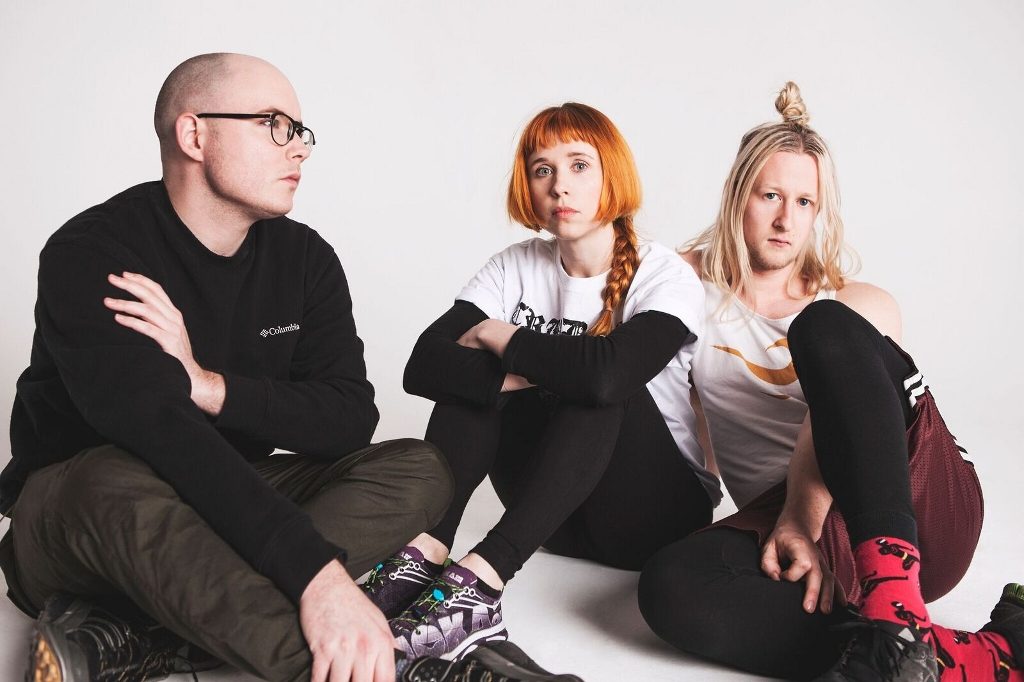
MG: In a world that traditionally, economically and politically, supports the values of individuality above community, or peer to peer collaboration. How did the audience, the music industry, and others in the world (presuming they have) come to terms with this adventurous, creative intention?
HH: It was varied, but overwhelmingly positive. When we were doing press around the record, it was difficult to get some journalists to write about the other artists and thinkers that I was collaborating with, or even just referencing. Those that understood the gesture really embraced the idea, and that successfully provided a platform to highlight everyone’s work.
There are a few industry complications; for example, the project is released under my birth name, so in some ways I am still at the centre of the orbit, which is a problematic professional necessity, but also helps somehow. We used the idea of the Trojan Horse a lot, as in a way my easily understood singular presence served as a gateway into this whole other universe of people. It’s a balancing act, as in various different scenarios you feel different expectations as to what the industry wants; on a pop level they want a simple narrative of my face, and tend to focus on often mundane characteristics such as my gender and education. On other levels you see that the experiment has opened up a different narrative potential, where people’s interest in the record and it’s cast forks off into the direction of their choosing.
It’s really noticeable live, where the audiences have been really supportive. After the shows you experience all kinds of people who come along, hanging out with different people who were on stage – Mat has his own audience somehow, and the same with Colin Self, who often tours with us. As a result of opening up the process and allowing the full breadth of interests and approaches to shine through a little more than is standard, at different shows we have people come up to talk to us about the music, or nerd out about cryptocurrencies and ICO’s, or Chelsea Manning. It feels meaningful, and gratifying for that. We always address the location of the show, whether through the visual or sound, and try to always be alert and responsive. It’s a special privilege to share that time with people, and I think that the concept comes across quite effectively in a live situation as each individual serves a very different purpose in constructing the collective experience.
MD: I think that Platform was received really well. Holly opening up her practice didn’t diminish her signature on the artworks, and I think that it has really won a lot of people over. I think you can feel at our shows that we have a greater principle to what we do, and I think it has maybe made a lot of space for people to conceive of their own experiments and maybe not be concerned at how being ambitious on a conceptual level will affect the ability for the art to travel in the world. Naturally there is also a throttling effect within aspects of the creative industry, where maybe they didn’t want to deal with the bigger ideas around the record, however I feel that the music is strong enough to kind of live in those circles without knowing the story behind it. Overall I think people were refreshed and encouraged by the idea, and transparency of the whole thing. For us now it is a way of being. In my mind, there is more room for individuality to shine when you can guarantee that someone’s work and ideas will be respected and celebrated. The canon of artistic history has omitted so many people’s ideas and contributions for the purpose of having a simpler market narrative, and yet we live in a time when people can and want to dig deeper, and perhaps have a greater capacity for complexity of information – so we want to try and harness that for something positive. Particularly given our interests in subcultural music history, software, crypto etc. there is really no other option but to put the community first. Without community literally none of this exists. Zero. All of our talents and ideas have been incubated in community environments, so channelling that legacy is important.
MG: On Platform you released the track called DAO. I am always interested in shifts between the use of technologies as metaphor and as tools that change practice. So, what was interesting to you about Decentralized Autonomous Organizations (DAOs)?
MD: I’ll let Holly talk more about where DAO came from, with the telematic performance work she was doing at Stanford. Regarding the blockchain, I’ve been developing my own decentralized publishing framework for the past few years, that shares a lot of the same principles as the Ethereum logic, and I’m looking to have it interact with the blockchain in its next iteration. A lot of the spirit behind the crypto community is so synonymous with the models of collectivity we have already been exploring in our work that it’s the logical next step. I’m particularly interested in what this architectural/infrastructural new capacity can mean for the medium of music itself. With Saga you have this whole other performative dimension added to media with the ability to version work, fork it, and have it perform in real time to it’s surroundings online, which I think is a whole other proposition for the medium very much worth exploring. It’s also fascinating regarding the question of attribution and collaboration, as we have grown to understand that the web as it stands currently is very much designed to privilege those who appropriate and curate others creative work and ideas for free – mirroring greater society, it is a winner takes all environment. I want systems of virtuous attribution that do not consolidate the DRM era of copyright takedowns, but instead build markets and new interactions around collaboration, augmentation and live interaction. There is so much more that could be done, and a lot of the blockchain tech emerging offers clues as to how we can get there quickly. There are also a lot of old ideas masquerading as something shiny and new, so you kind of have to read the small print to distinguish what is a genuinely new proposition, but it is our job as members of marginal communities to educate ourselves and anticipate the best options.
HH: DAO came out of a piece that I wrote called Crossing the Interface, with a libretto by Reza Negarestani. The piece was my first venture into telematic performance, where a soprano (Amanda DeBoer) was in another geographic location, but the audience could hear her physical body moving throughout the space using ambisonics. I wanted her to be hyper present, and physically super human, moving in ways impossible to a human body, to be able to be in multiple places in the room at once, as eventually her voice and her body separate, stalking the room. I was trying to find a way to make something so clearly highly mediated, feel extremely personal and embodied at the same time, which seems appropriate for the DAO concept as it exists in the world – this simultaneously complex and distributed network that is also hyper intimate and moves with collective intent.
The vocal work that Amanda delivered while workshopping that performance was really great, so I used some of those outtakes for the vocal work in DAO. With the instrumental I was simply just trying to capture an atmosphere, a heavy energy with lots of wide stereo movement. It’s also really fun to play live with Colin, because he sings the soprano line with live processing, which creates a nice contrast of heavy electronics with extremely expressive alien vocals, taking the entire gender spectrum and contorting it into a circle.
MG: Do you have any plans to formalize any part of your creative collaboration to work on the blockchain?
MD: Holly and I are starting a studio after we finish this next album to more formally develop work and devices that exist in this new frontier, as it has been so instrumental in our discussions for the past few years. I describe it as a frontier deliberately, as if we are to task ourselves with actually experimenting with our work then it feels almost like a duty to get our hands dirty in these areas. We have already started work on two new projects in this domain, but it’s hard to tell when they will be ready to show to people, and what shape they will eventually take.
MG: OK. Last question, in light of the current suppression of the spirit of humanity by despots, and the rich buying up democracy for their own ends, what part do you see artists playing in the world of blockchain, to disrupt the regurgitation of an already bankrupt system?
MD: IMHO, there are two dimensions to this. First, I encourage artists to become familiar with the language and potential of blockchain technology, as there are a lot of opportunities to attempt to re-engineer how we experience, transact and grow community in the arts outside of centralized traditional channels. Real money is being made, and there is a lot of good will amongst the crypto community who invest faith that better systems can and will be constructed using these logics.
I also encourage artists to develop some fluency around the blockchain ecosystem, for exactly the reason that there needs to be wary and critical voices guarding the community from the business-as-usual corporate crowd, who are increasingly flexing their muscles and influencing the course of its development and maturity. By getting involved early, and being vocal, there is an opportunity to intercept plans for how this next internet runs, and who ultimately it will benefit.
The best case scenario is that we can develop our own systems along the blockchain to change music and the arts for the better. Alternately, we need critical voices active within these conversations to avert the worst case scenario of power consolidating itself even further outside of the greater public awareness.
I should say that the third wild card possibility is that blockchain technology is inherently flawed and infeasible once it has been properly stress tested at scale. Irrespective, if your mandate is to be experimenting, and abreast of where things may be going, there are fewer areas of interest more dynamic and potentially transformative. It’s a lot of fun to think about.
Most households have an unsolved Rubix Cube but you can easily solve it learning a few algorithms.
Exhibition tour as part of the European collaboration project State Machines
Furtherfield Gallery, London
20 May – 25 June 2017
Aksioma, Ljubljana
11 January – 9 February 2018
Gallery Filodrammatica, Drugo More, Rijeka
15 February – 9 March 2018
DOWNLOAD PRESS RELEASE
DOWNLOAD EXHIBITION CATALOGUE
Featuring Jaya Klara Brekke, Pete Gomes, HandFastr, Rhea Myers, Primavera De Filippi of O’Khaos, Terra0, Lina Theodorou and xfx (aka Ami Clarke).
A mysterious and controversial technology is among us. The Blockchain underpins digital currencies and makes possible dramatic new conceptions of global governance and economy, that could permanently enrich or demote the role of humans – depending on who you talk to.
A self-owning forest with ideas of expansion, a self-replicating android flower, a tale of lost innocence, a DIY money making rig, a Hippocratic Oath for software developers, a five minute marriage contract; this exhibition presented by Furtherfield shows us life with blockchain technologies – through artworks by Jaya Klara Brekke, Pete Gomes, Rhea Myers, Primavera De Filippi of O’Khaos, Terra0, Lina Theodorou and xfx (aka Ami Clarke).
Imagine a world in which responsibility for many aspects of life (reproduction, decision-making, organisation, nurture, stewardship) are mechanised and automated. Transferred, once and for all, from natural and social systems into a secure, networked, digital ledger of transactions and computer-executed contracts.
The artworks in this exhibition envision future world-making by machines, markets and natural processes, free from interference by states and other human institutions.

The exhibition is part of a large scale programme of publications, workshops and talks that brings together leading international artists and writers from across the globe. Launching at Furtherfield Gallery in London’s Finsbury Park 19 May – 25 June 2017, the exhibition will then tour to Aksioma (Ljubljana, Slovenia) in October 2017, as part of State Machines: Art, Work, and Identity in an Age of Planetary-Scale Computation, a collaboration between Furtherfield, Aksioma, Drugo more (HR), Institute of Network Cultures (NL) and NeMe (CY).
‘Artists Re:thinking the Blockchain’ produced in collaboration with the experimental publishing group Torque and Liverpool University Press will be launched on 23 June 2017. Contributors include Helen Kaplinsky, Rhea Myers, Hito Steyerl, Ben Vickers and Cecilia Wee. Chris Speed and the team from the Design Informatics Department at Edinburgh University will be embedding a new proto-blockchain experiment throughout print and digital versions, enabling readers to ‘like’ different parts of the book, sub-linked to a financial trading algorithm.
Manpowertop – free workshop by Network Diagnostics
Saturday 10 June, 2-5pm, Furtherfield Commons
Join Network Diagnostics (Dave Young and Niall Docherty) to discover how the promotional media of Silicon Valley companies envision the role of technology in society. In partnership with Antiuniversity
Booking is essential for this FREE event
GeoCoin – Bodystorming Blockchain in the City
Friday 23 June 10am – 5pm, Furtherfield Commons
A day of design-based research using the GeoCoin platform to explore novel ways of reconsidering and reinventing currency through location-specific value transactions. How can money be reprogrammed to interact with or react to everyday practices of value exchange in and around the city? Explore these and more questions with the Design Informatics team from the University of Edinburgh.
Booking is essential for this FREE event
This workshop is part of the ESRC funded research project After Money lead by Design Informatics at the University of Edinburgh.
Book launch – Artists Re:thinking the Blockchain
Friday 23 June, 6-8pm, Furtherfield Gallery
‘Artists Re:thinking the Blockchain’ produced in collaboration with the experimental publishing group Torque and Liverpool University Press
Wedding Event Day – Blockchain special
Saturday 24 June 11am – 5pm, Furtherfield Gallery
Ever wanted to join your partner in bitcoin matrimony? Or wanted to join another partnership for a short time only? You’ve come to the right place. For this day only, you can record your short-term bitcoin union via Handfastr on the blockchain in an immutable and ever growing ledger of bitcoin marriages at Furtherfield Gallery. A project developed by the Design Informatics team at Edinburgh University in collaboration with James Stewart, Max Dovey & Corina Angheloiu.
This project is part of the ESRC funded research project After Money lead by Design Informatics at the University of Edinburgh.
Book Here
Furtherfield Gallery
McKenzie Pavilion
Finsbury Park, London, N4 2NQ
Visiting Information
Furtherfield Gallery is supported by Haringey Council and Arts Council England
This project has been funded with the support from the European Commission. This communication reflects the views only of the author, and the Commission cannot be held responsible for any use which may be made of the information contained therein.
Information wants to be free, and net art is information. Trying to make it harder to copy is like trying to make water less wet. Or perhaps like trying to give it a soul. In “Blockchain Poetics” I described “new kinds of quasi-property” created using the Blockchain as a mis-application of that technology. Ken Wark is similarly unimpressed – “My Collectible Ass“, he complains in e-flux.
The history of Conceptual Art’s dematerialization of the art object shows that the art market loves nothing more than finding ways to make the previously unsaleable into financial assets. As Wark points out, “We tend to think that what is collected is a rare object.” There’s nothing rarer than something that doesn’t actually exist. But the un-ownable and non-or-barely-existent can be represented as property by proxy objects. Financial elsewheres rather than financial futures.
Cryptographic tokens are a generalization of cryptocurrency to represent assets other than money. Such as editions of digital artworks. Wark’s criterion of rarity is reflected in the name of the most successful crypto-token collectibles – “Rare Pepes” are detournements of the “Pepe The Frog” character (previously appropriated by the alt.right) that are sold as CounterParty tokens. CounterParty is a system layered on top of Bitcoin’s blockchain that allows the creation of new tokens with varying properties (different issuance amounts, subdividable or not, locked for further issuance or not, a sub-token of another token) which can then be exchanged and transferred backed by the security of the Bitcoin blockchain. It’s an older system than Ethereum or other platforms that are now used for tokens. It has few major use cases, and Rare Pepes are one of them.
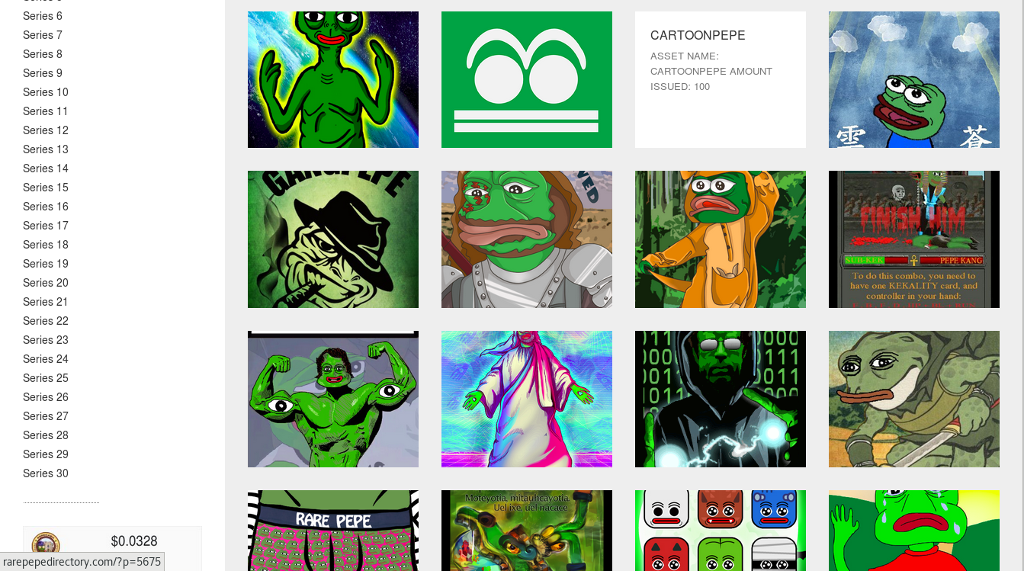
To make a Rare Pepe card you create a CounterParty token with a reference to the image you are using in its metadata, issue as many tokens as you are going to, then lock the token so no more can be issued (making the token “rare”). Rare Pepe quantities, prices and styles vary. There are magazines and virtual galleries devoted to them. There is even a subtoken representing the original physical version of one image (with an edition size of one).
A more singular set of images are the “CryptoPunks” (seen at the top of this page), which exist as an ERC20 token (almost) on the Ethereum blockchain. The “smart contract” that administers the token contains a cryptographic hash of an image of 10,000 bitmapped characters which can be bought and sold using its functions. Like Rare Pepes, the punks have a lighthearted style (they are retro pixellated avatars) and have varying rarity (some features are unique, others appear on dozens of characters) . Unlike Rare Pepes, every punk was created at the start of the project and no more can be added. At the time of writing, punks are available to purchase for 0.12 to 1,010,101,101,110,010,011,000.01 ETH (40.35 to 339,616,193,448,241,111,336,826.06 USD).
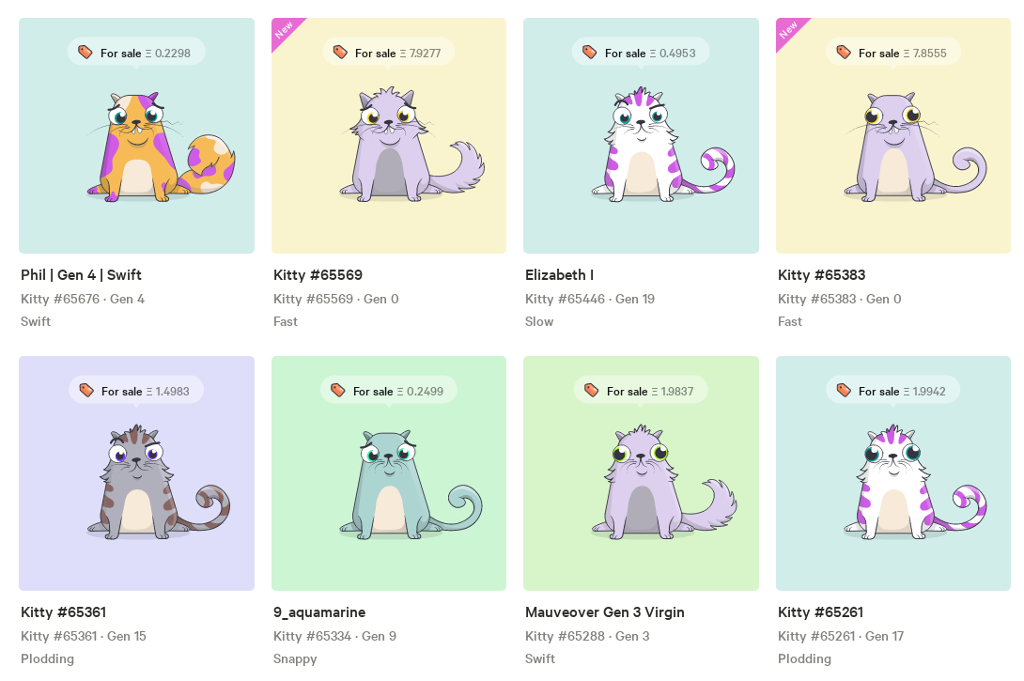
An even more playful approach may be able to take artificially scarce digital collectibles mainstream. CryptoKitties are customized cartoon cats whose appearance is determined by a digital genome (like the old “Cabbage Patch Kids” dolls) that can be interbred to produce more of them (like William Latham’s “Mutator”). At the time of writing they are taking up 13% of the Ethereum network’s capacity, making them the single biggest user of that blockchain, and the most expensive has sold for more than 100,000USD.
Every art is relative to a culture and an economy, whatever its other properties. The ground that tradeable blockchain images are a figure against is a particular moment in the history of cryptocurrency. Trading cards and digital collectibles fit a specific cultural niche, as does their iconography and the socially performative act of dealing in them. Their price may reflect the ability of cryptocurrency early adopters (who in the case of CounterParty and its XCP currency don’t have much else to spend it on) to be more extravagant with their hodlings.
“dada.nyc” follows the tokenized image edition strategy but applies it to popular/illustration art. Again each image is available for a given price in a given edition (for example 0.084 ETH in an edition of 150). The gallery takes a cut, and it takes a cut on profits on the secondary market. It also gives a cut to the artist, simulating Droit de Suite/Artist’s Resale Right. The Resale Right is controversial – it breaks the first sale doctrine and mostly benefits the estates of dead famous artists. But I implemented it as a user-settable property in the Art Market smart contract that I wrote in 2014 as I felt it was worth experimenting with in a voluntary setting.
Monegraph came out while I was working on that project. Like Ascribe it is a serious digital art registry implemented initially using pre-smart-contract technology (NameCoin for Monegraph, Bitcoin for Ascribe). These platforms’ seriousness and phrasing as registries contrasts with the playfulness and explicit tokenizaton of more recent systems. This and the already mentioned possible impacts of the social and economic impact of the increase in value of cryptocurrencies since 2014, along with the increased mainstream awareness of cryptocurrency, may explain the difference in their adoption (or at least their place in the hype cycle).
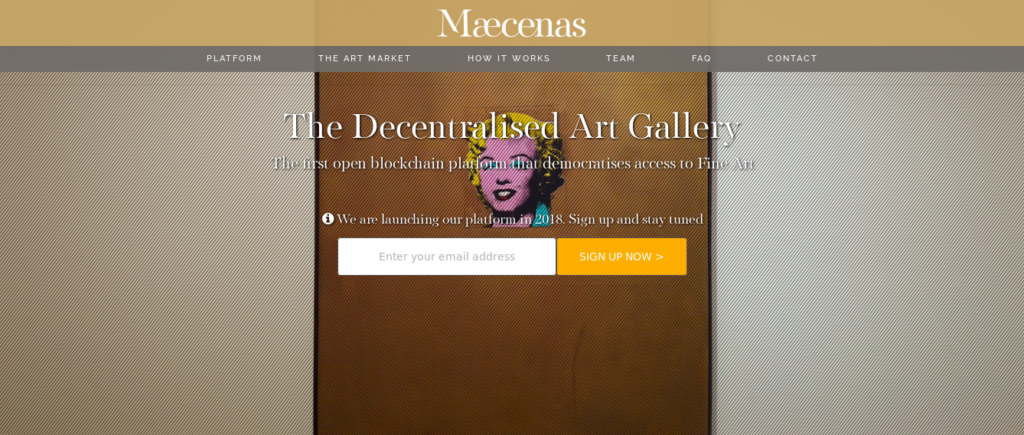
In contrast, Maecenas is a tokenized investment fund for physical fine art. It operates in part like the scene in William Gibson’s “Count Zero” (1986) in which Marly, one of the protagonists, reflects on how art in the mid-21st century is bought and sold as “points” in the work of a particular artist that represent shares in the value of the “originals” which are stored unseen in a vault. To quote their web site, “investors speculate via synthetic exposure: James is a Modern Art collector who needs to finance the purchase of a new Jeff Koons sculpture worth $120k. Instead of selling items from his collection, or getting an expensive loan, James get the required funding by listing in Maecenas 20% of one of his flagship pieces of art. Access to Maecenas is via an ERC20 token named (ART)” that Maecenas claim will improve access, transparency and fairness in the art market.
Propertization, fractionalization and financialization via proxy tokens (we cannot “own” allographic digital images, or own part of autographic paintings without dismembering them, but we can own tokens that we agree to pretend represent these things) promise to support art production using the economic accident of the value of cryptocurrency going to the moon. Quasiproperty without attempts at the costly fantasy of imposing access control via DRM is a form of, or a variation on the idea of, patronage. I feel this complex of ideas should be more useful to critics of the commodity form and capitalism than it has generally been treated as so far. If we still wish to take the opposite tack this leads us to the gift economy or the commons. Copyright is the default state for most art when it is created and is being increasingly restrictively enforced on the net. Opposing it passively or actively through alternative copyright licensing can perform a critique of this and keep space open for alternatives. These strategies needn’t exclude each other though.
If you are familiar with DAOs, you can see how a system similar to these could become a self-supporting, self-curating DAO. Plantoid is an example of a singular artwork (or family of artworks) produced and exhibited in such a way. Imagine it generalized to a gallery or a participatory art show, a DAO that lets you do art with others, a DAOWO.
These technologies can provide objects for critical exploration that evoke wider contemporary themes. They can function as tools and resources for the creation of art and its social collectivities focussing on these and other themes. Within the existing economy they can provide ways of supporting the arts (as many of the projects mentioned above claim to), which should neither be dismissed reflexively nor accepted without irony. Or they can be used to try to bootstrap a different context entirely, even if only briefly or in the imagination. The various modes of tokenization represent potential ways of making a living in, critiquing, or even transforming the artworld in an era of the continuing expansion of the sphere of private property and financialization under technocapital.
This series brings together artists, musicians, technologists, engineers, and theorists to join forces in the interrogation and production of new blockchain technologies.
Our focus will be to understand how blockchains might be used to enable a critical, sustainable and empowered culture, that transcends the emerging hazards and limitations of pure market speculation of cryptoeconomics.
Intended as a temporary laboratory for the creation of a living laboratory, the inaugural workshop in the series takes a pragmatic approach towards building technical and economic capacity in the arts.
As the DAOWO series unfolds, each lab will work across a spectrum of themes and domains of expertise, breaking down silos and assumptions about what blockchain technologies might mean. The aim is to birth a new set of experimental initiatives which can reinvent the future of the arts as we know it.
Thu 26 Oct: Reinventing the Art Lab (on the blockchain)
Venue: Goethe-Institut, London | BOOKING ESSENTIAL
2-5.30pm Workshop devised and hosted by Ruth Catlow and Ben Vickers
7-8.30pm Panel discussion with Hito Steyerl, Helen Kaplinsky, Julian Oliver
The Subsequent DAOWO Programme of Labs and Debates
Thu 23 Nov: Identity Trouble (on the blockchain)
Thu 25 Jan 2018: Doing Good (on the blockchain)
Fri 16 Feb 2018: Artists Organise (on the blockchain) (special event with Clubture at Drugo More, Rijeka)
Thu 22 Feb 2018: The Decentralised Music Society reforming music (on the blockchain)
Thu 29 Mar 2018: What Will It Be Like When We Buy An Island (on the blockchain)?
This programme is devised by Ruth Catlow and Ben Vickers in collaboration with the Goethe-Institut London, and the State Machines programme. Its title is inspired by a paper by artist hacker and writer Rhea Myers called DAOWO – Decentralised Autonomous Organisation With Others.
Events will be hosted at the Goethe-Institut, London and Drugo More, Rijeka.
About Ruth Catlow
Ruth Catlow is an artist, writer and curator working with emancipatory network cultures, practices and poetics. She is the co-founder, co-director of Furtherfield.
About Ben Vickers
Ben Vickers is a curator, writer, explorer, technologist and luddite. He is CTO at the Serpentine Galleries in London and an initiator of the open-source monastic order unMonastery.
This project has been funded with the support from the European Commission. This communication reflects the views only of the author, and the Commission cannot be held responsible for any use which may be made of the information contained therein.
14.00-17.30 – Workshop devised and hosted by Ruth Catlow and Ben Vickers
19.00-20.30 – Panel discussion with Hito Steyerl, Helen Kaplinsky and Julian Oliver
Workshop participants who wish to also stay for the panel event should book for both events individually
Does Art need its own blockchain? Can blockchain technologies help create and retain value for artists and arts organisations? If blockchains are transforming all other industries and supply chains, how will it effect the arts? Is this technology at a stage now where we can begin applying it to our everyday processes and practices?
These are just a few of the questions we have been asking ourselves and others over the course of the last year. In the scheduling and convening of this workshop series we invite others to join us as we delve deeper into the pragmatics of applying these questions to specific scenarios.
Designed as a temporary laboratory for the creation of a living laboratory, the inaugural workshop in the series will take a pragmatic approach in mapping out technical and economic capacity for the application of blockchain technologies within the arts.
This workshop will open with an overview of current developments for blockchain application within the arts ecosystem, outlining the key opportunities and challenges. Serving as the background, this will lead into a series of short presentations by practitioners who have invested their time over the past years unpicking the treacherous complexity of the blockchain. Each of these areas will then be built upon through facilitated working groups – with the explicit objective of enabling initiatives to move into a new phase of development.
As the workshop series unfolds, each lab will work across a spectrum of themes and domains of expertise, breaking down silos and assumptions about what blockchain technologies might mean. The aim is to birth a new set of experimental initiatives with each lab, which can contribute towards rethinking and reinventing the future of the arts as we currently know it.
“If art is an alternative currency, its circulation also outlines an operational infrastructure. Could these structures be repossessed to work differently?” – Hito Steyerl
Following the inaugural workshop of the DAOWO series, this panel will seek to establish a public platform for the discussion of opportunities, dangers and complexity inherent in the very idea of applying blockchain technologies to the production and circulation of art.
Exploring both hands on practical applications and the theoretical long term impact of a technology that enables a vast array of unexpected new conditions, under which the artworld and art market may be forced to operate. From fractional ownership, strict provenance models, untraceable financial transactions, autonomous artworks to new fully automated organisational forms – this panel will seek to unravel and interrogate both the banality and the terror of blockchains future impact on the arts.
Hito Steyerl’s films, installations and writings come out of a systemic way of thinking and working, in which artistic production and the theoretical analysis of global social issues are closely linked. Steyerl investigates the interaction and synthesis of technological and artistic imagery, for example, at the level of visual mass culture – and its function within the overall dispositif of technocracy, monetary policy, the abuse of power, and violence.
Helen Kaplinsky is a curator and writer based at Res., a collaboratively programmed gallery and workspace in Deptford, South East London, currently working in partnership with nearby University of Goldsmiths. Specialising in collection and archive based projects, the thematics and strategies of her curatorial projects consider property in the age of digital sharing. She has contributed to programmes at Whitechapel Gallery, South London Gallery, Glasgow International Festival, ICA (London), The Photographers Gallery (London), and has ongoing programmes with Tate and FACT (Liverpool).
Julian Oliver is a Critical Engineer and artist based in Berlin. Julian has also given numerous workshops and master classes in software art, data forensics, creative hacking, computer networking, counter-surveillance, object-oriented programming for artists, augmented reality, virtual architecture, video-game development, information visualisation and UNIX/Linux worldwide. He is an advocate of Free and Open Source Software and is a supporter of, and contributor to, initiatives that reinforce rights of privacy and anonymity in networked and other technologically-mediated domains. He is the co-author of the Critical Engineering Manifesto and co-founder of Crypto Party in Berlin, who’s shared studio Weise7 hosted the first three crypto-parties worldwide. He is also the co-founder of BLACKLIST, a screening and panel series focused on the primary existential threats of our time.
The DAOWO programme is devised by Ruth Catlow (Furtherfield) and Ben Vickers (Serpentine Galleries & unMonastery) in collaboration with the Goethe-Institut London, and the State Machines programme.
This project has been funded with the support from the European Commission. This communication reflects the views only of the author, and the Commission cannot be held responsible for any use which may be made of the information contained therein.
DOWNLOAD PRESS RELEASE
The blockchain is widely heralded as the new internet – another dimension in an ever-faster, ever-more powerful interlocking of ideas, actions and values. Principally the blockchain is a ledger distributed across a large array of machines that enables digital ownership and exchange without a central administering body. Within the arts it has profound implications as both a means of organising and distributing material, and as a new subject and medium for artistic exploration.
This landmark publication brings together a diverse array of artists and researchers engaged with the blockchain, unpacking, critiquing and marking the arrival of it on the cultural landscape for a broad readership across the arts and humanities.
Contributors: César Escudero Andaluz, Jaya Klara Brekke, Theodoros Chiotis, Ami Clarke, Simon Denny, The Design Informatics Research Centre (Edinburgh), Max Dovey, Mat Dryhurst, Primavera De Filippi, Peter Gomes, Elias Haase, Juhee Hahm, Max Hampshire, Kimberley ter Heerdt, Holly Herndon, Helen Kaplinsky, Paul Kolling, Elli Kuru , Nikki Loef, Bjørn Magnhildøen, Rhea Myers, Martín Nadal, Rachel O Dwyer, Edward Picot, Paul Seidler, Hito Steyerl, Surfatial, Lina Theodorou, Pablo Velasco, Ben Vickers, Mark Waugh, Cecilia Wee, and Martin Zeilinger.
Read a review of the book by Regine Debatty for We Make Money Not Art
Read a review of the book by Jess Houlgrave for Medium
While archaeology has often understood cultures through excavations of hoards and coins, what will today’s digital currencies tell future archaeologists about the way we live and trade?
This co-commission with NEoN Digital Arts Festival forms part of Furtherfield’s ongoing investigations into the politics of the blockchain, smart contracts, and cryptocurrency systems like Ethereum. It invites artists to imagine themselves as future media archaeologists, as recorders of our current information-based society, and as time-travelers highlighting the continued relevance of our long past. Will you dig for the digital, brush the dirt off the non-material, or excavate the internet?
In an era that threatens to be a digital dark age for future historians [1], blockchains may prove to be rare digital artefacts valuable enough to preserve into the future. There are already dozens of dead chains from abandoned cryptocurrencies [2], but with billions of dollars of value tied up in Bitcoin, Ethereum and other leading coins, the incentives to maintain their public ledgers are strong. Culture and knowledge have already been hidden in the blockchain – from images of Nelson Mandela to WikiLeaks cables [3] – but it is the blockchain as a record of our economic activity that concerns us here. This already has its history; on these public digital ledgers we can find everything from the ten thousand Bitcoins that were used to buy two pizzas [4] to the fifty million dollars of Ether that were stolen [5] in a hack on code running on the Ethereum blockchain. We just don’t have the best tools to visualise them yet.
We invite proposals for a new artistic online commission that takes the blockchain as the site of its manifestation. For example, artworks that are:
Whatever it is, it should work as a future media archeological artefact of blockchain finance and it has to be exhibitable online.
Hailed as both emancipatory opportunity for creative autonomy, and a driver of inequality and corporate opacity, the blockchain [10] is widely described as the Internet of Money. The blockchain is overtaking the WWW as the next big network technology for speculation and disruption. Investors recognise its potential in numerous ways: for high level authentication of identity [11] and matter [12]; for more efficient and secure financial transactions and distribution of digital assets; for communications so secure as to facilitate voting; and as a coordinating technology for the billions of devices connected to the Internet [13]
50 years ago this year, the world’s first ATM was designed, built and shipped from Dundee and installed in Enfield, less than 10 miles from Furtherfield. With this commission Furtherfield and NEoN recognise the role that the city of Dundee has played in the history of the development of smart technologies for financial transactions, through it being home to the R&D wing of The National Cash Register Corporation – NCR. [14]
NEoN Digital Arts Festival 2017 will expand on it being Scotland’s Year of History, Heritage and Archaeology, and seek to use its arts programme to unveil hidden histories through the practice of ‘media archaeology’. Media archaeologists uncover and reconsider the obsolete, persistent, and hidden material cultures of the technological age – from big data software algorithms to tiny silicon chips. With support from the National Lottery through Creative Scotland’s Open Project Fund, and Creative Europe Programme of the European Union, NEoN and Furtherfield invite artists to consider how the blockchain is the new ATM of the future.
The commission will be launched online and at NEoN Digital Arts Festival, and presented at the Digital Futures programme at V&A Museum and MoneyLab both in London in Spring 2018 as part of the European collaboration, State Machines which investigates the new relationships between states, citizens and the stateless made possible by emerging technologies.
Open Call announced 11th August
Deadline 4th September
6-9 September – follow up conversations where necessary (by email/phone)
13th September – decision made, artists informed and announced
19th September – public debate about cryptocurrencies in Dundee (organised by Scotcoin https://www.meetup.com/scotland-and-digital-currency/events/242087813/)
9th October – selected artist give progress report
9th November – Work installed for opening of NEoN Festival, Dundee. Artist presents work
Spring 2018 – Work re-presented with MoneyLab and V&A Digital Futures
(Note an additional £500 is available for accommodation and expenses for attendance at events in Dundee and London)
Submissions must include a proposal:
Documents should be submitted as PDFs or as links to a Google Doc, a GitHub Repo, or another easily read and easily accessed format.
If you have questions or enquiries about this commission please email alison.furtherfield[AT]Gmail.com
Notice of submissions via the Bitcoin blockchain should be sent via an OP_RETURN message starting with the word FField followed by a single space and the url of the proposal. E.g.:
FField https://docs.google.com/document/d/2oGsmli7Mlm-M_CZkL8WTKM3oUU3a
OP_RETURN messages can be created using the Crypto Grafitti service:
http://www.cryptograffiti.info/
Notice of submissions via Keybase messaging, or submissions of documents via KeybaseFS should be sent to:
(Note: Keybase does require registration but is free to join.)
Notice of submissions, or submissions of documents via email can be sent to ruth.catlow[AT]furtherfield.org
Please use the subject line “Furtherfield NEoN Proposal”.
Furtherfield
Through artworks, labs and debate around arts and technology, people from all walks of life explore today’s important questions. The urban green space of London’s Finsbury Park, where Furtherfield’s Gallery and Lab are located, is now a platform for fieldwork in human and machine imagination – addressing the value of public realm in our fast-changing, globally connected and uniquely superdiverse context. An international network of associates use artistic methods to interrogate emerging technologies to extend access and grasp their wider potential. In this way new cultural, social and economic value is developed in partnership with arts, research, business and public sectors.
NEoN
NEoN (North East of North) based in Dundee, Scotland aims to advance the understanding and accessibility of digital and technology driven art forms and to encourage high quality within the production of this medium. NEoN has organised 7 annual festivals to date including exhibitions, workshops, talks, conferences, live performances and public discussions. It is a platform to showcase national and international digital art forms. By bringing together emerging talent and well-established artists, NEoN aims to influence and reshape the genre. We are committed to helping our fabulous city of Dundee, well known for its digital culture and innovation, to become better connected through experiencing great art, networking and celebrating what our wee corner of Scotland has to offer in the field of digital arts.
State Machines: Art, Work and Identity in an Age of Planetary-Scale Computation
Focusing on how such technologies impact identity and citizenship, digital labour and finance, the project joins five experienced partners Aksioma (SI), Drugo More (HR), Furtherfield (UK),Institute of Network Cultures (NL) and NeMe (CY) together with a range of artists, curators, theorists and audiences. State Machines insists on the need for new forms of expression and new artistic practices to address the most urgent questions of our time, and seeks to educate and empower the digital subjects of today to become active, engaged, and effective digital citizens of tomorrow.
V&A Digital Futures: Digital Futures
V&A Digital Futures: Digital Futures is a monthly meetup and open platform for displaying and discussing of work by professionals working with art, technology, design, science and beyond. It is also a networking event, bringing together people from different backgrounds and disciplines with a view to generating future collaborations.
Creative Scotland
Creative Scotland is the public body that supports the arts, screen and creative industries across all parts of Scotland on behalf of everyone who lives, works or visits here. It enables people and organisations to work in and experience the arts, screen and creative industries in Scotland by helping others to develop great ideas and bring them to life. It distributes funding from the Scottish Government and The National Lottery.
This project has been funded with the support from the European Commission. This communication reflects the views only of the author, and the Commission cannot be held responsible for any use which may be made of the information contained therein.
DOWNLOAD PRESS RELEASE
Book launch, drinks reception, and discussion.
Max Dovey “Love on the Block”: using blockchain for wedding vows
plus JJ Charlesworth in conversation with editors
Artists Re:Thinking the Blockchain is the first book of its kind, intersecting artistic, speculative, conceptual and technical engagements with the the technology heralded as “the new internet”. The book features a range of newly commissioned essays, fictions, illustration and art documentation exploring what the blockchain should and could mean for our collective futures.
This event features talks and conversation by contributors and editors of the publication, and an opportunity to be among the first to purchase the unique print edition.
Artists Re:Thinking The Blockchain
Imagined as a future-artefact of a time before the blockchain changed the world, and a protocol by which a community of thinkers can transform what that future might be, Artists Re:Thinking The Blockchain acts as a gathering and focusing of contemporary ideas surrounding this still largely mythical technology. The full colour printed first edition includes DOCUMENTATION of artistic projects engaged in the blockchain, including key works Plantoid, Terra0 and Bittercoin, THEORISATION of key areas in the global blockchain conversation by writers such as Hito Steyerl, Rachel O’Dwyer, Rhea Myers, Ben Vickers and Holly Herndon, and NEW POETRY, ILLUSTRATION and SPECULATIVE FICTION by Theodorios Chiotis, Cecilia Wee, Juhee Hahm and many more. It is edited by Ruth Catlow, Marc Garrett, Nathan Jones and Sam Skinner.
Along with a print edition, Artists Re:Thinking the Blockchain includes a web-based project in partnership with Design Informatics at University of Edinburgh: Finbook is an interface where readers and bots can trade on the value of chapters included in the book. As such it imagines a new regime for cultural value under blockchain conditions.
This book and surrounding events is produced in collaboration between Torque and Furtherfield, connecting Furtherfield’s Art Data Money project with Torque’s experimental publishing programme. It is supported by an Arts Council England Grants for the Arts, Foundation for Art and Creative Technology and through the State Machines project by the Creative Europe Programme of the European Union.
Available from Liverpool University Press, order copies here
CONTACT
Nathan Jones and Sam Skinner
mail@torquetorque.net
07877660150
Social media
@furtherfield
Artists Re:Thinking The Blockchain
ed. Ruth Catlow, Marc Garrett, Sam Skinner and Nathan Jones
published by Torque and Furtherfield
in partnership with Foundation for Art and Creative Technology (FACT)
ISBN: 978-0-9932487-5-7
distributed by Liverpool University Press
contact for stockist enquiries: lup@liv.ac.uk
Foreword by Sam Skinner and Nathan Jones
Introduction by Ruth Catlow
A: documents
FinBook: Literary content as digital commodity – Rory Gianni⍏, Hadi Merpouya*, Dave Murray-Rust⍏, Bettina Nissen⍏, Shaune Oosthuizen⍏, Chris Speed⍏, Kate Symons**
Text as Market – Ami Clarke
Plantoid – Primavera De Filippi
Terra0 – Paul Seidler, Paul Kolling, and Max Hampshire
Critical mining: blockchain and bitcoin in contemporary art by Martín Nadal & César Escudero Andaluz
The Blockchain: Change everything forever by Peter Gomes
Satoshi Oath by Jaya Klara Brekke and Elias Haase
01.01.20 by Kimberley ter Heerdt & Nikki Loef
Role Play Your Way to Budgetary Blockchain Bliss by Pablo Velasco
A Shared Timeline – PWR Studio
Blockchain Future States – Simon Denny (and artist interview)
B: fictions
Flying Under A Neutral Flag – Cecilia Wee
History of Political Operating Systems > Interview with Dr. L. Godord b – Elli Kuruş
All That Happened – Surfatial
Bad Shibe – Rhea Myers and Lina Theodorou
Defixio Nervorum – Theodoros Chiotis
How to Surf – Juhee Hahm
C: theories
If You Don’t Have Bread, Eat Art!: Contemporary Art and Derivative Fascisms – Hito Steyerl
immutabilty mantra – Ben Vickers
Blockchain Poetics – Rhea Myers
Love on the Block by Max Dovey
Collections management on the blockchain: A return to the principles of the museum – Helen Kaplinsky
Artists Rights in the Era of the Distributed Ledger – Mark Waugh
Everything You’ve Always Wanted to Know About the Blockchain* (*But Were Afraid to Ask Mel Ramsden) – Martin Zeilinger
Does digital culture want to be free? How blockchains are transforming the economy of cultural goods – Rachel O’Dwyer
Aphantasia – blockchain as medium for art – Bjørn Magnhildøen, Noemata
Interview with Holly Herndon and Mat Dryhurst – Marc Garrett
When Charlotte Webb asked me to write a piece about the future of work for Furtherfield, I immediately thought about Utopoly. Even though this game doesn’t directly discuss how we will be employed or occupied in the future, it creates a rare space where people can re-imagine a different society in which values, forms of exchange and social relations are reconsidered and reconfigured.
To better understand the ethos behind Utopoly, I interviewed Neil Farnan, who is currently undertaking a PhD at University of the Arts London with the research title ‘Art, Utopia and Economics’. He became an Utopoly advocate, introducing many ideas and concepts featured in its current iteration. Neil’s interest in designing a utopian version of Monopoly was initially shaped by his previous studies in User Interface Design, where he developed an interest in Scandinavian design practice and Future Workshops.
Francesca Baglietto: What is Utopoly? More specifically, how does it relate to and differ from Elizabeth Magie’s original version of Monopoly?
Neil Farnan: Utopoly is both a tool for utopian practice and a fun game. It draws on Robert Jungk’s Future Workshop methodology to re-engage people’s imagination and ideas for a better society and incorporates the results into a ‘hack’ of Monopoly.
Elizabeth Magie’s original game (1904) was intended to show how landlords accumulate wealth and impoverish society. Players could choose either a winner takes all scenario or one where wealth was distributed evenly via a land tax. Magie also hoped that children’s sense of fairness meant they would choose the latter and apply these ideas in adulthood. But the Monopoly we have today normalises and celebrates competitive land grabbing and rentier behaviour and Magie was airbrushed out of history and replaced with a more acceptable mythology of the American Dream.
Whilst Magie’s game informed players about the current situation, Utopoly gives people the opportunity to imagine and incorporate values and attributes they would want in a more utopian world. Players are able to determine the properties, the chance and community cards and even rules of the game. The rules being determined by the players means the game is a work-in-progress, however some features that work well can get adopted and carried through to the next iteration.
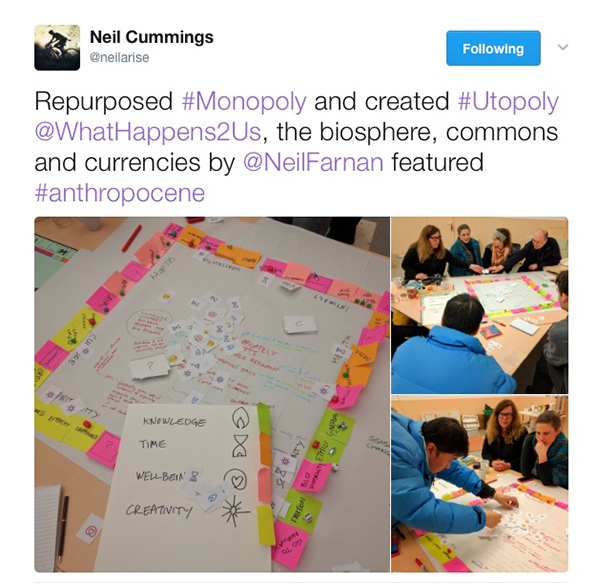
FB: As you just said, Utopoly doesn’t have a definitive form and rules but changes with each interaction. So, while the future of Utopoly is still in progress, what I would like to know is who started the project and how has this evolved so far?
NF: Critical Practice, a research cluster at Chelsea College of Arts, played a central role. We were concurrently developing both Utopoly and an event #TransActing – A Market of Values, and the current version of Utopoly is a synergy of aspects of these two projects. The first ‘hack’ of Monopoly occurred at Utopographies, co-organised by Critical Practice (28th – 29th March 2014), where the elements of the game were redesigned to incorporate utopian values. Inspired, we decided to continue developing the ideas and a second ‘hack’ took place (December 2014). Some of the ideas and values that emerged from this iteration fed into and were represented in the design of the currencies used for #TransActing. A further opportunity presented itself for another ‘hack’ within the research event ‘What Happens to Us’ at Wimbledon College of Art. This iteration was hosted by Neil Cummings and I was invited to include the currencies developed for #TransActing. It was here that Utopoly as a ‘method’ began to emerge, a method for collectively producing possible futures. I have since convened a number of iterations using a large laminated board to facilitate design adaptations and ease of play.
Additionally, researchers from the international ValueModels project (modelling evaluative communities utilising blockchain technology) recently visited Chelsea – we played Utopoly and they loved the method. They have since been inspired to use Utopoly in their research, and I’m excited to receive their feedback on how their version develops.
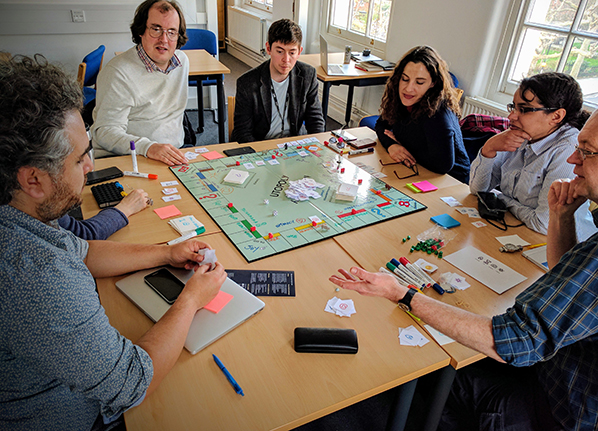
FB: Utopoly is experimenting with possible new monetary ecosystems in which multiple currencies and values might be exchanged. How might these currencies work and what are they inspired by?
NF: The currencies developed for #TransActing generated the concept of an ecosystem of value exchange and these are used in Utopoly. I have since come across the work of economist Bernard Lietaer, who highlights the problems of mono-currency economies and advocates for a monetary ecosystem using multiple currencies. With their origins in subjugation and taxation, mono-currencies are tools for value extraction. They also contribute to cycles of boom and bust, resulting in the withdrawal of money from the economy and the prevention of economic activity. Historical evidence suggests that economies operating multiple currencies are more resilient – they work in a counter cyclical manner compensating for this withdrawal and allow the economy to keep working.
The irony of Monopoly is that the winner is ultimately left in control of a non-functioning economy. A more preferable state would be to have a healthy flow of values in balance where people are able to exchange their contributions in a mutually beneficial way. A feature of Utopoly is that players no longer seek to own all the property but work together for the common good. The currencies are used to bring privately held properties back into the commons. The economist Elinor Ostrom won the Nobel prize for debunking the myth of the “tragedy of the commons” (Ostrom, 2015) demonstrating the benefits and effective use of common resources. Utopoly also allows economies of gifting and sharing.
I am currently working on ways of modelling innovations such as the blockchain and associated digital currencies.
FB: How would you interpret “work” in this utopian economy? For example, do you think the relation between paid work and unpaid work and/or people’s dependence on employment might be shaped in an ecosystem in which assets/values are brought into the commons to generate value/wealth for all?
Whilst not directly about work, Utopoly reflects the future nature of wealth and values in a Utopian economy. It touches on the current abstract separation of paid work from non-paid work and people’s employment dependency.
In Magie’s original game the players collect wages as they pass ‘Go’. They then buy properties and accumulate wealth extracted from other players. On one corner of Magie’s game is the Georgist statement “Labor Upon Mother Earth Produces Wages”, reminding us that land ownership should not provide unearned income.
As an economy develops people become less self-sufficient and more dependent on employment to meet their needs and a mono-currency makes the separation of paid and unpaid work even starker. The social contract that existed from 1950-70s where employers had a responsibility to their employees is disappearing. Outsourcing, short term and zero-hours contracts make the future of paid work increasingly precarious, and we also face further threats from automation and artificial intelligence.
Economist Mariana Mazzucato (2011) documents the substantial contribution of public investment to the success of today’s businesses. These businesses stand not so much ‘on the shoulders of giants’ but on the shoulders of a multitude of diverse contributions from society at large. A new social contract is needed to take this into account.
Fintech companies make much of the term ‘disintermediation’, but we also need a new form of ‘intermediation’ where contributions are reconnected and recognised. An ecosystem of currencies which register currently unpaid valuable activities together with a basic income could meet this need. This approach is suggested in Utopoly where people collaborate to contribute values and are valued for their contributions. The properties are brought into the commons to generate value and wealth for all.
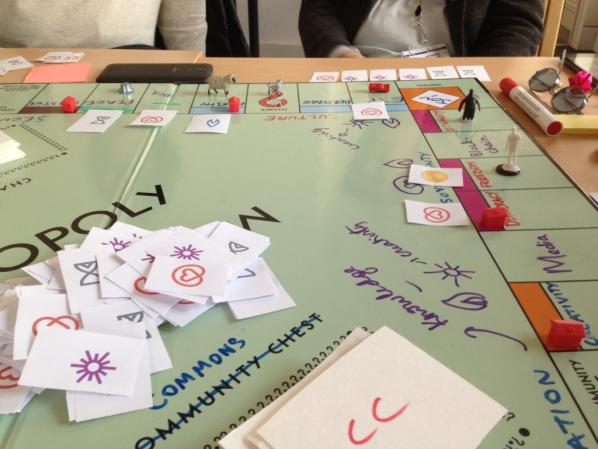
FB: Playing seems to provide a very rare space in which, by operating in an interstice between reality and fantasy (what the psychoanalyst Winnicott called a transitional space), it is still possible for the players to imagine alternatives to our current economic system. Would you agree that the main political purpose of Utopoly is to provide such a space in order to reopen the capacity to be imaginative about economic and societal organisations?
NF: This is the utopian aspect of Utopoly, using people’s imagination as a means of prefiguring the future. We endure in a society where the mainstream orthodoxy would like us to accept that ‘there is no alternative’. One of the last great taboos is money and the associated economic system. If you consider our mono-currency as a societal tool imposed from the top down, it shapes and informs how we behave and the values we are expected to live by. In a way, it is like DNA; if we can change the DNA of our economy we could create new exchanges, values and social relations. We have become so used to this abstract construct that it is the water we swim in and the box we need to think out of. In order for people to start thinking that another world is possible we need to open up a space for imagination to play out. Art, games and play are some of the few remaining arenas available to engage in speculation about the future. Utopoly fulfils many research functions including acting as a tool for inquiry and reflexion, and a means of modelling future possibilities. It is rare for people to have the opportunity to criticise the existing state of society and work out how to reshape it. By allowing people the space to consider different approaches we can start to encourage better societal norms of exchange and interaction and construct new social contracts.
“Decentralised computer infrastructure does not necessarily mean decentralised power” *
Announcing a new film and groundbreaking collaboration
The Blockchain: Change everything forever WATCH HERE
This new film released online on 3 October 2016 by Furtherfield in collaboration with Digital Catapult broadens the current debate about the impact of emerging blockchain technologies.
The underpinning technology of Bitcoin digital currency, the Blockchain is reshaping concepts of value, trust, law and governance. This film sets out to diversify the people involved in its future by bringing together leading thinkers, computer scientists, entrepreneurs, artists and activists who discuss:
What can a blockchain do?
Who builds this new reality?
How will we rule ourselves?
How will the future be different because of the Blockchain?
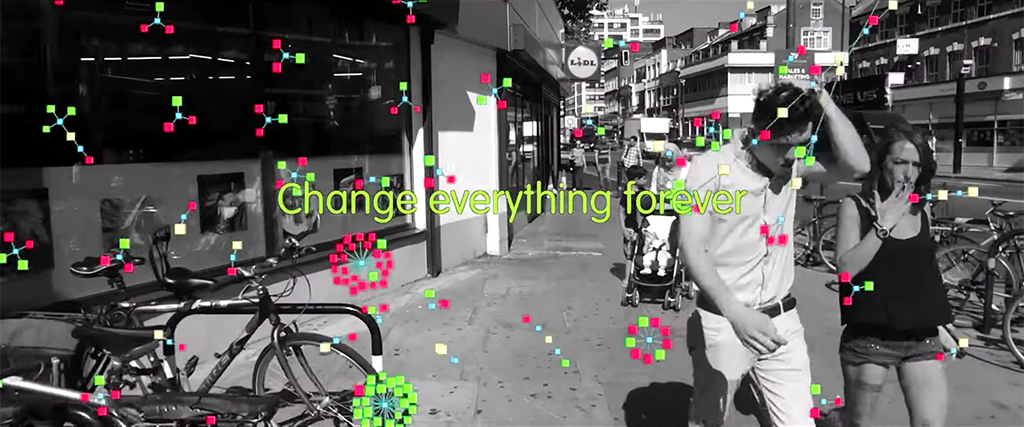
This is a unique collaboration between Furtherfield, dedicated to new forms of cooperation in arts, technology and society and Digital Catapult, an organisation dedicated to growing the UK digital economy.
DOWNLOAD
PRESS RELEASE (.pdf)
TRANSCRIPT (.pdf)
Directed by Pete Gomes
Concept, research and development by Ruth Catlow, Furtherfield, Co-founder and Co-director.
Contributors: Dr Anat Elhalal, Digital Catapult; Ben Vickers, Co-founder unMonastery and Curator of Digital, Serpentine Galleries; Dr Catherine Mulligan, Research Fellow, Associate Director – Centre for Cryptocurrency Research, Imperial College; Elias Haase, Developer, Thinker, Beekeeper, Founder of B9lab; Irra Ariella Khi, Co-founder and CEO Vchain Technology; Jaime Sevilla, developer, researcher, GHAYA , #hackforgood; Jaya Klara Brekke, digital strategy, design, research and curating, Durham University; Kei Kreutler, Independent Researcher, Co-founder unMonastery; Pavlo Tanasyuk, CEO BlockVerify; Rhea Myers, artist, writer, hacker; Sam Davies, Lead Technologist – Creative Programmes, Digital Catapult; Vinay Gupta, resilience guru, Hexayurt
Pixelache Festival 2016, Helsinki, Finland. 22-25 September 2016
BLOCKCHAIN MEETUP, London Digital Catapult Centre, London, UK. 27 October 2016
INAUGURAL BRISBANE BLOCKCHAIN SYMPOSIUM 2016, Brisbane, Australia. 3 November 2016
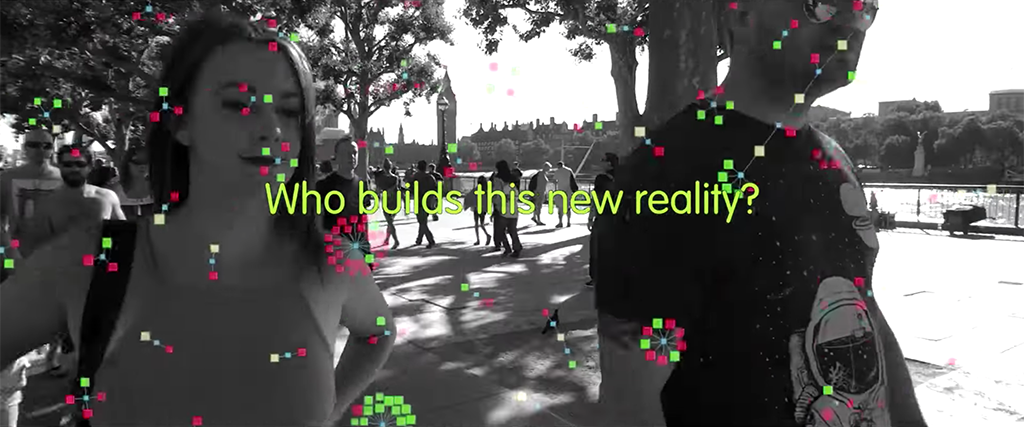
The Blockchain – Change everything forever has been made as part of Furtherfield’s Art Data Money programme which seeks to build a commons for the arts in the network age. A book, Artists Re:Thinking The Blockchain in partnership with itinerant publisher and arts organisation Torque will be published in Spring 2017 with the prequel due out November 2016.
Furtherfield is an international hub for arts, technology and social change. Since 1997, Furtherfield has created online platforms and physical places for exhibitions, labs and debates where different types of people explore today’s important questions. Furtherfield is an Arts Council England ‘National Portfolio’ organisation with a Gallery and Lab in London’s Finsbury Park http://furtherfield.org/
Digital Catapult works with SMEs to help them grow and scale faster. It helps larger corporates in their digital transformation. It does this through programmes of collaboration and open innovation, by bringing academic leading edge expertise into the mix combined with the organisation’s own business and technological expertise. https://digital.catapult.org.uk
For any additional materials and interviews
Please contact Ruth Catlow
ruth.catlow@furtherfield.org
@furtherfield
A Furtherfield film made in collaboration with Digital Catapult, with support from Arts Council England and Southbank Centre.
Blockchain: Change everything forever
What is the Blockchain?
The Blockchain is the underpinning technology for Bitcoin digital currency, and is said to be at the same stage of development as the World Wide Web in the late 1980s. Its promoters claim that the global deployment of smart contracts via this new decentralised protocol will change everything forever.
The Blockchain in Context
In 2008 Bitcoin, the first global digital currency was described in a white paper by the pseudonymous Satoshi Nakamoto. While the WWW facilitated a worldwide (economic and social) revolution in the global distribution of information, the Blockchain, would facilitate secure, decentralised record-keeping, exchange of digital assets and the mining and exchange of computationally secured value.
Since 2013 blockchains have become a focus for investment by world banks, FinTechs and corporations who predict a fourth industrial revolution of super-automation and hyperconnectivity. This is also accompanied by predictions from the World Economic Forum of increased global inequity.
In this version of the future, code replaces legislation. “Code becomes law”. Decentralised Autonomous Organisations (DAOs) route around systems of regulation and taxation via immutable smart contracts, globally deployed across the Blockchain.
The film The Blockchain: Change everything forever proposes that people from diverse disciplines and backgrounds should be involved to work out how Blockchain technologies can be shaped for more decentralised power, diverse needs and interests into the future.
*Jaya Klara Brekke, Digital strategy, design, research and curating, Durham University
The Road to Budgetary Blockchain Bliss, is a 2 hour Live Action Role Play adventure for the Blockchain-curious of all tribes including: hackers, lawyers, activists, artists, financiers, designers, venture capitalists, developers, marketeers.
Players adopt a fictional future version of themselves and work with others to solve a real-world problem. They learn about and build DAOs and Dapps (machine-based organisations and apps on the blockchain) and act out the social discomforts, asymmetries, dramas and politics of collaboration and coalition-formation across difference….starting with the budget!
NO PRIOR BLOCKCHAIN KNOWLEDGE NECESSARY
Fill out the application survey to ensure that you are assigned a compatible player character and so increase your chances of achieving your objective – fictionalise at will.
The Road to Budgetary Blockchain Bliss
Devised by Ruth Catlow, Furtherfield and Ben Vickers, unMonastery & Serpentine Galleries
WHEN?: Prompt start – 13:45 – 15:40 on Friday 2 Dec 2016
WHERE? The Presentation Room
As part of MoneyLab #3 Failing Better Symposium | Workshops | Exhibition,
Pakhuis de Zwijger, Amsterdam A two-day symposium,
1 – 2 December 2016, featuring talks, workshops and performances that confront the notion that finance is too big to fail.
Tickets: € 10 per session; € 30 per day, € 60 two day pass Students: 50% discount on all tickets
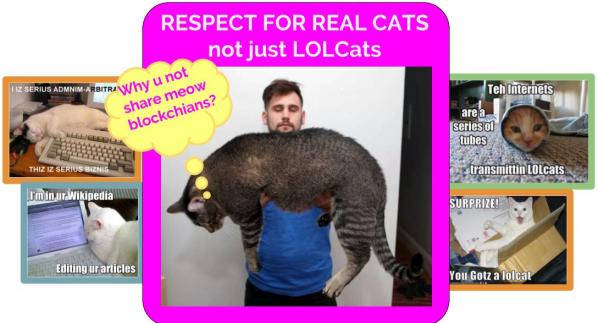
Date:NOW
Venue:HERE Links:http://www.crowdfunder.co.uk/artists-rethinking-the-blockchain?tk=208334da9b174c..
WE WANT your submissions to this landmark publication marking and augmenting the arrival of a new technology on the cultural landscape.
THE BLOCKCHAIN is widely heralded as the new internet – another dimension in the ever-faster ever-more-powerful interlocking of ideas, actions and values. [1]
It’s nothing more than a ledger distributed across a large array of machines. An apparatus that enables digital ownership and exchange without a central administering body. But from these simple premises, it has been credited with the potential to transform everything, from trade, to cultural production, to the way we’re governed.
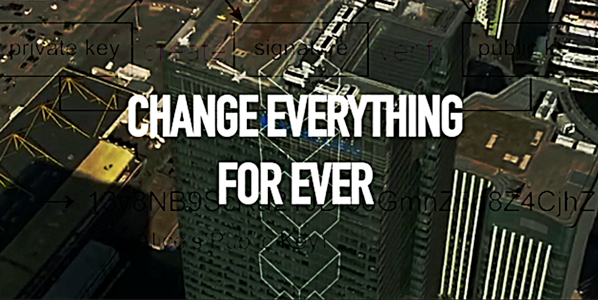
Among other things, we are suspicious of cultural production being brought under the same regime as finance.
Even as we write, this “new dawn” for transactions is being re-imagined as the next sleep-cycle taking us deeper into the neoliberal dream of complete financialisation. In this dream, Finance and Technology quicken their demented mining of value tokens from phenomena, while the grammars of culture, family, nature, politics and spacetime itself evaporate into a flurry of question and exclamation marks in their wake.
“It’s going to change everything!” (The Guardian)
The permanence and irrevocable automation of blockchain systems wedded to the irrationality and sweep of techno-financial hybrids has led to forecasts ranging from ‘fully automated luxury communism’, to our ultimate cryptological enslavement to machines, or the collapse of time itself, as the feature of algorithms to make-happen overtakes the temporal concerns of flesh and earth.
Artists Re:thinking The Blockchain
This book is not a site for a ludic cynicism or uncritical valorisation, though it celebrates the energies of these excessive forms of thinking. We welcome the potentials for ever more nuanced democratic apparatus, and the decentralization of power from state-corporation cabals, while rejecting the notion that any single technology would automatically enact these ideological transformations. We seek also to register and amplify the leakages, weirdness and side-effects that this new technology inaugurates.
Imagined as a future-artefact of a time before the blockchain changed the world, and a protocol by which a community of thinkers can transform what that future might be, Artists Re:Thinking The Blockchain acts as a gathering and focusing of contemporary ideas surrounding this still largely mythical technology.
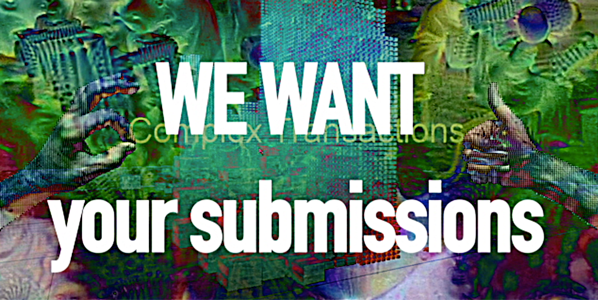
The book will include examples and discussions of current artistic projects making use of and illustrating the potentials of the blockchain, theorisation from some of the leading figures in the global blockchain conversation, and practical discussions which artists can use to guide their first steps towards this new technology.
We welcome submissions of
· book-based artworks which reflect on blockchain themes
· science fictions and theorisations, particularly in their hybrid form
· proposals for documentation of online and irl artworks
· poems, particularly based on the ‘new book’ and formal constraint txtblock [2]
The publication is a collaboration between Torque and Furtherfield, connecting Furtherfield’s Art Data Money project with Torque’s experimental publishing programme.
Alongside an illustrated print edition, the project includes a range of public-participation and debating sessions in towns and cities up and down the UK, and the first-ever book launch taking place on the blockchain itself.
DEADLINE FOR PROPOSALS 15th August
– up to 500-word abstract, description or sample of your proposed submission
– a short bio
– website link (optional)
mail to: mail@torquetorque.net
DEADLINE FOR FINAL SUBMISSIONS will be 1st October
torquetorque.net || furtherfield.org
https://www.facebook.com/torquebooks
#artblockbook
Contact: mail@torquetorque.net
In 2016 Ruth Catlow and Ben Vickers led the symposium, Blockchain’s Potential in the Arts, hosted by the Austrian Cultural Forum. This symposium sought to bring together individuals from across the arts nationally to highlight and discuss the potential future impact of blockchain and encourage early engagement.
The award-winning DAOWO series was subsequently devised by Catlow and Vickers in collaboration with the Goethe-Institut London, and the State Machines programme. It is intended as a form of active engagement in these rapidly unfolding technical and socio-economic developments. Its title is inspired by a paper written by artist, hacker and writer Rhea Myers called DAOWO – Decentralised Autonomous Organisation With Others.
What does blockchain mean for the arts?
‘What seems to emerge is a potential for blockchain to devolve mechanisms and processes for funding artists, as well as allowing various players in the arts ecosystem – artists, collectors, viewers, curators, and others – to define how they want to interact, with the possibility that sharing and artwork almost merge, or at least become as two sides of the same coin.”
U. Kanad Chakrabarti
Focused on establishing greater cooperation between the arts and blockchain industry, leading researchers and key artworld actors discuss the current state of play. DAOWO Discussions focus on potential cultural and social impacts, technical affordances and opportunities for developing new blockchain technologies for fairer, more dynamic and connected cultural ecologies and economies.
This series brings together artists, musicians, technologists, engineers, and theorists to join forces in the interrogation and production of new blockchain technologies. Our focus will be to understand how blockchains might be used to enable a critical, sustainable and empowered culture, that transcends the emerging hazards and limitations of pure market speculation of cryptoeconomics.
As the DAOWO series unfolds each lab works across a spectrum of themes and domains of expertise, breaking down silos and assumptions about what these technologies might mean.
The aim is to birth a new set of experimental initiatives which can reinvent the future of the arts as we know it.
1-6pm Thur 28 Feb – Inspace, Edinburgh, in partnership with Department of Design Informatics at the University of Edinburgh, New Media Scotland.
Edinburgh Programme Summary
For more DAOWO activities see our Events page.
French artists Émilie Brout and Maxime Marion contribute three pieces to The Human Face of Cryptoeconomies exhibition. Gold and Glitter is a painstakingly assembled installation of collaged GIFs. Previous installations have featured the GIFs displayed on a gold iPad atop a pile of collected gold trinkets; at Furtherfield Gallery now a single golden helium balloon hovers in front of a floor to ceiling projection. Nakamoto (The Proof) is video documentation of the artists’ efforts to try and place a face on the elusive Bitcoin creator, Satoshi Nakamoto (but is it his face in the end? We don’t know). Untitled SAS is a registered French company without employees and whose sole purpose is to exist as a work of art.
Brout and Marion’s work can be situated among artists and art practices who have grappled with how to think about value and objects—or more precisely, how objects are inscribed (and sometimes not) into an idea of what is valuable. In a recent article for Mute Magazine, authors Daniel Spaulding and Nicole Demby point out that “Value is a specific social relation that causes the products of labor to appear and to exchange as equivalents; it is not an all-penetrating miasma.”1 Value is a process by which bodies are sorted and edited but it is not a default spectrum on to which all bodies must fall in varying degrees. This clarification makes explicit the fact that while the relationships productive of value allow “products of labor to appear and to [be exchanged]”2 this is not an effect that is extended to all products of labor. Attempts to isolate the underlying logic of this sorting mechanism are often at the heart of art practices dealing with questions of value and commodification. Like Andy Warhol’s Brillo Boxes or Marcel Duchamp’s Fountain, these artworks become interesting problematics for the question of art and value for the ways in which they are able to straddle two economic realms—that of the art object and the commercial object—while resisting total inclusion in either.
The Human Face of Cryptoeconomies picks up these themes in an art context and repositions them alongside digital cultures and emerging digital economies. In Brout and Marion’s work alone, concepts of kitsch, identity, and human capital have been inhabited and imported from their originary realms into the digital. Answering questions remotely, Brout and Marion were kind enough to give us some insights into their work and process. My goal here has been to draw out some points about the operation of value that are at work in Brout and Marion’s practice, as well as to point towards an idea of how value is transformed, or even mutated, in the digital age.
* * *
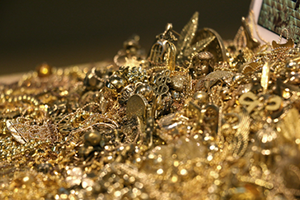
Brout and Marion open up with an interesting provocation. They explain, “When we showed the project [Glitter and Gold] in Paris this year, people stole a lot of objects, even if they were very cheap. Gold has an incredible power of attraction.”
It is telling, to some extent, that Brout and Marion’s meditations on gold have an almost direct link to the visual metaphor used by Clement Greenberg in his 1939 essay Avante-Garde and Kitsch to describe the relation between culture—epitomized in the avant-garde—and the ruling class. Greenberg writes, “No culture can develop without a social basis, without a source of stable income. And in the case of the avant-garde, this was provided by an elite among the ruling class of that society from which it assumed itself to be cut off, but to which it has always remained attached by an umbilical cord of gold.”3 This relation is subverted in Gold and Glitter, which takes for its currency—its umbilical cord of gold—a kind of unquantifiable labor that is seemingly (and perhaps somewhat sinisterly) always embedded in discussions of the digital.
For Greenberg, kitsch always existed in relation to the avant-garde; one fed and supported the other, even if the way in which that relation of sustenance worked was by negation. And while Greenberg’s theory relies on his own strict allegiances to hierarchical society, privileged classes, the values of private property, and all the other divisive tenets of capitalism that we now know all too well can be destructive. Kitsch remains useful to us for the ways in which it allows the means of production to enter into a consideration of aesthetics. Here the recent writing of Boris Groys can be useful. In an essay written for e-flux titled Art and Money, Groys makes a compelling case for why we should persist in a sympathetic reading of Greenberg. He argues that Greenberg’s incisions amongst the haves and have nots of culture can be cut across different lines; that because Greenberg identifies avant-garde art as art that is invested in demonstrating the way in which is it is made and it doesn’t allow for its evaluation by taste. Avant-garde art shows its guts to us all, and on equal terms—“its productive side, its poetics, the devices and practices that bring it into being” and inasmuch “should be analyzed according the same criteria as objects like cars, trains, or planes.”4
For Groys this distinction situates the avant-garde within a constructivist and productivist context, opening up artworks themselves to be appreciated for their production, or rather, “in terms that refer more to the activities of scientists and workers than to the lifestyle of the leisure class.”5 In this way Glitter and Gold, like Brout and Marion’s other artworks, is to be appreciated not for any transcendent reason but rather for the means by which it came into existence. ‘The processes of searching and collaging golden GIFs sit side by side with the physical work of accumulating the golden trinkets for display: “We collected these objects for a long time” the artists explain, “some were personal objects (child dolphin pendant, in true gold), others were given or found in flea markets, bought in bazaars … We wanted to have a lot of different types and symbols, from a Hand of Fatima to golden chain, skulls, butterflies, etc.”
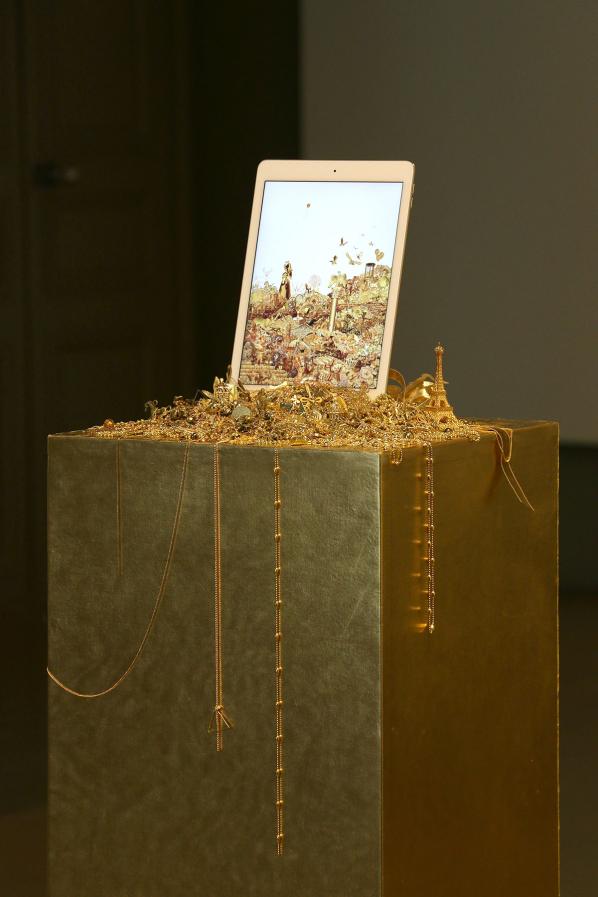
Furthermore, Glitter and Gold can be understood as the product of compounding labors: the labor of Brout and Marion in collecting their artifacts, the labor necessary to create the artifacts, the labor of GIF artists, the labor of searching for said GIFs, the labor of weaving a digital collage. These on-going processes forge, trace, and re-trace paths during which, at some point, gold takes on the function as aesthetic shorthand for value. As Brout and Marion explain, “Here the question is more about the intrinsic values we all find in Gold, even when it just looks like gold. Gold turns any prosaic product into something desirable. [Gold and Glitter] is less about economics than about perceived value.”
Groys provides his reading of Greenberg as a means of pointing towards a materiality that is always in excess of existing coordinates of value. If value always reveals the products of labor as they enter into a zone of exchange, it is something else proper to contemporary art that reveals another materiality beyond this exchange. For Groys, this something else is at work in the dynamics of art exhibition, which can render visible otherwise invisible forces and their material substrates. This is certainly a potential that is explored by Brout and Marion. In Nakamoto (The Proof), the viewer can watch the artists’ attempt at creating a passport for the infamous and elusive Bitcoin creator Satoshi Nakamoto. At present, it is unclear whether Nakamoto is a single person or group of people, though the Nakamoto legacy as creator of Bitcoin, a virtual currency widely used on darknets, is larger than life. Adding to this myth, after publishing the paper to kickstart bitcoin via the Cryptography Mailing List in 2008, and launching the Bitcoin software client in 2009, Nakamoto has only sporadically been seen participating in the project with others via mailing lists before making a final, formal disappearance in 2011, explaining that he/she/they had “moved on to other things.”6 Nakamoto’s disappearance, coupled with the fact that Nakamoto’s estimated net worth must be somewhere in the hundred millions Euros, has given rise to the modern-day myth of Nakamoto, and with it an insatiable curiosity to uncover the identity and whereabouts of the elusive Bitcoin creator.
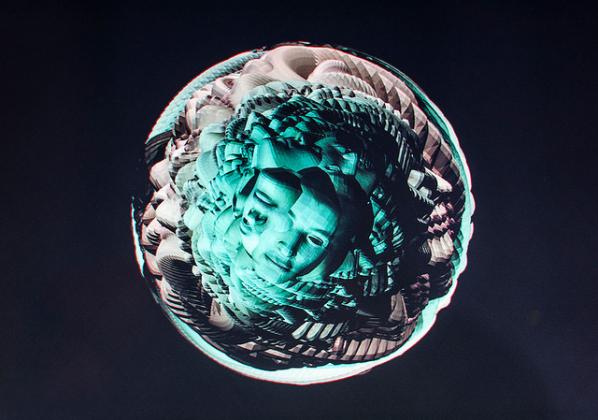
Brout and Marion make their own attempt to summons the mysterious Nakamoto back to life by putting together the evidence of Nakamoto’s existence and procuring a Japanese passport using none other than the technologies that Nakamoto’s Bitcoin both imparted and facilitated. When asked if they feared for their own self-preservation in seeing this project through, Brout and Marion answered, “Yes, even if we were pretty sure that it would be easy to prove our intention to the authorities, and that the fake passport couldn’t be useful to anybody, buying a fake passport is still illegal.” They add, “But we also wanted to play the game entirely, so we made every possible effort to preserve our anonymity during our journey on the darknets.”
However Brout and Marion have yet to receive the passport; as they explain, “The last time we received information, the document was in transit at the Romanian border.” When asked if they expect to receive the passport, they respond, “No, today we think we will never receive it. We are completely sure that it has existed, but we’ll surely never know what happened to it.” What, then, will they do if they never receive the passport? “Maybe just continue to exhibit the only proof of it we have!” they exclaim. “There is something beautiful in it: we tried to create a physical proof of the existence of a contemporary myth, using digital technology and digital money, and the only thing we have is a scan!”
If Brout and Marion’s nonchalance seems unexpected then it is because the disappearance of the passport for the artists marks just another ebb in the overall flow of their piece; a flow that began with Nakamoto, coursed through their clandestine chats via a Tor networked browser and high security email, and now continues to trickle on while we wait in anticipation for the next chapter of the Nakamoto passport to reveal itself. In this respect, the anticipation of the passport is a poetic and unforeseen layer added to the significance of the piece: “Maybe it is even better [that the passport should not arrive]” Brout and Marion comment. “It’s like it was impossible to bring Nakamoto out of the digital world.”
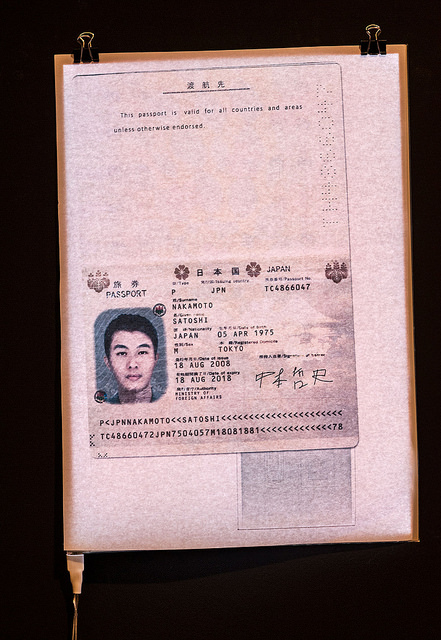
If value is always formed by way of a social relation, then how do digital modes of sociality also deliver this effect? This becomes a particularly fraught question when considering that, as Anna Munster has written, the sociality that takes place on the internet can be understood as the interrelation of any number of subjectivities, both organic and inorganic. Brout and Marion’s ambivalence to the purloined passport highlights just such an expectation: “Here the lack of identity delivers a lot of value. Look at Snowden: journalists ask him more about his girlfriend than about his revelations. Making something as big as Bitcoin and staying perfectly anonymous? These are strong attacks to two of the most important issues of our societies: banks and privacy.” What their statement suggests is how a collective movement towards transgression, here seen as compounding maneuvers of avoidance of physical world boundaries and institutions, might hold within it the promise of its own set of value coordinates. As Brout and Marion further explain: “For us, Nakamoto is absolutely fascinating. The efforts he made to prevent himself from being turned into a product are incredible. Especially when you know the importance of [Bitcoin’s] creation, and that only a few men in the world are smart enough to create something like this. Adding to that the fact that Nakamoto is probably a millionaire, you have one of the only true contemporary myths, something hard to find credible even if it was just a fictional character in a movie. So this somewhat absurd attempt to create a proof of Nakamoto’s existence was, for us, an attempt to make a portrait of him, to put light on his figure. And, in some ways, a tribute.”
Brout and Marion mount a final probe into questions of value in their piece, Untitled SAS. Untitled SAS is the name for Brout and Marion’s corporation whose purpose and medium is to exist as a work of art. In France SAS means société par actions simplifée, and is the Anglophone equivalent of an LTD. SAS companies have shares that can be freely traded between shareholders. Untitled SAS, in Brout and Marion’s own words, “has no other purpose than to be a work of art: it won’t buy or sell anything, there won’t be employees, its existence is an end it itself. The share capital of the company is 1 Euro (the minimum), and we edited 10,000 shares owned by us (5,000 for each one). Everybody can freely buy and sell shares of this company.” Brout and Marion are clear: in no uncertain terms, “Untitled SAS is a work of art where the medium is a real company, and the corporate purpose of this company is simply to be a work of art.”
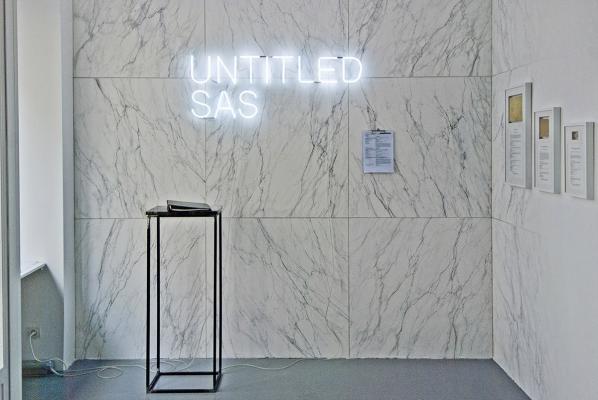
Untitled SAS is a tongue in cheek commentary on the situating of artworks as outside of the rational space of the market while still being subject to selective norms of economic behavior. Brout and Marion explain, “Untitled SASis obviously a metaphor for the art market, and the market in general: it is a true, fully legal, and functional speculation bubble. Companies usually try to create some concrete value, they are means. The art world has fewer rules than the regular market, the price of some artworks can radically change in few days without any logical reason: their intrinsic value is completely uncorrelated to their market value. We wanted to reproduce and play with these systems in the scale of an artwork.” At this level, what Brout and Marion uncover is further proof of the condition of the contemporary art period as Groys sees it: a time in which “mass artistic production [follows] an era of mass art consumption” and by extension “means that today’s artist lives and works primarily among art producers—not among art consumers.”7
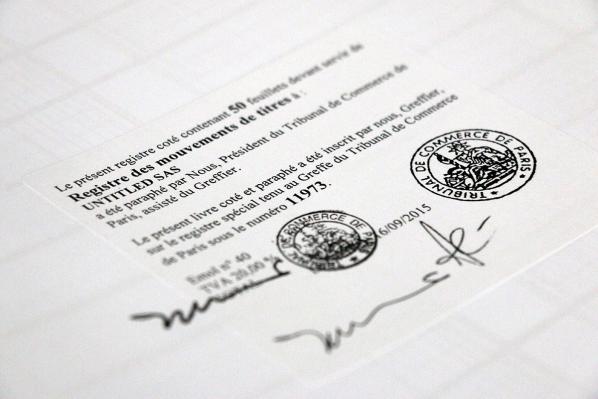
Crucially, the effect of this condition is that contemporary professional artists “investigate and manifest mass art production, not elitist or mass art consumption.” This is the mode of art making precisely employed by Brout and Marion in the creation of Untitled SAS. It has the added effect, too, of creating an artwork that can exist outside the problem of taste and aesthetic attitude. Companies tend to eschew taste qualifications in favor of brand associations. Untitled SAS becomes readable as an artwork, as Untitled SAS, when the expectations and regulations of a nationally recognized business are made to butt up against the inconsistencies of the artworld as an economic sphere. The art object then becomes rather a means of accessing the overlapping paths of art and value as they are uniquely enabled to circulate in and out of the art & Capitalist markets.
* * *
Brout and Marion note that, “In our work we often use algorithms and generative ways to produce things, but here we wanted to something no machine can do, something hand-made, too, finally a simple and traditional work of art.” These kinds of generative technological processes and sorting algorithms have been central to many debates on how contemporary culture is absorbing the boon of big data: from ethical questions on predictive policing to dating apps and ride-hailing startups. As one Slate article posed the question in relation to Uber, these algorithms are more than just quick and efficient modes of labor—they are reflections of the marketplace themselves.
So what, then, might it mean that both values and services in the digital age are predicated on the power to sort and categorize, and that this power is ciphered through its own dynamic of social relations, but that in one scenario what emerges is a sphere of the valuable and in the other a software that asserts itself as benign and at the behest of an impartial, impersonal data? Perhaps the rationality of value and market circulation vis a vis the art object was always going to be a little too tricky to take on: too many exceptions, too many questions of subjectivity, taste, and judgment. But as the works exhibited for The Human Face of Cryptoeconomies might suggest the rationality of value and the products it chooses to incorporate is of high importance. If value works precisely because of the specific interrelating of social subjects then we can consider the realm of the digital as a concentrated form of such a relation.
Against this we must consider the new subject that is produced and addressed by the intersecting of these discussions. Spaulding and Demby make the case that, that “Art under capitalism is a good model of the freedom that posits the subject as an abstract bundle of legal rights assuring formal equality while ignoring a material reality determined by other forms of systematic inequality.”8 Karen Gregory, in The Datalogical Turn, writes, “In the case of personal data, it is not the details of that data or a single digital trail that are important, it is rather the relationship of the emergent attitudes of digital trails en mass that allow for both the broadly sweeping and the particularised modes of affective measure and control. Big data doesn’t care about ‘you’ so much as the bits of seemingly random information that bodies generate or that they leave as a data trail”.
The works of Brout and Marion exhibited at the Human Face of Crypotoeconomies exhibition places the intimacy of the body front and center. They speak to the shadow and trace of the body by appropriating the paths of the faceless, or by giving a face to the man (or entity) without a body, to becoming the human face of the market player par excellence by inserting themselves into a solipsistic art corporation. Brout and Marion’s practice understands that while value may not be an all-penetrating miasma, this is not also to say that the effect of value is not still inscribed on the flesh of each and all, organic or not.
1 Demby, “Art, Value, and the Freedom Fetish | Mute.”
2 Ibid.
3 Greenberg, “Avant-Garde and Kitsch,” 543.
4 Ibid.
5 Ibid.
6 “Who Is Satoshi Nakamoto?”
7 Groys, “Art and Money.”
8 Ibid.